Throughout history, photographs have played a vital role in documenting and preserving our collective past. They have the unique ability to freeze time, capturing the essence of significant events, and providing us with a visual representation of the moments that have shaped the world as we know it. These images have influenced our understanding of history, sparked conversations, and inspired generations.
They convey a story, often with minimal or no accompanying text. These images have the power to evoke emotions, engage our curiosity, and transport us to another time and place. By presenting a snapshot of a particular moment, these photographs can provide insights into the cultural, social, and political contexts of the time, deepening our understanding of the world and its history.
The photographers responsible for capturing these important historical photos deserve recognition and admiration for their dedication and courage. Often, these individuals found themselves in dangerous or challenging situations, yet they persevered, driven by a commitment to document history and share these moments with the world. Their efforts have resulted in a priceless archive of images that continue to inspire and educate.
As we live in an increasingly digital and interconnected world, the importance of preserving and appreciating important historical photos cannot be overstated. These images provide a tangible link to our past, allowing us to connect with and learn from the events and people who have shaped the course of history. They remind us of the power of photography to capture the human spirit and the importance of preserving these moments for future generations.
#1 A Creative Approach to Job Hunting
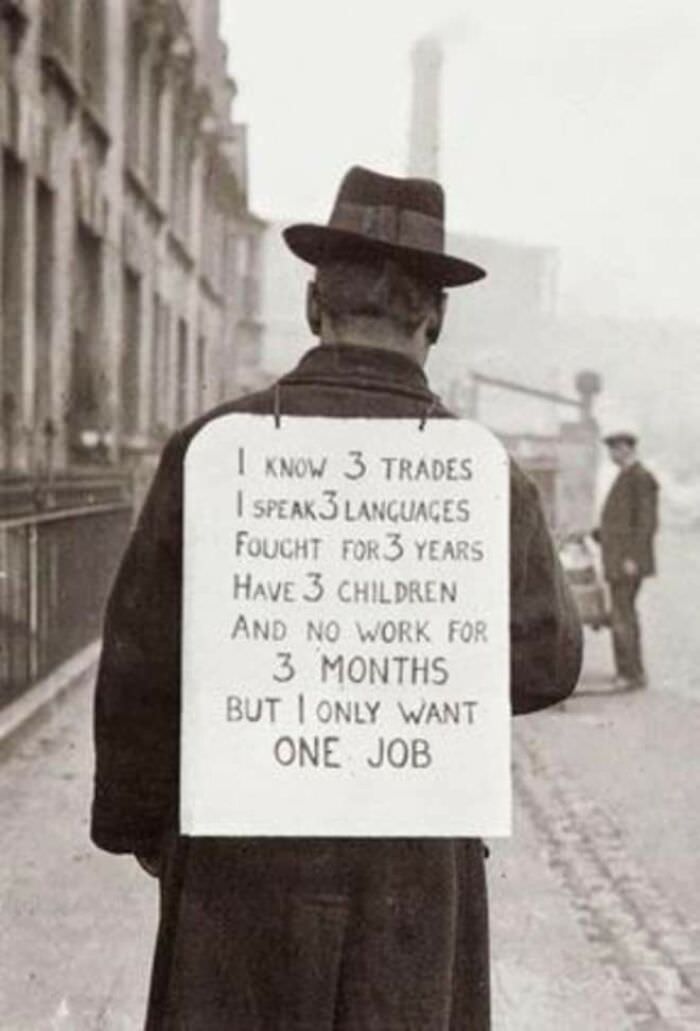
In this photo, a man in England during the 1930s can be seen wearing his CV in an attempt to stand out and catch the attention of potential employers. This creative approach to job hunting shows the desperation that many faced during the Great Depression, where finding work was a struggle for many. The man's bold move to wear his CV as clothing highlights the lengths people would go to in order to secure employment and provide for themselves and their families. Despite the tough economic times, the resilience and creativity of individuals shone through, reminding us that even in the toughest of times, people will find ways to adapt and survive.
#2 The Lost Library of Cincinnati
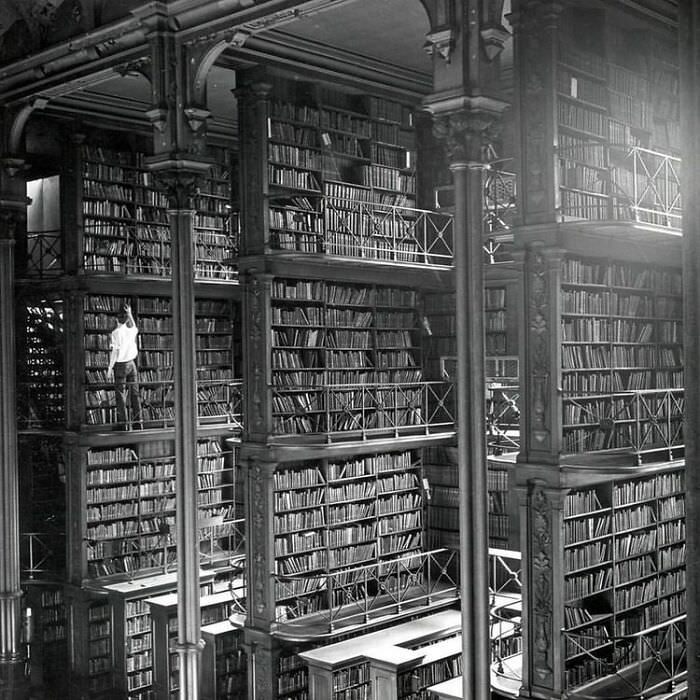
In this photo, taken in an era before digital bookstores, a man can be seen browsing the shelves of the old Public Library of Cincinnati. The building, which was completed in 1874, served as the central library for the Cincinnati Public Library system for over 80 years until it was demolished in 1955. Today, the site of the library is occupied by an office building and a parking lot. The loss of such a beautiful and historic building remains a regrettable moment in the city's history, and a reminder of the importance of preserving architectural landmarks for future generations to enjoy.
#3 Defying Hate
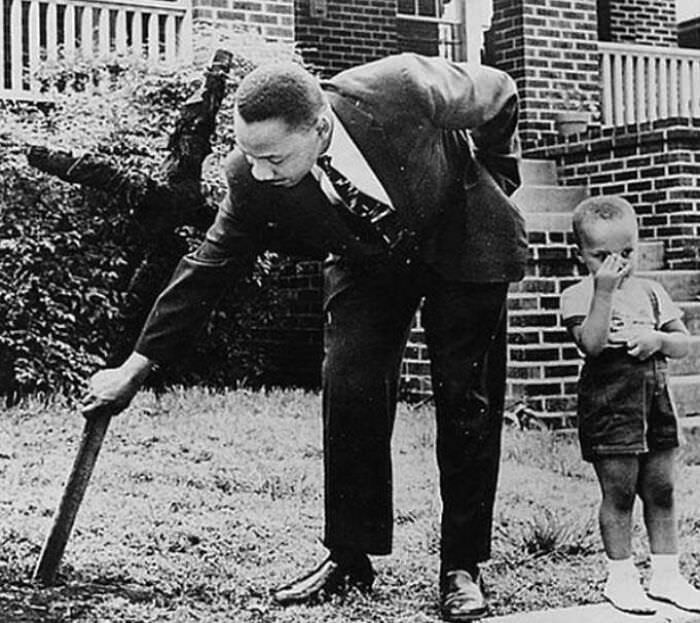
Martin Luther King Jr. was a leader of the Civil Rights Movement, fighting against segregation and racial injustice in America. He was often the target of hate and violence, including having a cross burned in his front yard. In this powerful photo, we see him removing the charred remains of that cross, a symbol of hatred and fear. It shows the strength and resilience of a man who was committed to nonviolence and justice, even in the face of bigotry and violence.
#4 A Portrait of Loss and Resilience
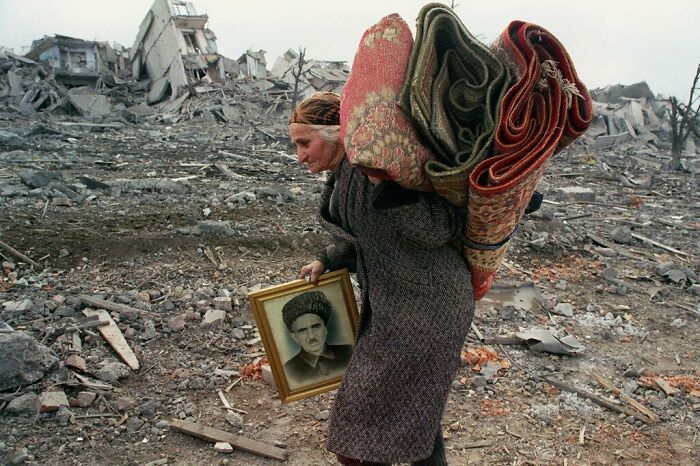
In May 1995, Russian soldiers gave an elderly woman in Grozny just five minutes to pack her bags and leave her home before they destroyed it. With nothing but a portrait of her late husband and some rugs, she left the place she had called home for years, her sons and husband already gone. The photo captures her sense of loss, but also her resilience, as she leaves behind the destruction and moves forward with what little she has left.
#5 The People’s President
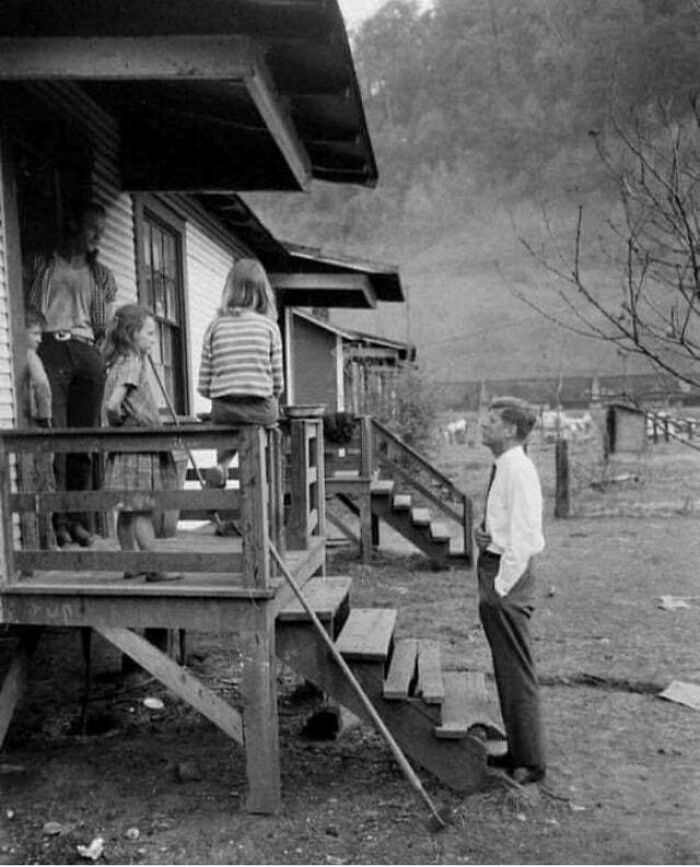
In this photo, we see a young John F. Kennedy campaigning door-to-door in West Virginia during his 1960 presidential campaign. With his sleeves rolled up and a determined look on his face, Kennedy engages with the people he hopes to lead. He was known for his charisma and ability to connect with voters, especially through his famous televised debates with Richard Nixon.
Kennedy's presidency was marked by great accomplishments, such as the creation of the Peace Corps and the signing of the Civil Rights Act. He inspired a generation to get involved in politics and make a difference in their communities. Although his life was tragically cut short, his legacy lives on as a symbol of hope and progress.
#6 A Mother’s Joyful Reunion
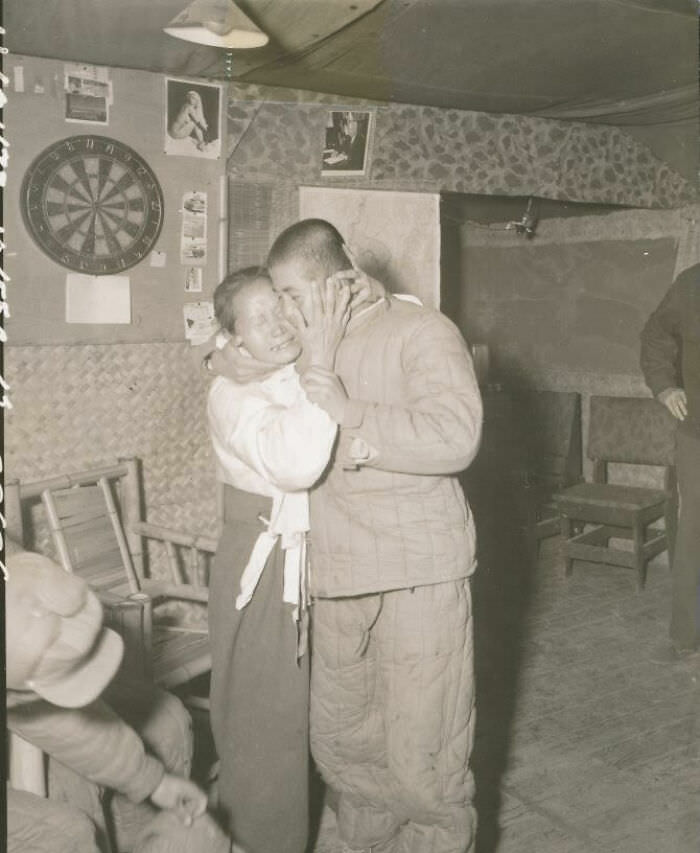
In this powerful photograph taken in 1953, a Korean mother embraces her son who had just escaped from a North Korean prisoner-of-war camp after the signing of the Korean Armistice Agreement. The mother's face is filled with emotion as she clings tightly to her son, her eyes closed in sheer joy at the sight of him.
The Korean War was a devastating conflict that saw families separated and communities torn apart. This image captures the relief and happiness felt by a mother at being reunited with her son after a long and difficult period of uncertainty.
#7 The Stoic Warrior
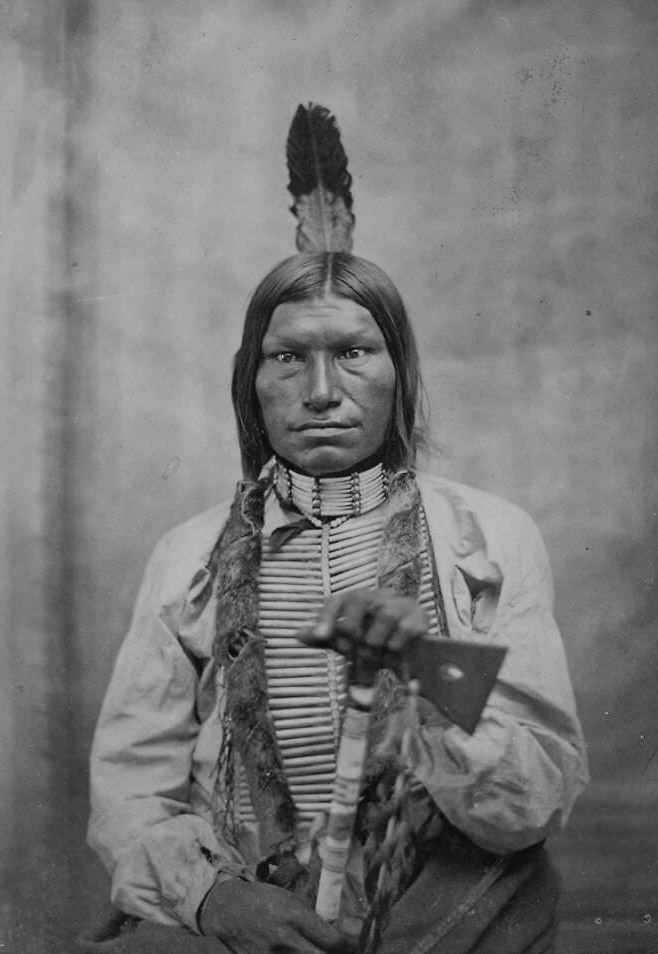
Chief Low Dog was a brave and stoic Oglala Lakota chief who fought alongside Sitting Bull at the Battle of Little Bighorn. This photo, taken around 1881, captures the essence of his character, with his piercing gaze and stern expression. Low Dog was one of the few Lakota leaders who resisted the encroachment of the United States on their land, and he fought fiercely to preserve his people's way of life. In this photo, he wears traditional garb and carries a rifle, symbolizing his readiness for battle.
#8 The Last Queen Consort of Mongolia
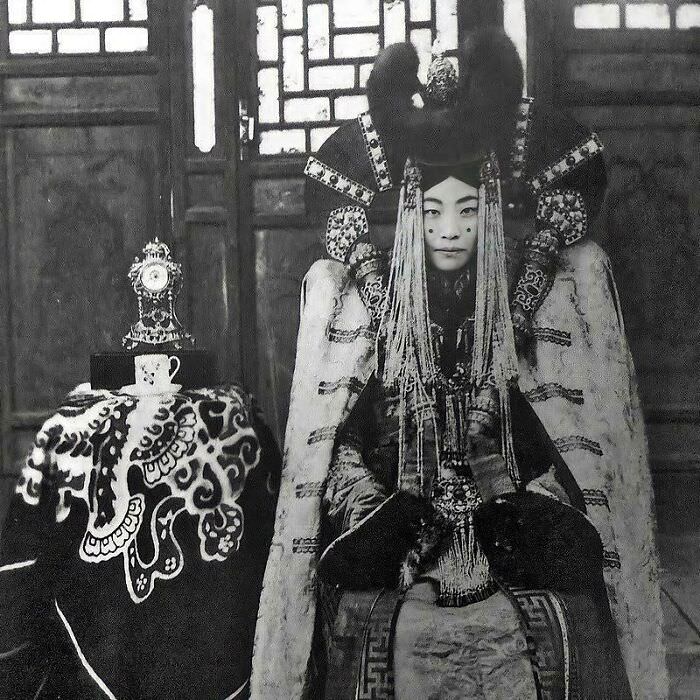
In this historic photo, we see Genepil, the last queen consort of Mongolia. She was married to the Bogd Khan, the ruler of Mongolia until the monarchy was abolished in 1924. The photograph was taken on January 1st, 1923, shortly after their marriage.
Genepil was highly regarded in Mongolia, known for her intelligence and beauty. However, her life was cut short during the Stalinist purges in May 1938, where she was killed. Her death marked the end of an era in Mongolian history, and this photo serves as a reminder of the country's rich cultural heritage and the role of its monarchs in shaping its destiny.
#9 Building the Icon: Eiffel Tower Construction in 1888
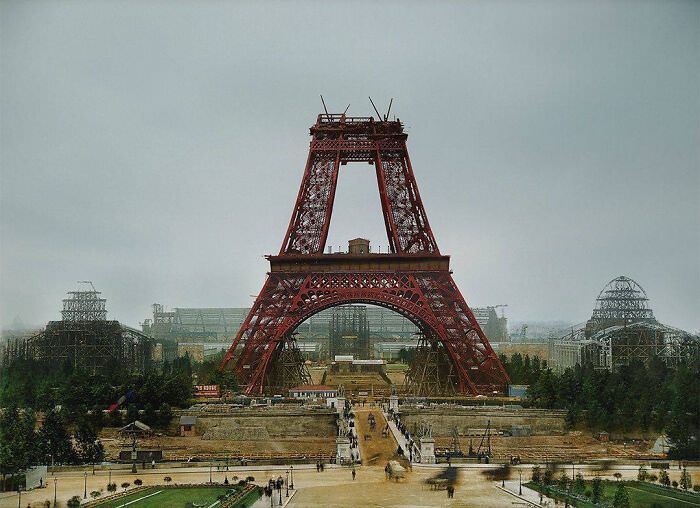
In this captivating photo, we see the iconic Eiffel Tower under construction in July 1888. The Eiffel Tower was designed by Gustave Eiffel for the 1889 World’s Fair in Paris and was initially met with controversy and skepticism. However, as the tower began to take shape, it quickly became a symbol of French engineering and innovation.
The photo shows workers scaling the metal beams, carefully piecing together the intricate design that would ultimately become one of the most recognizable landmarks in the world. It’s incredible to see the scale of the tower, even in its early stages, towering over the city of Paris. Today, the Eiffel Tower remains one of the most visited attractions in the world, a testament to the skill and vision of the engineers and workers who built it over a century ago.
#10 Sleeping in the Fresh Air
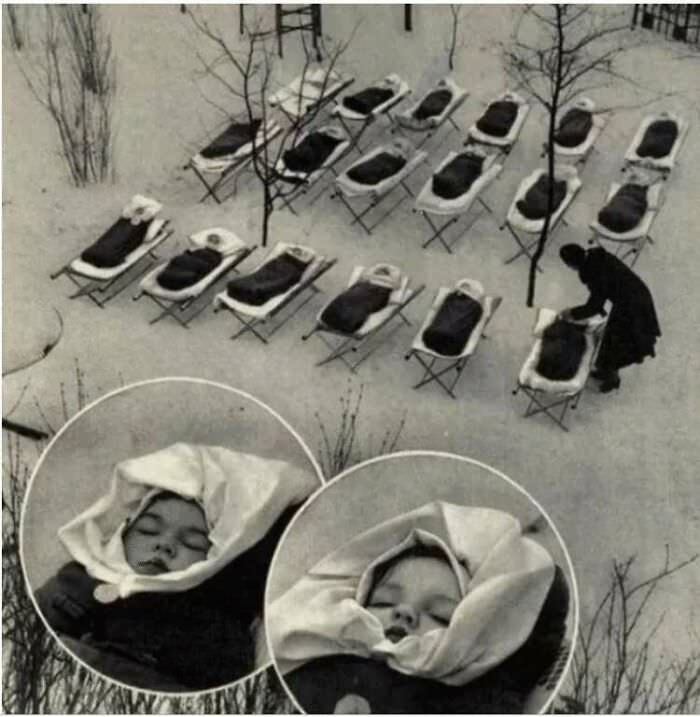
In 1950s Moscow, it was common practice for babies to be left outside to sleep, even during the winter months. The belief was that the fresh air would help strengthen their immune systems and prevent illness. This photo, taken in 1958, shows rows of babies sleeping outside a Moscow maternity hospital. They are bundled up in blankets and hats to keep warm, but otherwise exposed to the elements. This practice was not unique to Moscow, as similar customs were seen in other parts of the world, including in Scandinavian countries. Today, we understand more about the importance of proper sleep conditions for infants, but this photo is a reminder of the different ways in which cultures have approached child-rearing over the years.
#11 The End of a Grueling Shift
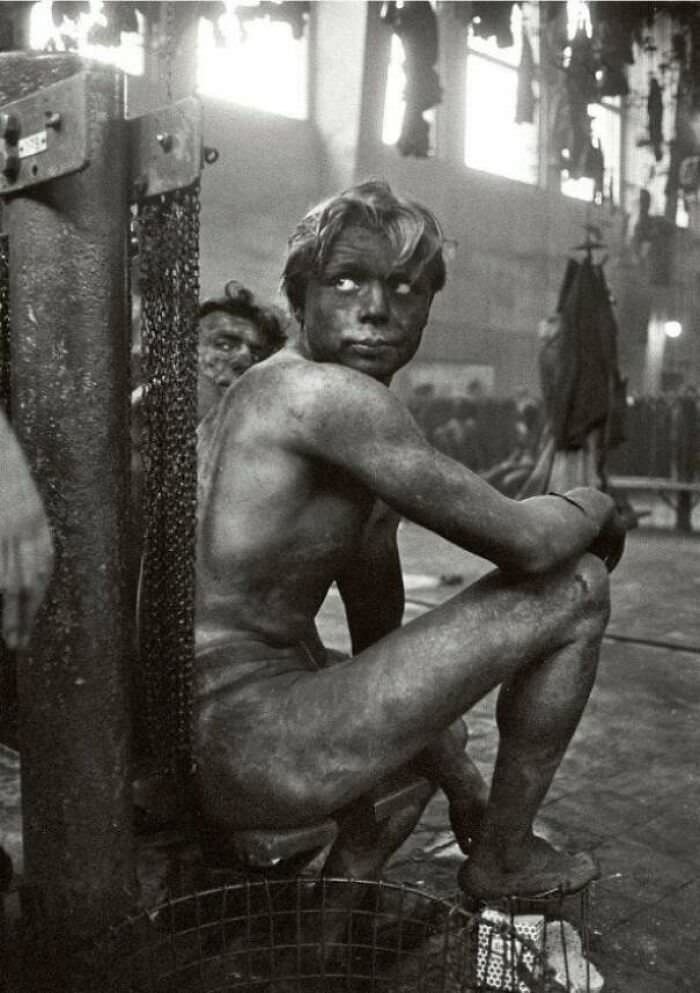
This powerful photograph captures the physical toll of coal mining in Gelsenkirchen, Germany in 1958. The exhausted coal miner, covered in dirt and grime, waits in line to take a communal shower after a long day's work in the mines. His body language speaks volumes, conveying the fatigue and weariness that come with this dangerous and grueling job. Despite the hardship, miners like him were the backbone of the German economy, and their labor provided the energy that powered the country's industrial revolution.
#12 Legacy of Resistance: Frederick and Joseph Douglass
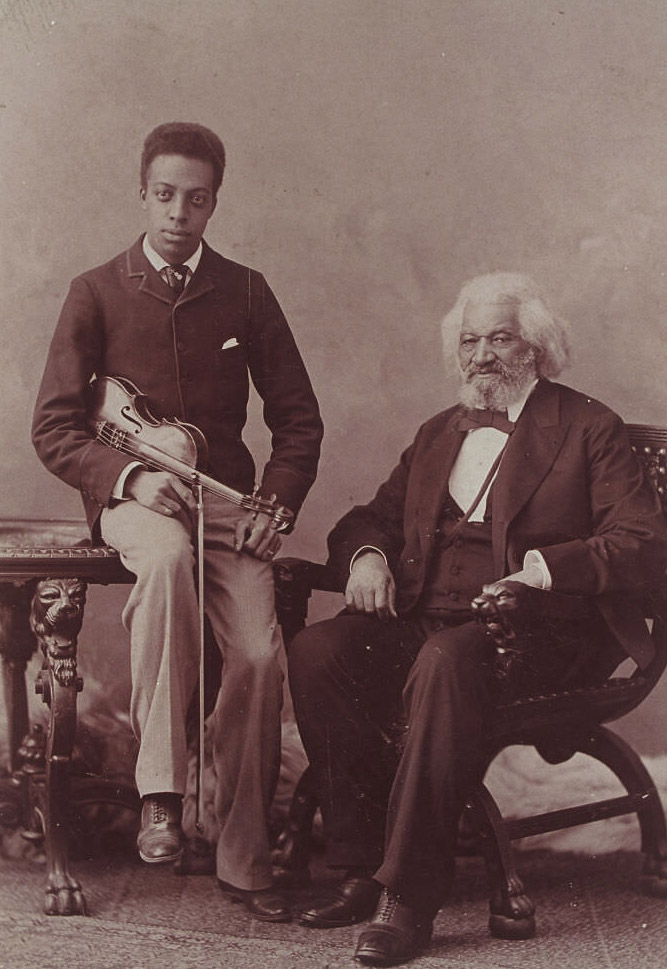
In this rare photograph, we see abolitionist and statesman Frederick Douglass posing with his musician grandson Joseph Douglass. Despite the nearly five-decade age gap between them, the two men were united by their dedication to fighting against racism and injustice.
Frederick Douglass was a former slave who became one of the most prominent African American leaders of the 19th century. He used his eloquence and intellect to advocate for the abolition of slavery and the rights of all marginalized people. Meanwhile, Joseph Douglass was a talented musician who used his art to express his own resistance against racial oppression.
#13 The Young Newsboy of Tampa
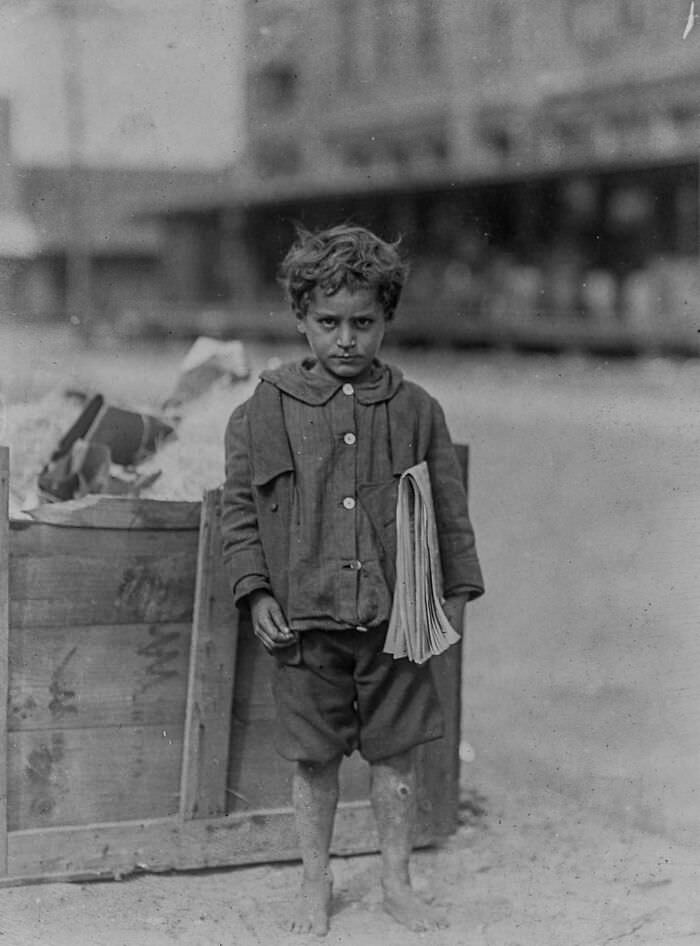
In 1913, the streets of Tampa, Florida were filled with young newsboys like this one, determined to earn a living selling newspapers. This particular newsboy, just four years old, was already a regular seller, braving the heat and the crowds to make a few cents each day. While it may seem shocking to see a child so young working, it was a common sight at the time, as many families relied on their children to contribute to the household income.
#14 The Jungle’s Bite
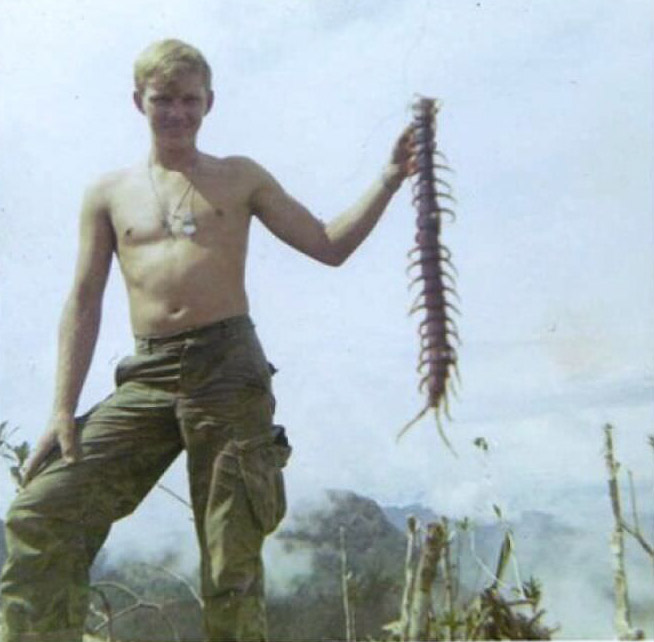
In this photo taken during the Vietnam War, a US soldier can be seen holding up a large jungle centipede. The soldier's face reveals a mix of fascination and disgust at the creature, which was a common inhabitant of the dense forests and jungles of Vietnam. The centipede's poisonous bite could cause severe pain and swelling, making encounters with them particularly dangerous for soldiers. This image captures not only the natural hazards that soldiers faced during the war but also the resilience and adaptability they had to display in order to survive in such a hostile environment.
#15 Migrant Mother’s Identity Revealed
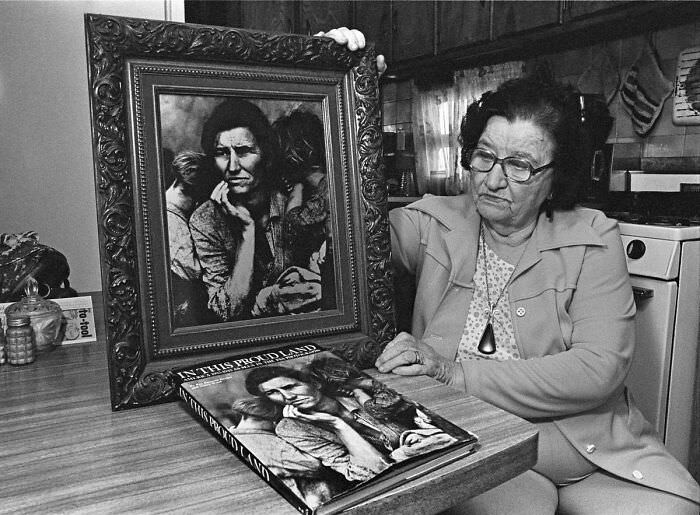
Florence Thompson was the woman captured in Dorothea Lange's iconic photograph, "Migrant Mother," taken during the Great Depression in 1936. For decades, Thompson's identity was unknown, but in 1978 a reporter from a local newspaper in California tracked her down and interviewed her. During the interview, Thompson held up a copy of the photograph and shared her story of struggle and poverty during the Depression. She had worked as a pea picker and had several children to support. The photograph had become a symbol of the hardship and suffering experienced by millions of Americans during that time. Thompson passed away a few years later, but her image lives on as a powerful reminder of the resilience of the human spirit.
#16 Billy the Kid and His Gang Playing Cards
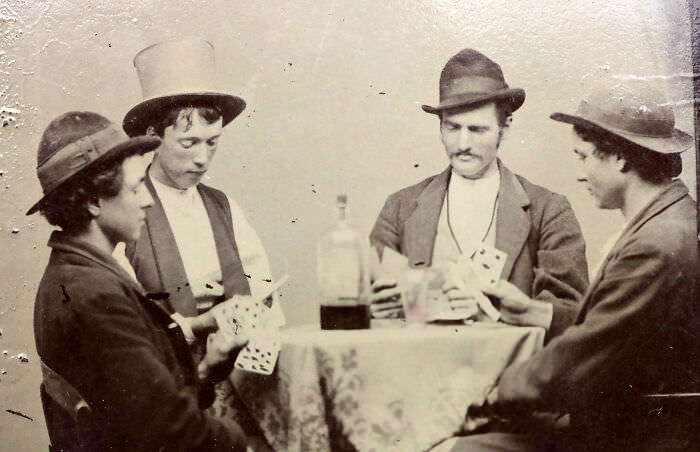
In 1877, Billy the Kid was a notorious outlaw and member of a gang in New Mexico. This photograph, one of only two certified photographs of him, shows him with his gang playing cards. Billy, easily recognizable in his top hat, appears relaxed and at ease with his fellow outlaws. It is fascinating to see such a clear image of a figure who has become shrouded in myth and legend over time. The photograph offers a glimpse into the everyday life of a notorious outlaw, and shows the human side of someone who is often only known for his crimes.
#17 The Guards of Delhi Darbar with James H. Hare
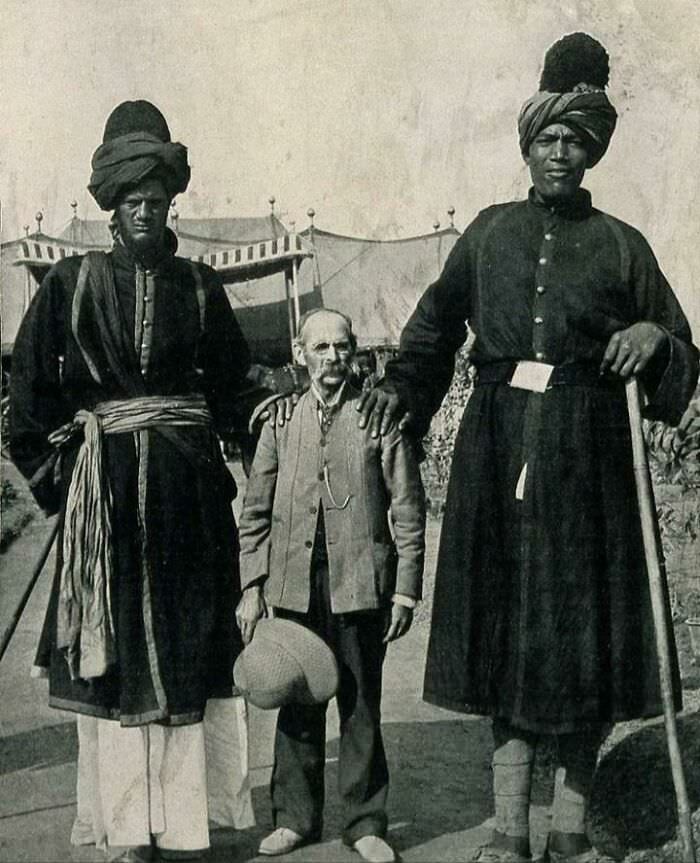
In 1903, American photographer James H. Hare visited India and captured a stunning photo of the guards of Delhi Darbar. The image showcases the soldiers, dressed in their traditional attire, standing tall and proud, holding their weapons with a sense of duty and honor. Hare, who was known for his images of India, was able to capture the essence of the country's rich history and culture.
The guards of Delhi Darbar were responsible for protecting the Mughal emperor and his court during the days of the Mughal Empire. The Delhi Darbar was a grand gathering of the rulers of India, held to showcase the power and prestige of the Mughal Empire. Hare's photograph serves as a reminder of the importance of India's history and the role of the guards in preserving it.
#18 The Mighty Theodosian Walls of Constantinople
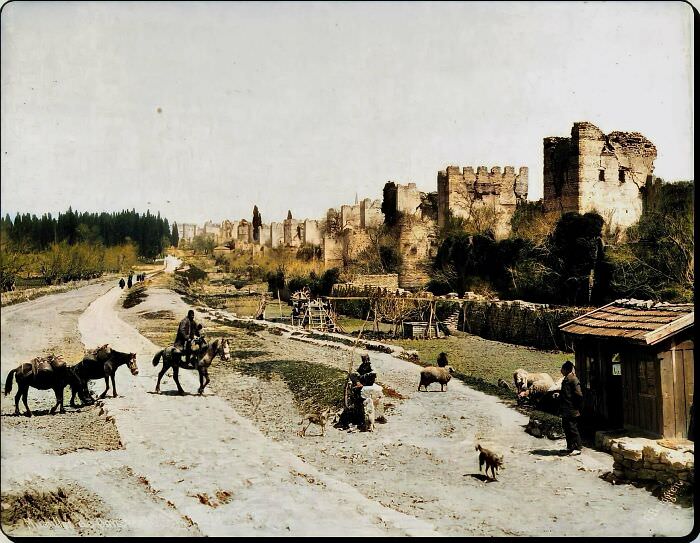
The Theodosian Walls of Constantinople, also known as the Walls of Constantinople, were a series of defensive walls that surrounded the city of Constantinople (modern-day Istanbul) in Turkey. Built in the early 5th century under the direction of Emperor Theodosius II, the walls were designed to protect the city from invasion and were considered virtually impenetrable.
This photograph, taken in 1870 during the Ottoman Empire, showcases the grandeur and magnitude of the walls. The walls stood at over 13 meters tall and 5 meters thick, and were equipped with a series of towers and gates. They had successfully protected Constantinople from many attacks, including multiple sieges by the Avars, Persians, and Arabs.
Today, much of the Theodosian Walls still stand, and are considered one of the greatest examples of fortification in the world. They were declared a UNESCO World Heritage site in 1985, and continue to be a popular attraction for tourists visiting Istanbul.
#19 The Tragic Consequence of Man’s Greed
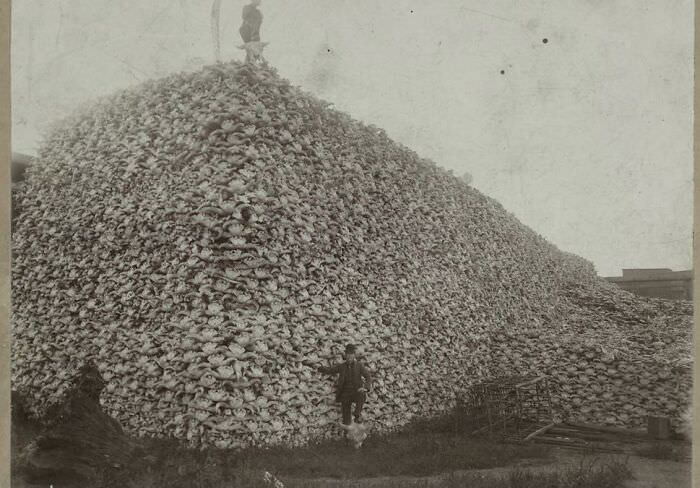
In the late 1800s, the North American bison population was rapidly declining due to over-hunting and the expansion of the American frontier. In 1892, a photographer captured an image of a mountain of buffalo skulls, which serves as a haunting reminder of the tragic consequences of man's greed. The image shows the scale of the devastation that had been wrought upon the once-mighty buffalo population, which numbered in the millions before being hunted to near extinction. The mountain of skulls is a stark reminder of the need to preserve and protect our natural resources before it's too late.
#20 The Tragic Encounter
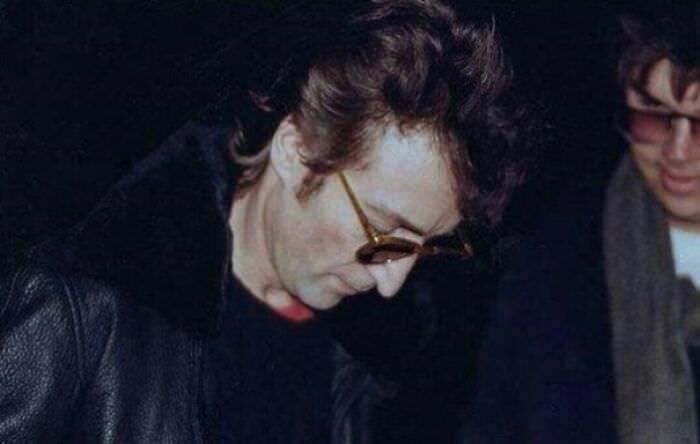
On December 8th, 1980, John Lennon was shot and killed outside of his apartment building in New York City by Mark David Chapman, a troubled fan who had earlier in the day gotten Lennon to sign a copy of his album, Double Fantasy. The photo captured by a bystander shows Lennon signing the album for Chapman, unaware of the events that would unfold later that day. The tragic encounter serves as a haunting reminder of the dangers of fame and obsession. Lennon's death sent shockwaves through the music industry and beyond, leaving fans around the world mourning the loss of a beloved icon.
#21 The Face of Labor: A Textile Worker’s Struggle
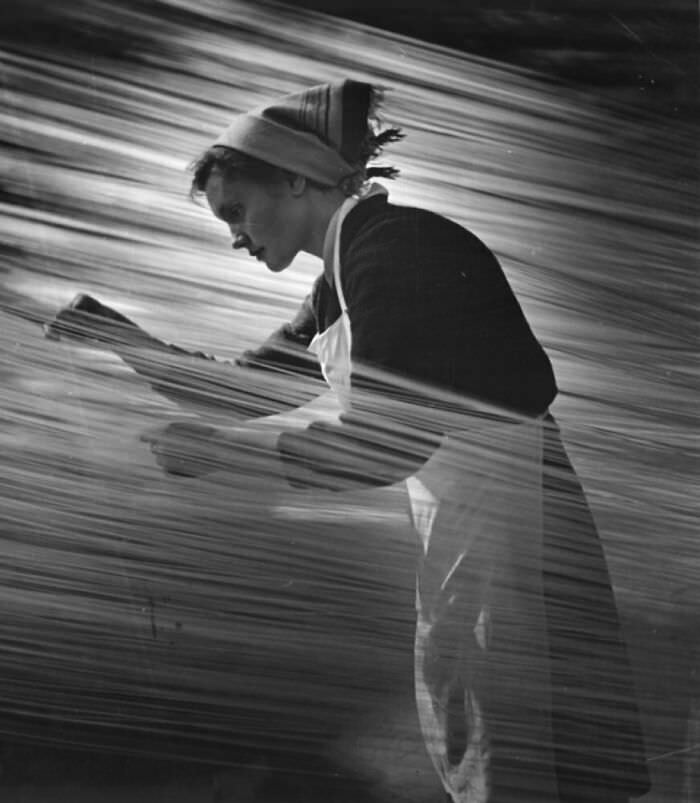
In this striking photograph captured by Nikolay Matorin, we see the face of a Soviet textile worker, capturing the struggles of labor during the Soviet era. With a blank stare and tired eyes, the worker is a symbol of the hardships and sacrifices that many laborers faced in the name of industrial progress. The Soviet Union invested heavily in the textile industry, and this worker's labor played a vital role in the economy. However, as we see in the photograph, the cost of that labor was often personal and physical exhaustion. The worker's face is a testament to the human toll of industrialization, and a reminder of the importance of recognizing and respecting the contributions of the working class.
#22 Efunroye Tinubu – Female Nigerian Slave Trader
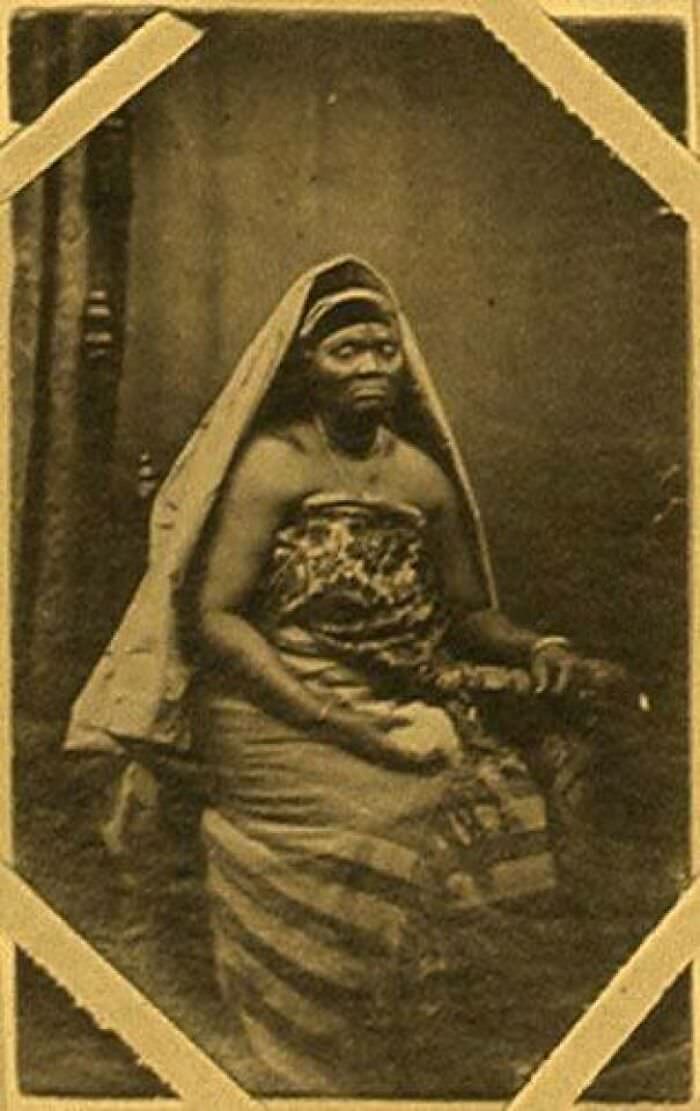
In the late 19th century, Efunroye Tinubu was a powerful female Nigerian slave trader who rose to prominence in the slave trade of West Africa. Known for her intelligence and shrewdness, she became one of the wealthiest women in Lagos and amassed a large number of slaves whom she sold across the region.
Despite her involvement in the slave trade, Efunroye Tinubu was also known for her philanthropy and the support she provided to the Yoruba community. She helped to fund schools and hospitals, and even provided loans to women entrepreneurs.
#23 A Logging Family with a 1300-Year-Old Tree
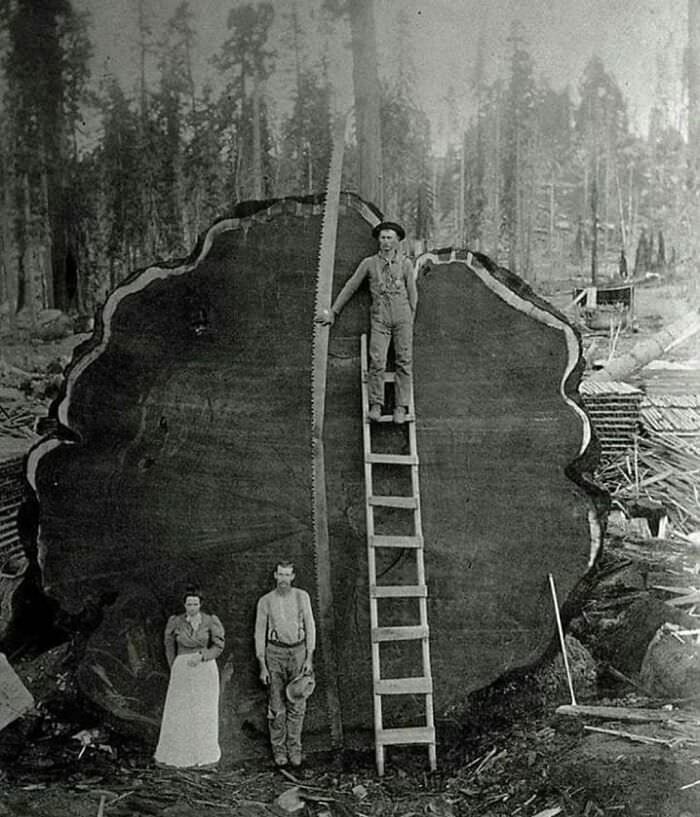
In 1892, a logging family posed for a photograph with a massive redwood tree in California that they had just felled. The tree was estimated to be over 1,300 years old, and its trunk was so wide that it took the entire family, standing with outstretched arms, to surround it. The photo is a stark reminder of the impact of the logging industry on America's forests in the late 19th century.
The logging of old-growth redwoods in California had become a major industry by the late 1800s, with trees being cut down at an alarming rate for use in construction and other industries. This photograph captures both the pride and devastation of the logging family, who likely saw their work as necessary to support their livelihood but were also contributing to the destruction of a natural wonder.
#24 Stalin’s Imprisonment in Baku
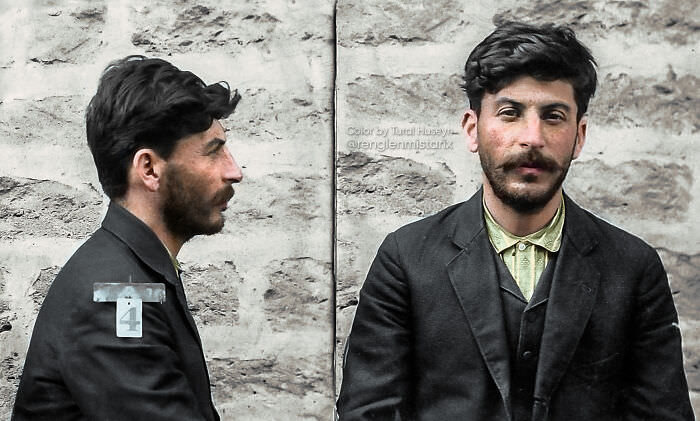
In March 1910, Joseph Stalin was imprisoned in the Bailov Prison in Baku, Azerbaijan for revolutionary activity. This photo captures Stalin sitting in his cell with fellow prisoners visible in the background. Stalin had been exiled to Siberia twice before this imprisonment and was known for his involvement in the Bolshevik movement. It was during his time in prison that Stalin began to emerge as a leader, organizing prisoners and advocating for their rights. His time in prison helped to solidify his political beliefs and tactics, which he would later employ during his rise to power as the leader of the Soviet Union.
#25 Dangerous Playthings

In the 1970s, it was not uncommon for British schoolboys to play with discarded syringes, as they were viewed as mini water pistols. The photograph captures a group of boys holding up the syringes, unaware of the potential danger they posed. Syringes used by drug addicts, who would often share needles, were a common sight on the streets of the UK during the 1970s. However, the reuse of needles and lack of hygiene associated with drug use led to the spread of diseases such as HIV and hepatitis C. The photograph serves as a stark reminder of the dangers of playing with items that may appear harmless, but could have deadly consequences.
#26 Protecting the Littlest Ones
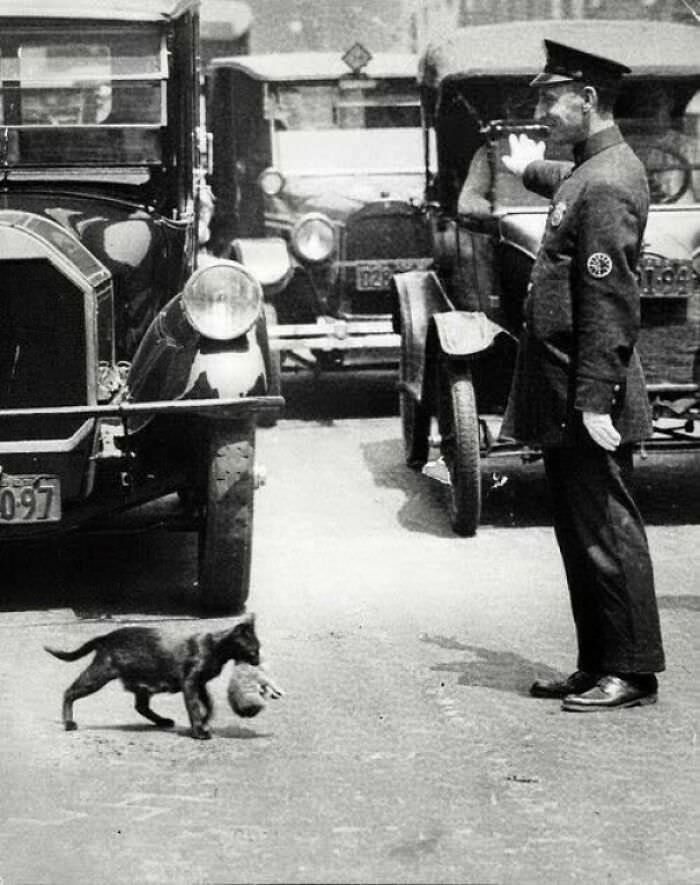
In this heartwarming photo from around 1925, a New York City police officer stops traffic to allow a mother cat to cross the street safely with her kitten in tow. The image captures a moment of kindness and compassion in a bustling city where such gestures might have been rare.
At the time, New York City was home to many stray cats, and their welfare was not always a priority. But in this instance, the police officer saw the need to protect the mother cat and her kitten from the dangers of the busy street. As the photo shows, the officer stands in the middle of the road, holding up his hand to stop the flow of traffic. Meanwhile, the mother cat calmly makes her way across the street, with her kitten close behind.
#27 Behind the Lens: Charles Ebbets Captures Iconic Empire State Building Image
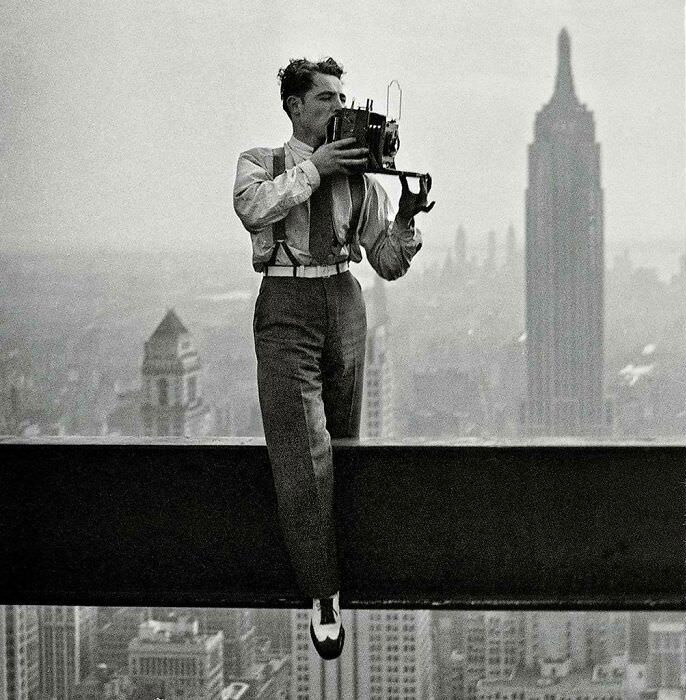
Charles C. Ebbets was an American photographer who is best known for his work documenting the construction of the Empire State Building. The iconic photograph of construction workers having lunch on a steel beam high above New York City was taken by Ebbets on September 20th, 1932. The image became an instant classic and is still widely recognized today as a symbol of the building's construction and the hard work and bravery of the workers who built it. In this photo, we see Ebbets himself, the man behind the camera, capturing one of the most memorable images of American history.
#28 A Glimpse into Indigenous Family Life
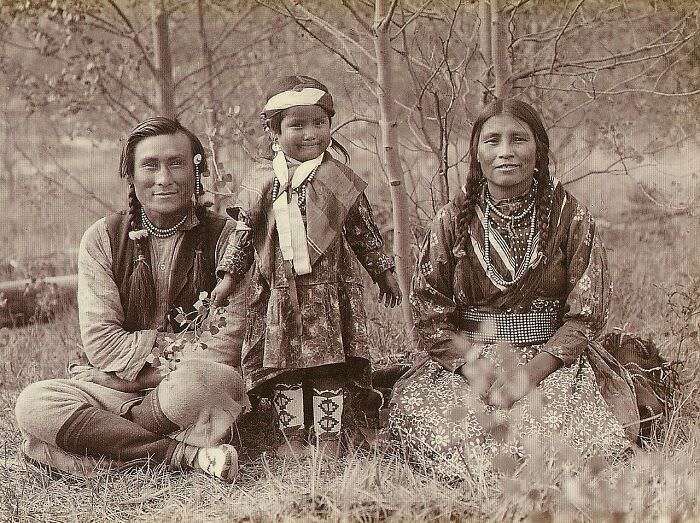
In 1907, Mary Schäffer was one of the first non-Indigenous people to venture into the Rocky Mountains and photograph the Indigenous communities living there. One of her subjects was Samson Beaver, a guide from the Stoney First Nation, his wife Leah, and their daughter Frances Louise. Schäffer’s photos provide a rare glimpse into the daily lives of Indigenous families during that time. Samson Beaver was known for his hunting and guiding skills, and his family would often accompany him on his journeys. The photo captures the Beavers’ traditional clothing and way of life, a testament to the rich and vibrant culture of the Stoney First Nation.
#29 Compassion in Chaos
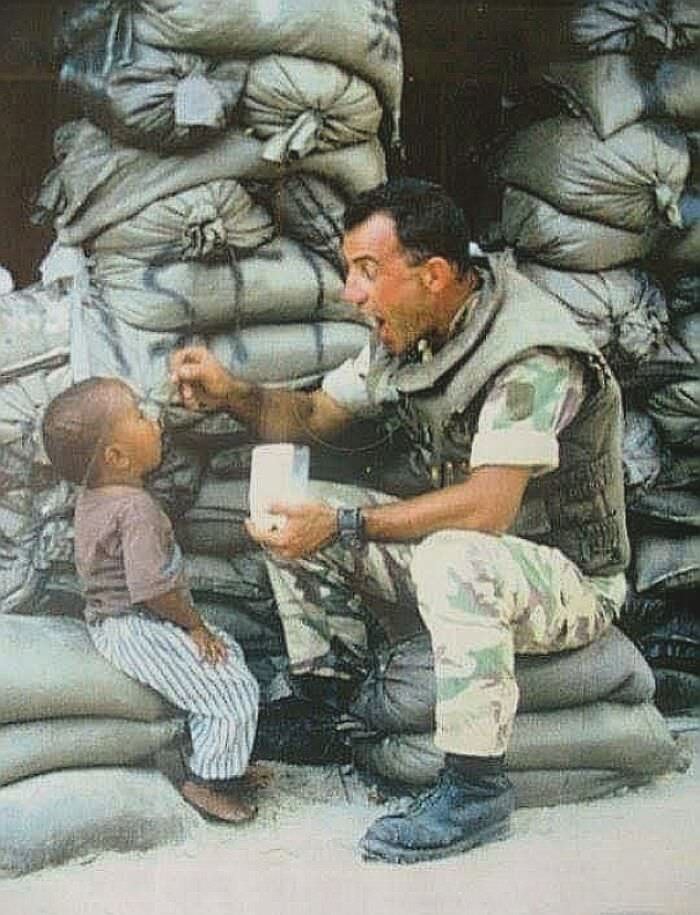
The photo captured by Paolo Pellegrin shows a moment of compassion amidst the chaos of war. In the midst of the 1993 Battle of Mogadishu, an Italian soldier can be seen giving food to a local orphan in need. The conflict in Somalia was raging and the Italian soldiers were part of the United Nations peacekeeping forces there to provide aid and stability.
In the photo, the soldier's expression is one of care and empathy, a stark contrast to the violence and destruction surrounding them. It serves as a reminder that even in times of war, there are moments of humanity and kindness that can be found. This act of kindness may have been just one small gesture, but for the orphan receiving the food, it meant the world.
#30 Women on the Streets of Kabul
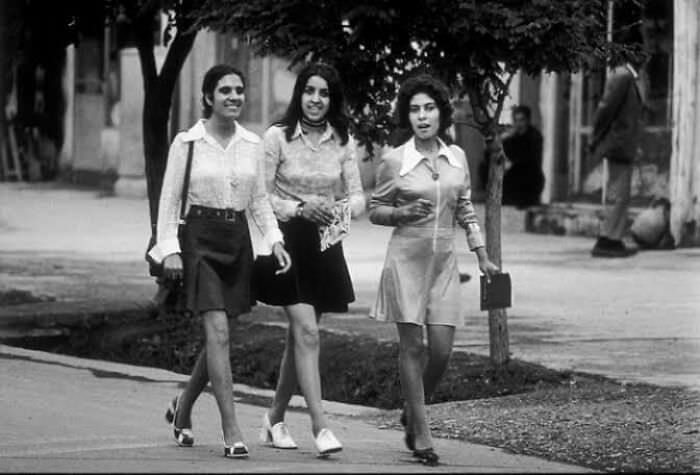
This iconic photo captured three women on the streets of Kabul, Afghanistan in 1972, just a few years before the Soviet invasion and the rise of the Taliban. At the time, Afghanistan was a relatively liberal and modern society, with women enjoying greater freedoms and participating in public life. The women in the photo are dressed in Western clothing and appear to be walking confidently and independently. However, the photo takes on a haunting significance in light of the subsequent Taliban regime, which severely restricted women's rights and freedoms. The photo serves as a reminder of a time when Afghanistan was a different place, and of the struggles and resilience of Afghan women over the years.
#31 A Ray of Sunlight in the Hustle and Bustle
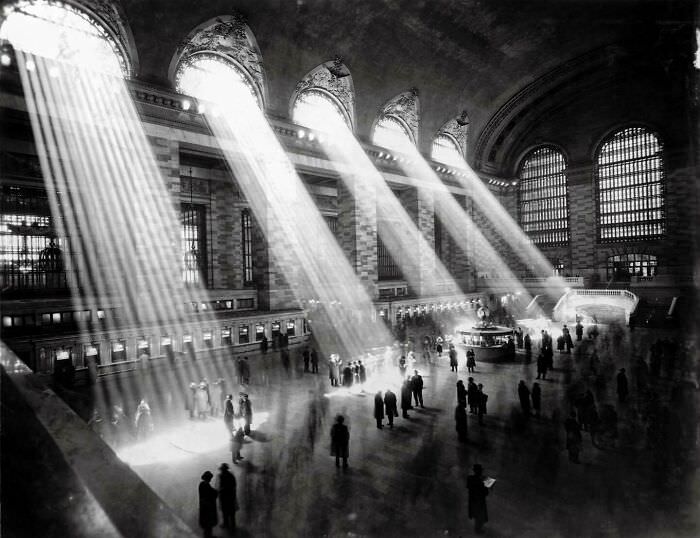
In the midst of the hustle and bustle of Grand Central Station in 1929, Louis Faure captures a fleeting moment of a ray of sunlight illuminating the main concourse. The light shines through the windows high above, highlighting the architectural beauty of the terminal. The scene is reminiscent of a theatrical performance, with the commuters acting as the performers and the sunlight as the spotlight. Today, the view from the windows is blocked by tall buildings, making it impossible to see the same sight. However, this photograph serves as a reminder of the timeless charm of the station and the beauty that can be found in the most unexpected moments.
#32 Mother and Son, 1947
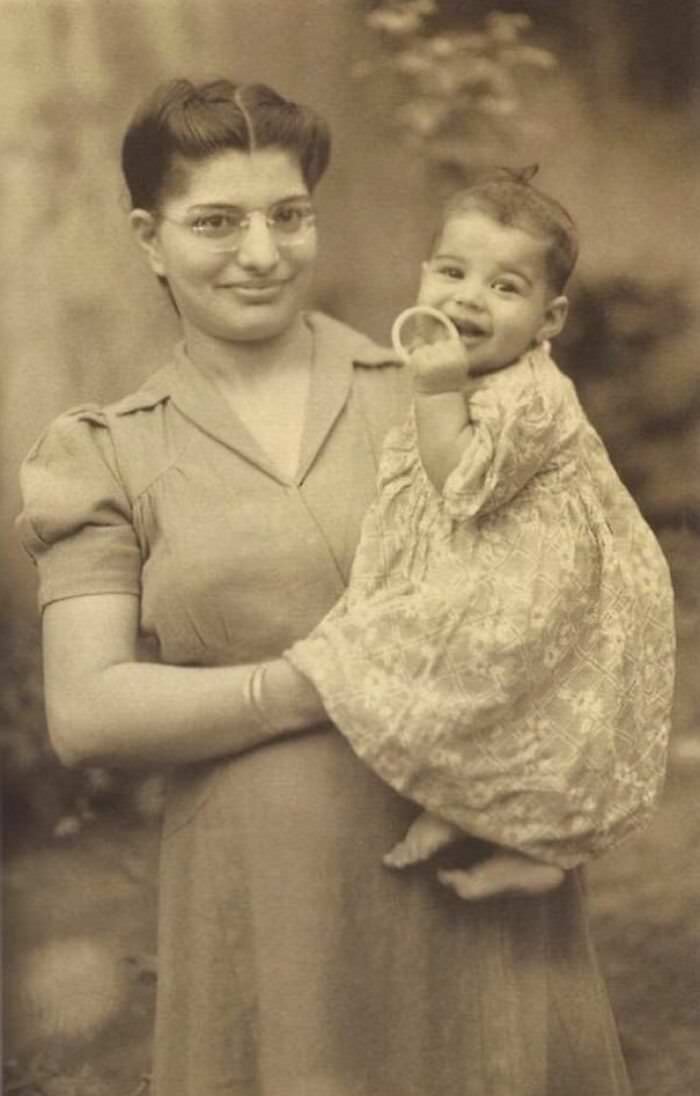
In this tender and intimate moment, we see Freddie Mercury, the legendary frontman of Queen, with his mother Jer Bulsara in Zanzibar in 1947. At this point, Freddie was just a young child, but the love between mother and son is palpable in the photograph. Jer was a huge influence on Freddie throughout his life, and he would later write the song "Bohemian Rhapsody" as a tribute to her. The photo captures a quiet moment of maternal affection that speaks volumes about their relationship. Even as Freddie achieved global fame and fortune, he remained close to his mother, and she was with him in his final moments.
#33 Meeting of Cultures
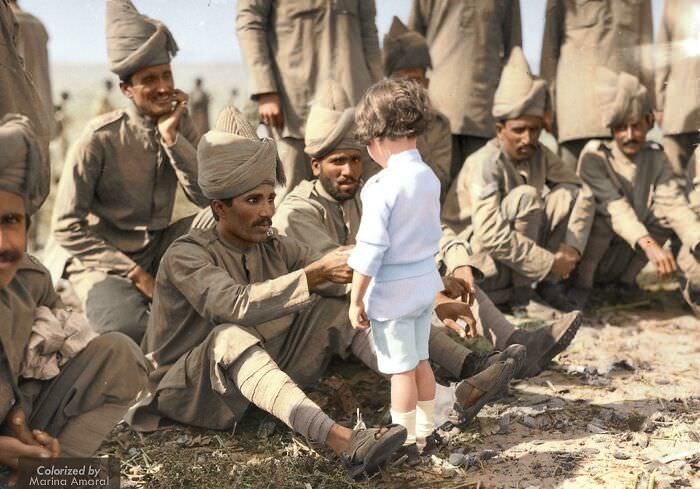
In 1914, Indian soldiers arrived in France to join forces with the French and British soldiers in World War I. This photograph captures a moment of cultural exchange between one of the French boys and the Indian soldiers. The boy curiously looks on as the soldiers introduce themselves, showcasing the meeting of two different cultures brought together by the ravages of war.
The Indian soldiers, who hailed from a colony of the British Empire, had come to the aid of the Allied forces, and were instrumental in many battles on the Western Front. The photo reminds us that amidst the chaos of war, moments of humanity and connection can still be found.
#34 Crossing Borders
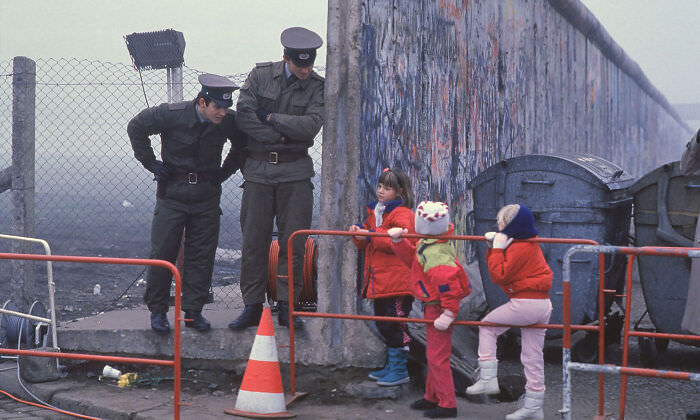
In November 1989, the Berlin Wall was crumbling, and tensions between East and West Germany were high. This photo captured a rare moment of connection between West German school children and East German border guards, as they paused to talk beside an opening in the wall. The fall of communism in East Germany was a monumental moment in history, and the sight of East and West Germans conversing and crossing borders was a powerful symbol of unity and hope for the future. This photograph, taken by Stephen Jaffe, serves as a reminder of the human connections that can be forged even in the most difficult of times.
#35 The Watchers of Nixon’s Resignation
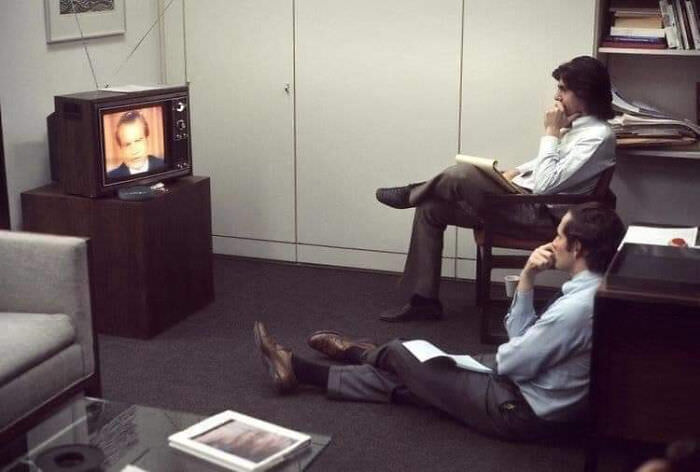
The photo captures the solemn moment when the reporters who uncovered the Watergate scandal, Bob Woodward and Carl Bernstein, along with their editor, Ben Bradlee, watch President Nixon resign in 1974. The scandal began with a break-in at the Democratic National Committee headquarters in the Watergate complex in 1972, which was eventually traced back to members of Nixon's administration. The journalists worked tirelessly to uncover the corruption and wrongdoing of the administration, leading to the eventual resignation of Nixon
#36 Desperate Times
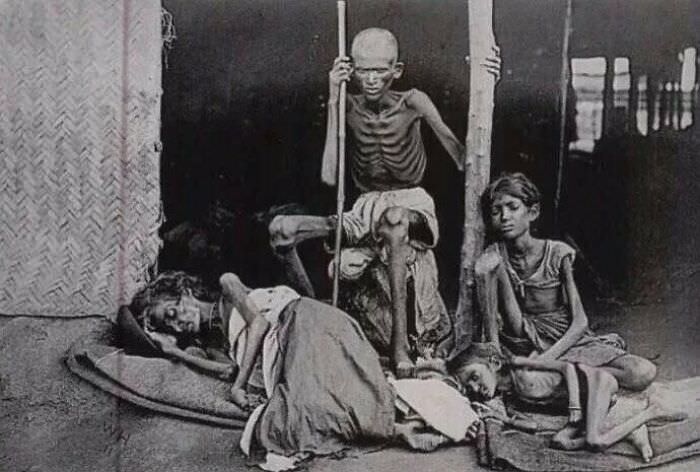
This historic photo captures the grim reality of the Madras Famine of 1877 in India during the British Raj. The famine was caused by a combination of factors, including drought and the failure of the monsoon, leading to the death of millions. In this photo, a man can be seen fiercely guarding his family from the threat of cannibals, a sad indication of the desperate measures people were forced to take to survive.
#37 Capturing Memories in the 1950s
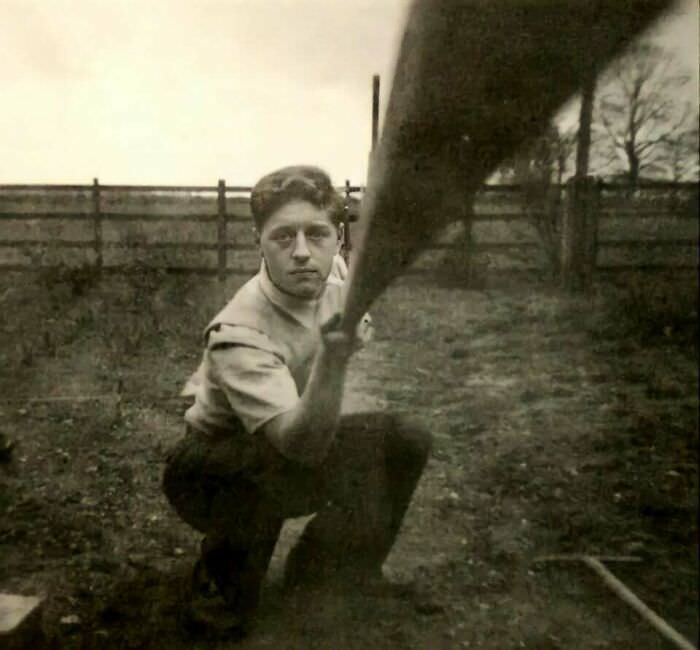
In 1957, before the age of smartphones and selfie sticks, a man found a way to take a selfie using a stick of wood to activate the camera. This photo captures a moment of ingenuity and resourcefulness, as well as a desire to capture and preserve memories.
During this time period, photography was not as accessible as it is today. Film and developing were expensive, and cameras were not as readily available. However, people still wanted to document their lives and experiences. This man's creative solution shows that even without modern technology, people found ways to capture the moments that mattered to them.
#38 Smokey the Canine Soldier
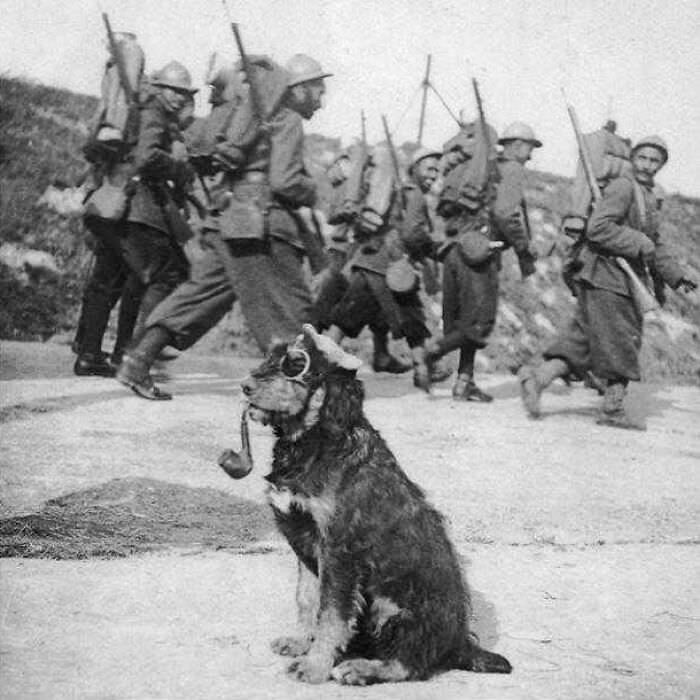
In the midst of World War I, French soldiers encountered an unusual character in the form of a dog named Smokey. The picture shows Smokey wearing goggles and smoking a pipe, which undoubtedly attracted the attention of the soldiers passing by. Although it is unclear why Smokey was wearing goggles or how he started smoking a pipe, it is clear that he provided some lightheartedness and joy amidst the harsh realities of war. It is also possible that the soldiers may have found Smokey to be a good luck charm, as dogs have often been associated with loyalty, protection, and courage.
#39 The Scopes Monkey Trial
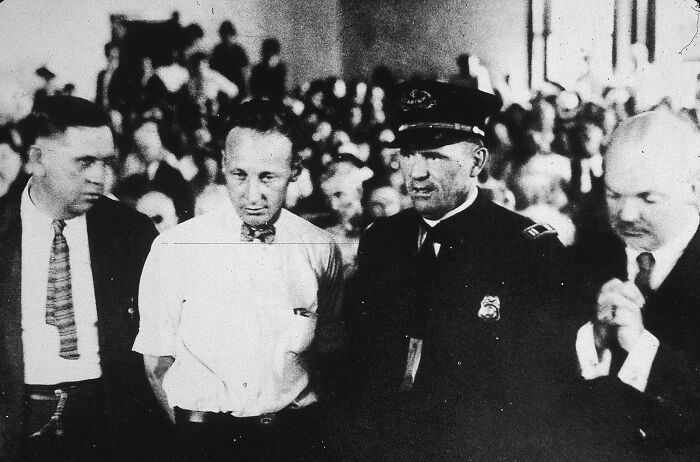
The Scopes Monkey Trial of 1925 was a landmark legal case in the United States that tested the constitutionality of a Tennessee law prohibiting the teaching of evolution in public schools. The case pitted science against religion, as high school teacher John T. Scopes was charged with violating the law by teaching Darwin's theory of evolution. The trial was a media sensation, attracting national attention and drawing crowds of spectators to the courthouse in Dayton, Tennessee. In the end, Scopes was found guilty and fined $100, but the trial exposed the deep divisions in American society over the teaching of evolution and the role of religion in public life.
#40 The Message from the Viet Cong
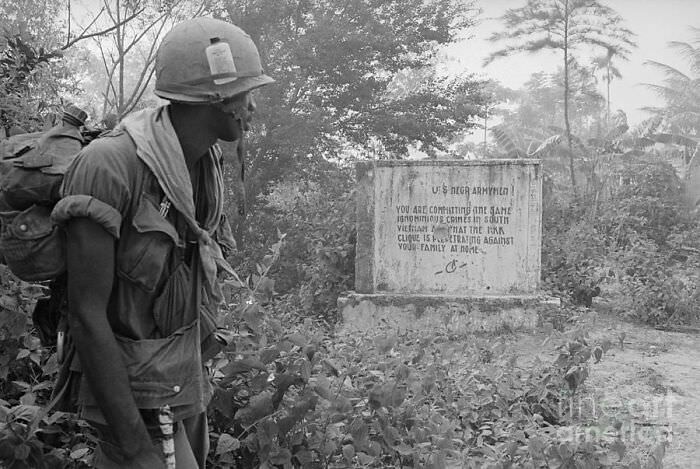
The Vietnam War was a divisive conflict that left a lasting impact on those who fought in it. This photograph captures a moment that highlights the racial tensions present within the US military during the war. In the image, a black US soldier can be seen reading a message left by the Viet Cong. The message accuses black American soldiers of committing the same crimes against the Vietnamese people that the Ku Klux Klan is perpetrating against African Americans at home. This powerful message highlights the intersecting issues of race and war and the complexity of the Vietnam War for many Americans.
#41 Sir David Attenborough Introduces the Royals to a Cockatoo
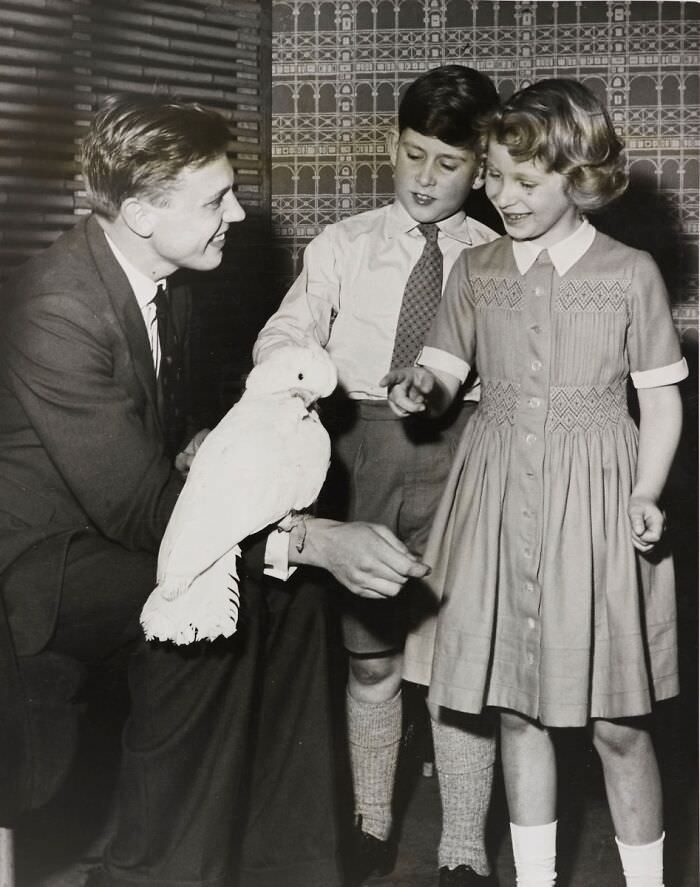
In 1958, Sir David Attenborough, known for his love of nature and wildlife, had the honor of introducing two royals, Prince Charles and Princess Anne, to a charming cockatoo. The event took place at the London Zoo, where Attenborough was serving as controller at the time.
In the photo, Attenborough can be seen holding the friendly bird on his hand while the young prince and princess look on with interest and delight. The moment captures the joy and wonder that can come from experiencing the natural world up close and personal, and it reminds us of the importance of preserving and protecting these precious creatures for future generations.
#42 The Rosie the Riveter of Welding
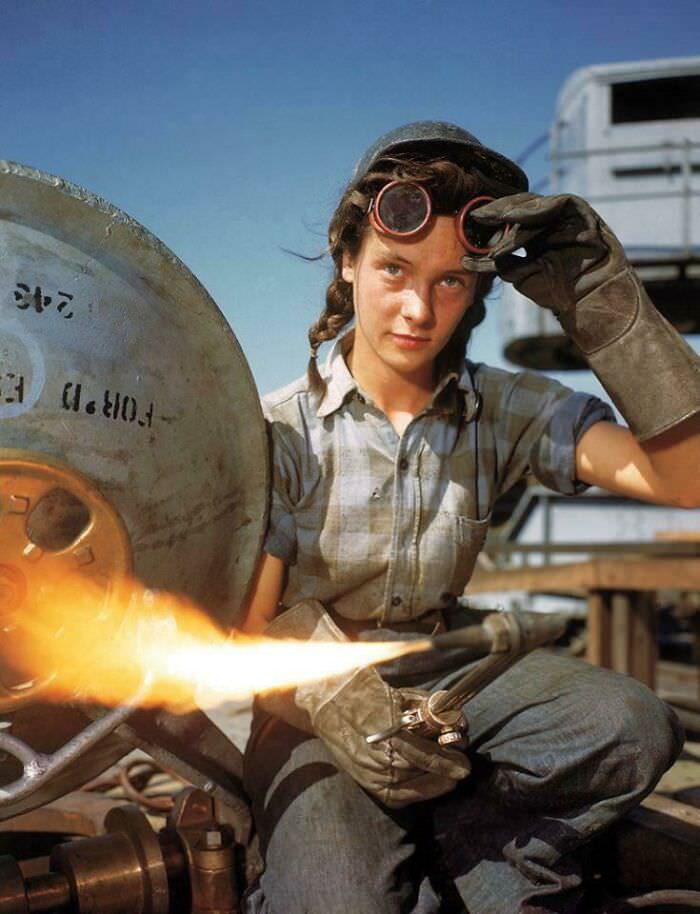
In the midst of World War II, with many men fighting overseas, women stepped up to work in jobs that were traditionally seen as men's work. One such job was welding, and this photo captures a young woman welder in Connecticut during the 1940s. Her outfit and stance show that she is confident and skilled in her trade, and her expression exudes determination and pride. This photo is a powerful reminder of the important role that women played during the war effort and their contribution to the workforce, paving the way for future generations of women to pursue careers in traditionally male-dominated fields.
#43 A Celebration Before the Revolution
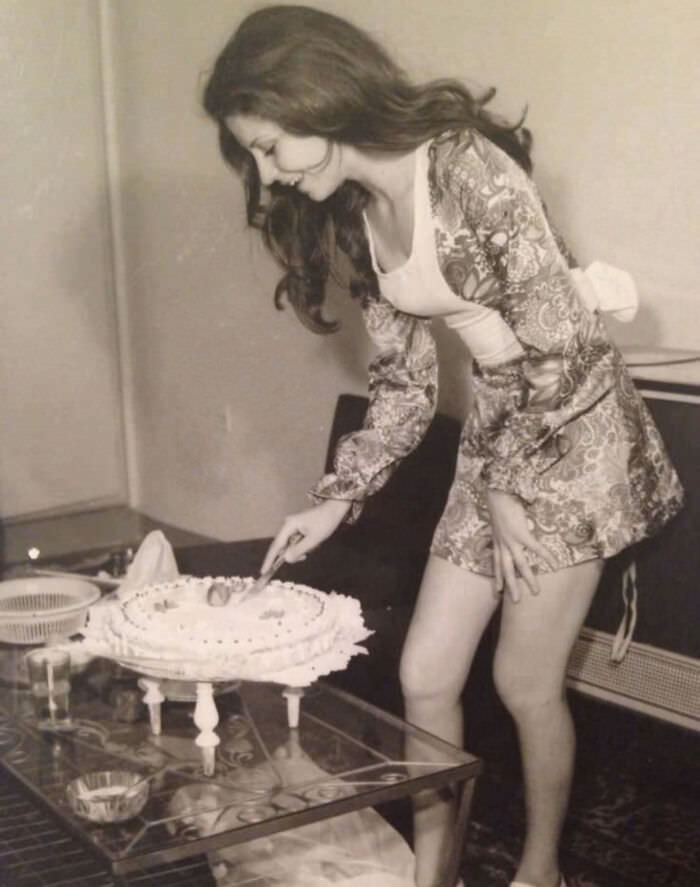
In this photo taken in Iran in 1973, a woman is cutting her birthday cake surrounded by her family and friends. The scene appears to be one of joy and celebration, with the woman dressed in a stylish outfit and the cake decorated with flowers and candles. However, just five years later, the Islamic Revolution would change the face of Iran, ushering in a new era of political and cultural upheaval. The freedoms and customs depicted in this photo would soon be restricted, as the Islamic government implemented strict dress codes and cultural norms.
#44 Healing in Hard Times
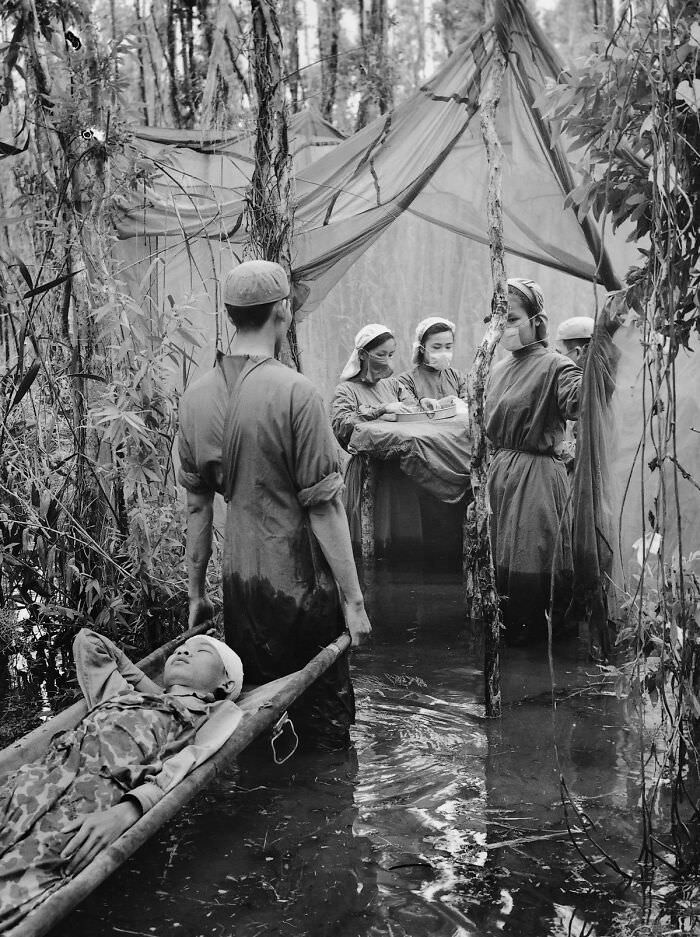
In this powerful photo from the Vietnam War in 1970, we see a makeshift hospital in the midst of chaos. Despite the devastation of war, medical professionals are doing their best to care for the injured and sick. The room is packed with patients and medical equipment, and yet the doctors and nurses work tirelessly to provide care and comfort.
This photo reminds us that even in the darkest of times, there are always people working to bring healing and hope. It is a testament to the resilience and strength of the human spirit, and a reminder that in times of crisis, we must come together to care for one another.
#45 Mastering the Art of French Cooking on Camera
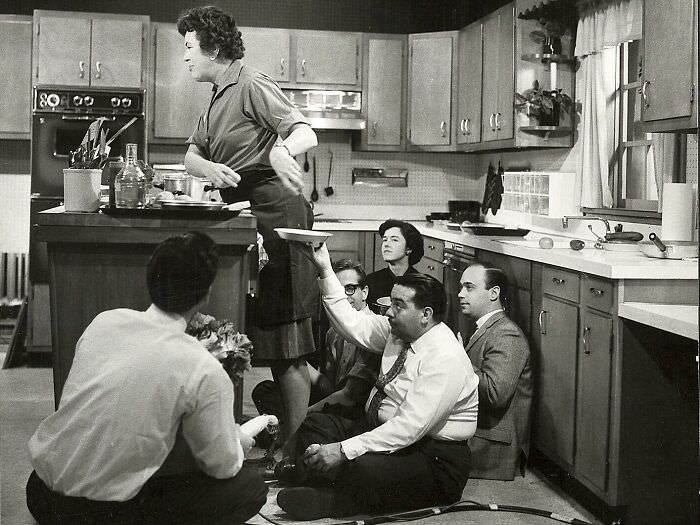
Julia Child was a pioneering figure in American television, bringing French cuisine to American homes with her show “The French Chef.” In this photo from 1963, we see Julia on set, filming an episode of her show, with a chicken roasting in the oven in the background.
With her trademark humor and down-to-earth approach, Julia made cooking accessible to a wider audience and encouraged viewers to try their hand at French cooking. She also co-authored the bestselling cookbook “Mastering the Art of French Cooking” with Simone Beck and Louisette Bertholle, which further cemented her place in the culinary world.
#46 Behind the Scenes with the Vampire
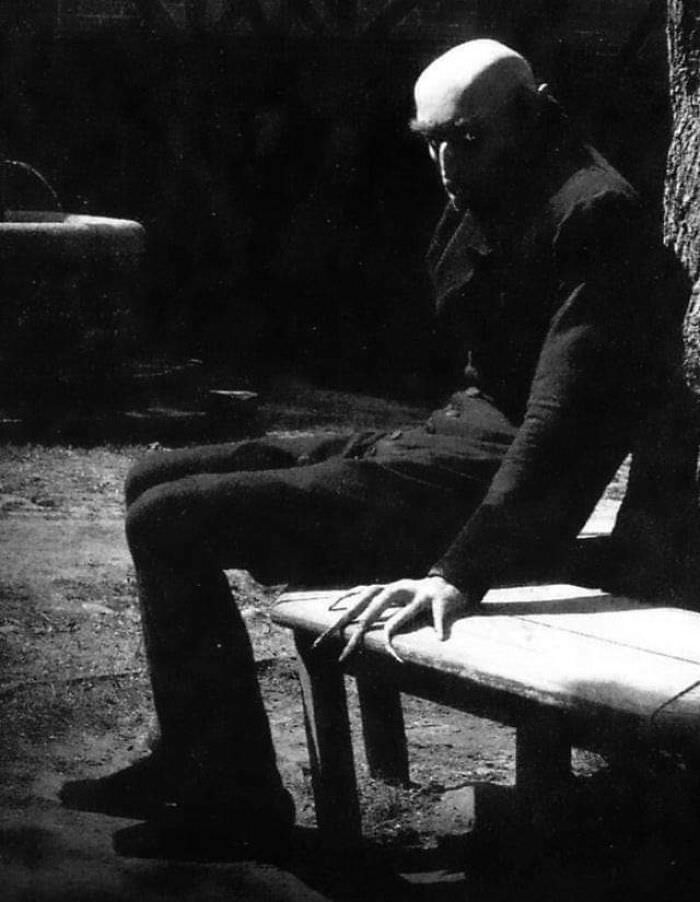
Max Schreck, the actor who played the infamous vampire in the 1922 silent film "Nosferatu," is seen here taking a break on set. The film, an unauthorized adaptation of Bram Stoker's "Dracula," was a groundbreaking work of German Expressionism and has become a classic of the horror genre. Schreck's portrayal of Count Orlok was so convincing that rumors spread that he was an actual vampire. The actor, however, was known for being kind and gentle off-camera, and this photo captures a rare moment of relaxation and levity in the midst of filming.
#47 The First Underwater Photograph
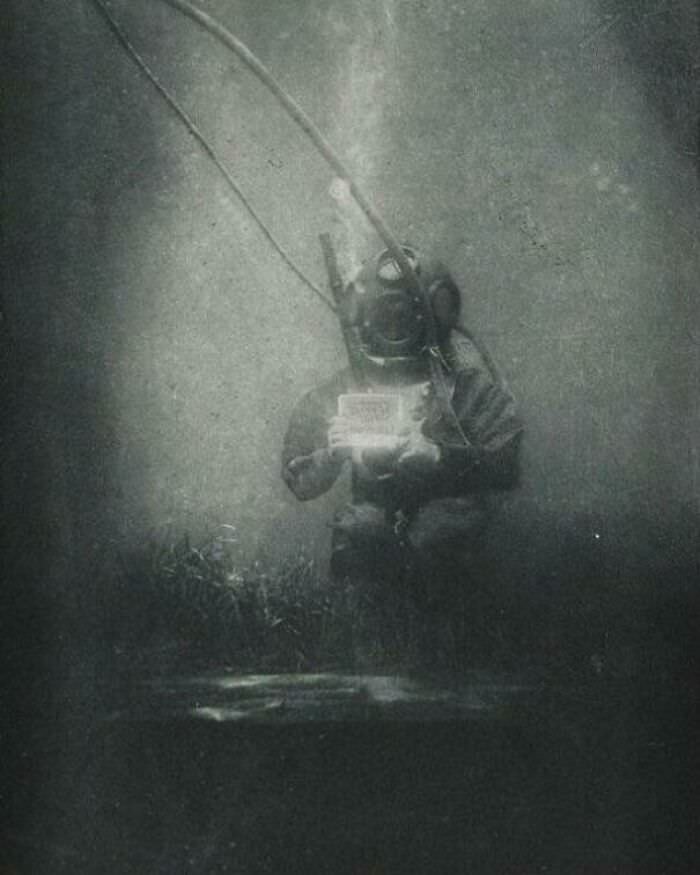
In 1899, Louis Boutan, a French scientist and pioneer of underwater photography, took what many believe to be the first photograph taken underwater. The photograph features a diver fully submerged and looking towards the camera while surrounded by murky water. This photograph marked the beginning of an era of exploration and discovery in the underwater world. Boutan went on to capture many more underwater photographs and videos, contributing greatly to the understanding and preservation of marine life.
#48 A Smile in the Face of Adversity
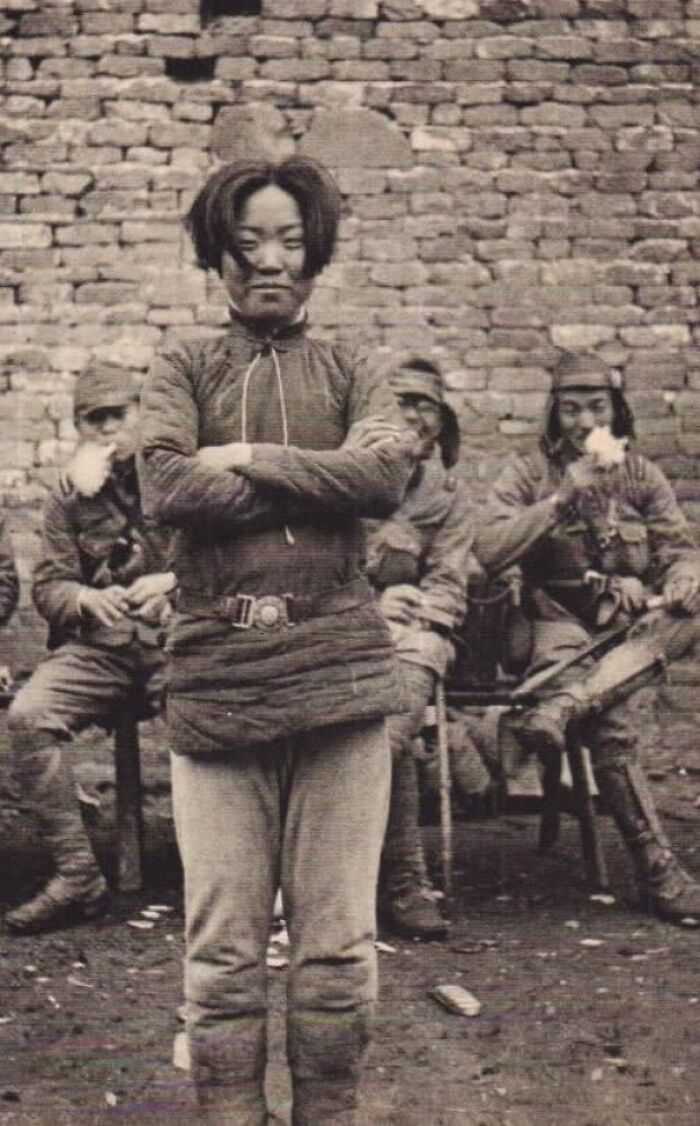
Cheng Benhua, a Chinese guerrilla fighter, is pictured smiling in this historic photograph taken moments before her execution by the Japanese army in late 1938. She was only 24 years old at the time. Despite the grave situation, Cheng’s smile conveys a sense of courage and defiance in the face of the enemy. She fought bravely against Japanese occupation, becoming a symbol of resistance in China. Cheng’s legacy lives on, inspiring generations of people to stand up for their rights and fight against oppression.
#49 Honoring Those Who Served
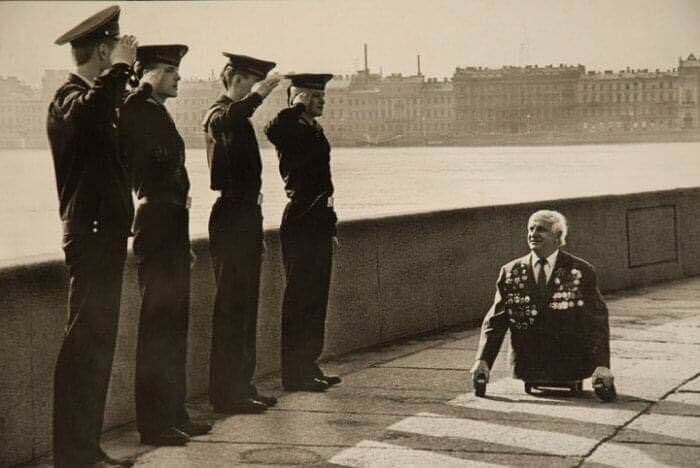
In this powerful photograph, sailors can be seen saluting a war veteran in Leningrad in 1989. The image captures the profound respect and gratitude felt by these young sailors towards the veteran, who likely risked their life during the war. The scene is a poignant reminder of the sacrifices made by those who serve in the military and the lasting impact it has on those who witness it.
#50 Dancing in Defiance
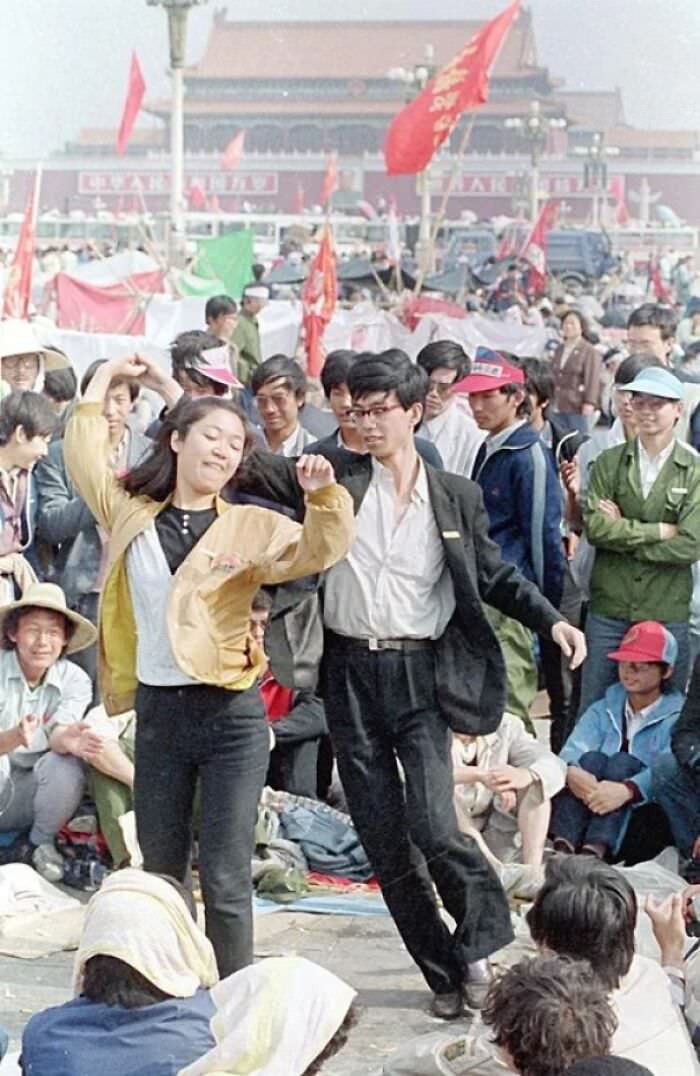
In the spring of 1989, Chinese students gathered in Beijing's Tiananmen Square to demand democracy and government reforms. They organized peaceful protests and hunger strikes that lasted for weeks, but the government refused to listen. On June 4th, the Chinese military was ordered to crack down on the protesters, resulting in a violent confrontation that left many dead and injured.
Before the arrival of the military, a group of students gathered in the square and began dancing as a form of peaceful protest. The photo captures a moment of hope and defiance in the face of an oppressive government. Despite the brutal crackdown that followed, the students' determination to fight for their rights inspired people around the world and left a lasting legacy.
#51 Niagara Falls Dries Up
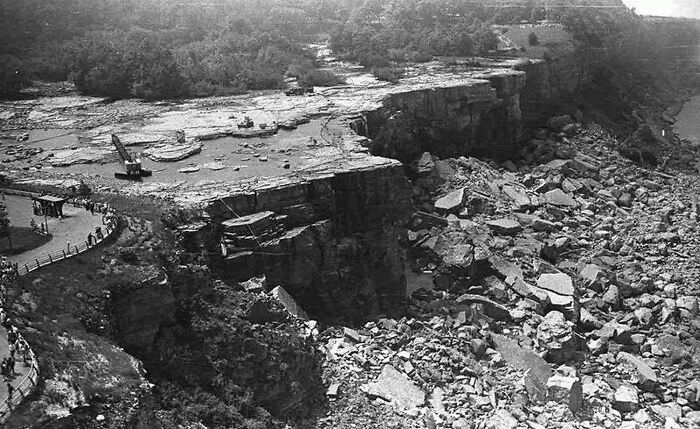
In 1969, the United States Army Corps of Engineers conducted a study on the erosion of the Niagara Falls. As part of the study, they decided to divert the flow of the Niagara River away from the American side of the falls to investigate the rock formations underneath. This diversion effectively stopped the flow of water over the falls, and for several months, the falls were completely dry. This rare occurrence allowed for tourists to walk along the riverbed and explore areas that were usually inaccessible due to the power of the water. It also provided researchers with valuable information on how the falls were formed and the geological makeup of the area. The water was restored in November of that year, and the falls returned to their natural beauty
#52 The Devastation of Mt. St. Helens
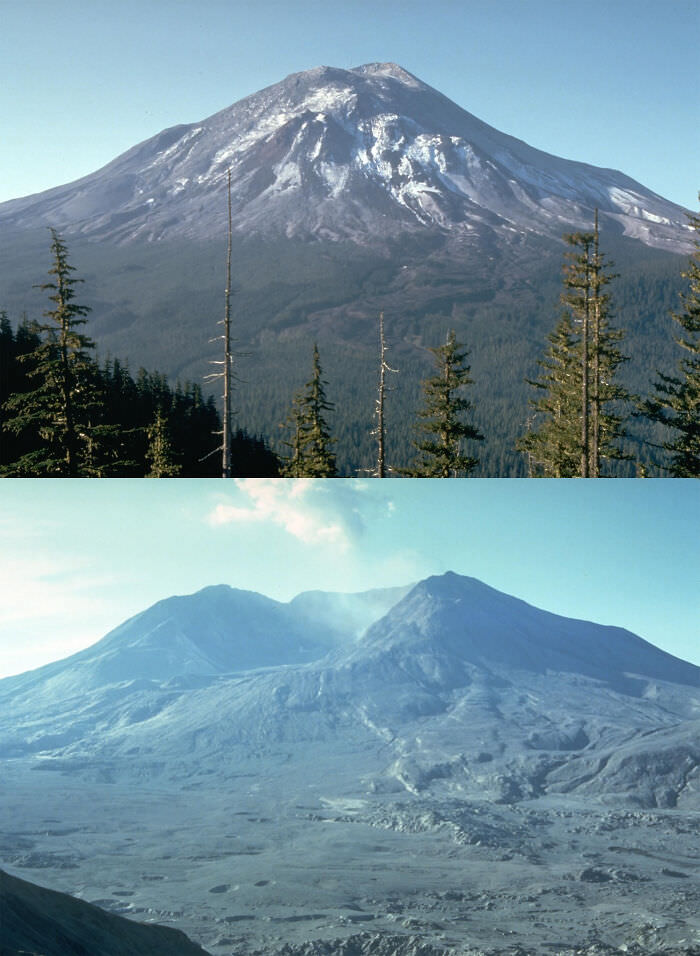
On May 18, 1980, Mt. St. Helens, a volcano in Washington state, erupted with immense force, unleashing a powerful explosion that sent ash, smoke, and rocks into the air. The eruption was so powerful that it removed the top 1,300 feet of the mountain, leaving a gaping crater in its place. The resulting landslide and ash cloud destroyed forests and homes, and caused widespread devastation in the surrounding area. This photo, taken on May 17, 1980, shows the calm before the storm, with the mountain seemingly peaceful and undisturbed. Just four months later, the second photo shows the aftermath of the eruption, with a barren, ash-covered landscape where lush forests once stood. The eruption of Mt. St. Helens was a tragic event that forever changed the landscape and the lives of those who lived nearby.
#53 Bowie’s Mugshot
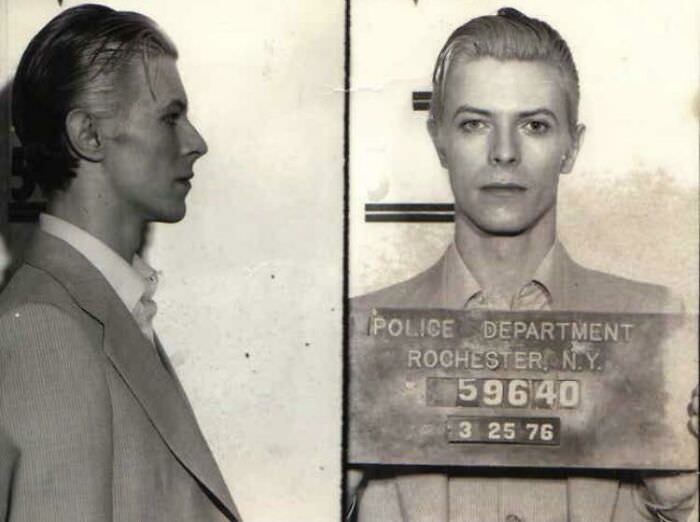
In 1976, David Bowie was arrested for marijuana possession in Rochester, New York. This rare photo captures him after the arrest, with his hair wild and disheveled, wearing a rumpled suit and an unbuttoned shirt. Despite the circumstances, Bowie looks undeniably cool and confident, with a sly smirk on his face. The arrest did little to affect his career, and he continued to release successful albums and reinvent himself as an artist over the decades to come.
#54 Conrad Schumann’s Leap to Freedom
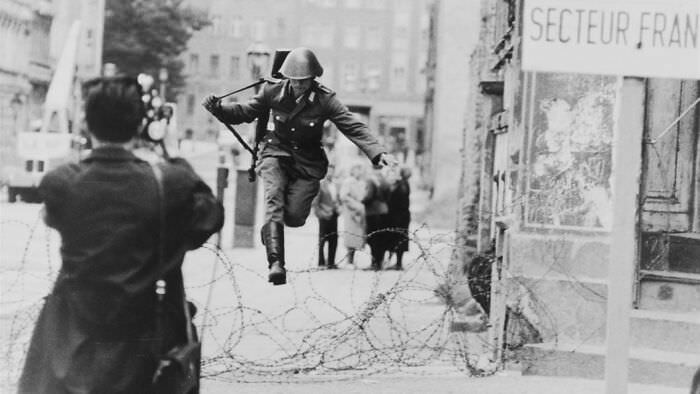
In August 1961, just days after the construction of the Berlin Wall began, East German border guard Conrad Schumann made a daring escape to the West. Schumann was responsible for guarding the wall near Checkpoint Charlie, but one day he couldn't take it anymore. As a crowd gathered on the West German side of the wall, Schumann made the decision to jump over the barbed wire fence, leaving his colleagues behind. The iconic photograph captured the moment he leapt to freedom, leaving behind his East German uniform and rifle. Schumann was later granted asylum in West Germany, and the image became a symbol of the desperate desire for freedom in East Germany.
#55 Behind the Scenes of The Shining
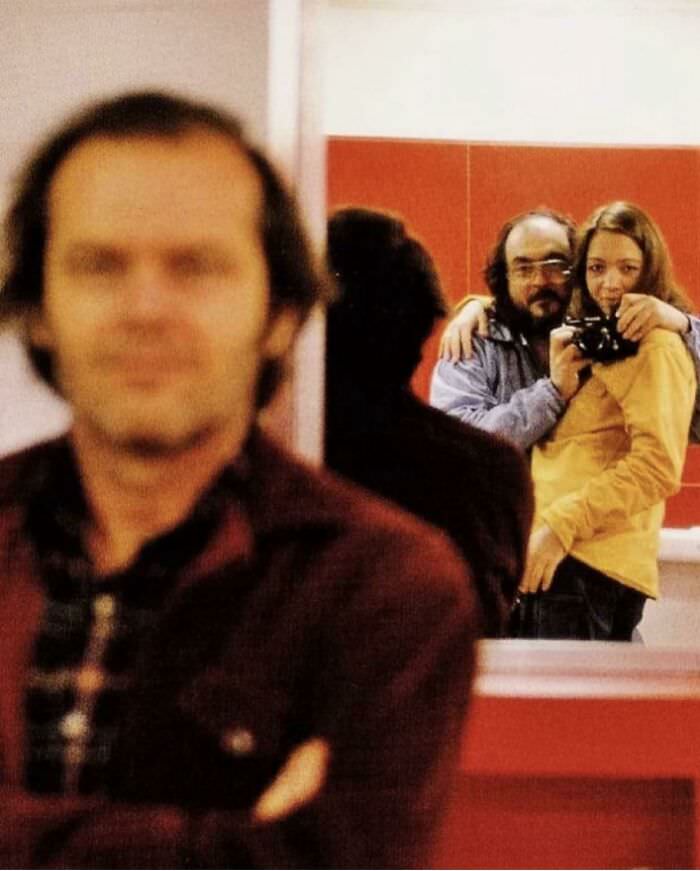
This iconic photo captured by Kubrick's daughter Vivian shows the legendary filmmaker in a rare moment of reprieve on the set of his horror masterpiece, The Shining. Kubrick can be seen smiling and holding his daughter, while in the background actor Jack Nicholson appears to be unaware of the photo being taken, perhaps thinking he was the intended subject. The photo gives a glimpse into the atmosphere on set during the production of one of the most acclaimed horror films of all time, which has gone on to become a cultural touchstone and subject of countless parodies and references in popular culture.
#56 Jackie Chan Stands Up for Tiananmen Square Protesters
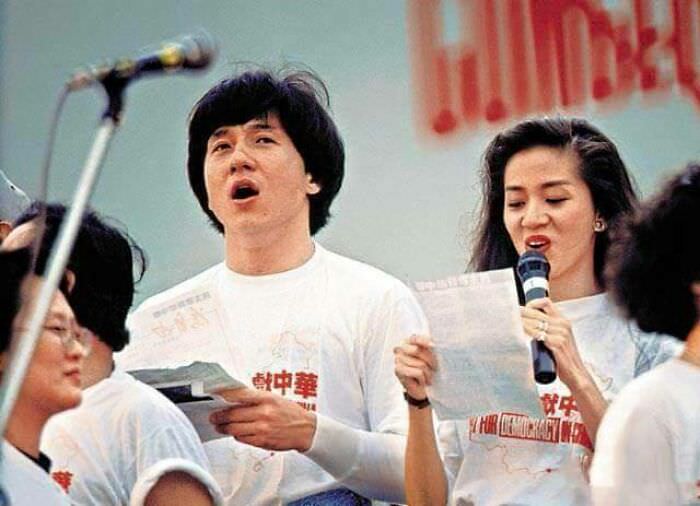
In 1989, Hong Kong held a benefit concert to support the protesters at Tiananmen Square. Jackie Chan, a martial arts star and actor, was among the performers at the concert. Chan had always been careful to avoid political involvement, but this time he chose to speak out.
During his performance, Chan wore a white headband with the words "All blood is the same color" written on it. He also spoke to the crowd about the importance of democracy and freedom, urging them to support the protesters in their fight for their rights.
Chan's actions were significant because he was a popular figure in both Hong Kong and mainland China. By speaking out in support of the protesters, he put himself at risk of damaging his career and reputation. However, Chan believed it was important to stand up for what he believed in, even if it came at a personal cost.
#57 The Great Escape of Sami the Chimpanzee
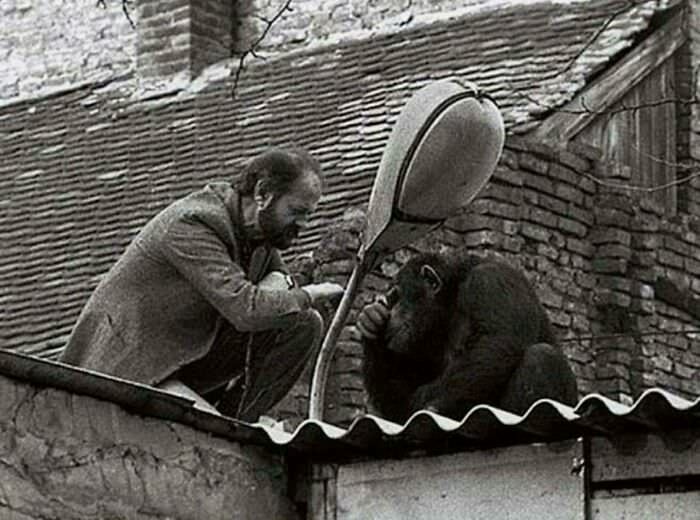
In 1988, Sami the chimpanzee, a resident of the Belgrade Zoo, made a daring escape, climbing the walls of his enclosure and fleeing into the city. The director of the zoo, Vuk Bojovic, frantically tried to convince Sami to return home, even climbing up after him on a nearby building. But Sami seemed to have other plans, running across rooftops and through the streets of Belgrade, evading capture for several hours.
Eventually, Sami was caught and returned safely to the zoo. But his escape had captured the public's imagination, with many cheering on the mischievous chimp and his daring adventure.
#58 Forced Assimilation in Canadian Residential Schools
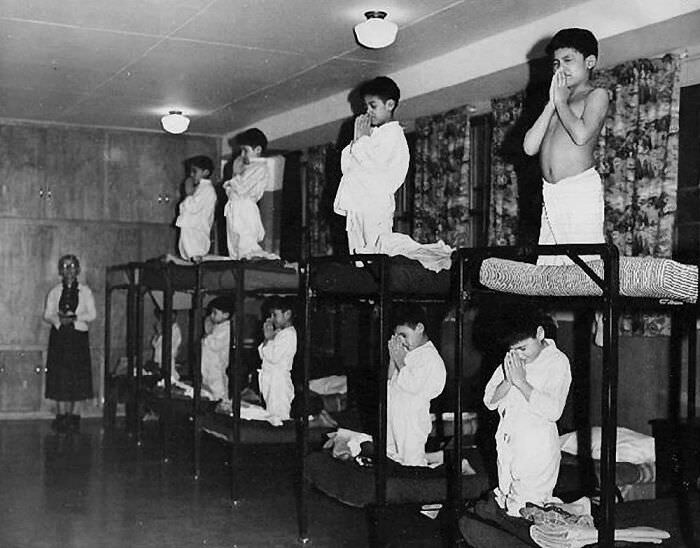
This powerful photograph captures the heartbreaking reality of Indigenous children being forced to abandon their culture and adopt Christianity in residential schools run by the Canadian government and the Catholic Church. From the 1930s to the 1970s, thousands of Indigenous children were taken from their families and placed in these schools, where they were forced to speak English or French, cut their hair, and abandon their traditional clothing and practices. This photo shows children being made to pray to a Christian God, a practice that was meant to strip them of their culture and identity. The legacy of residential schools continues to impact Indigenous communities in Canada, with many survivors still grappling with the trauma of their experiences.
#59 Moments Before Tragedy: Archduke Franz Ferdinand and His Wife
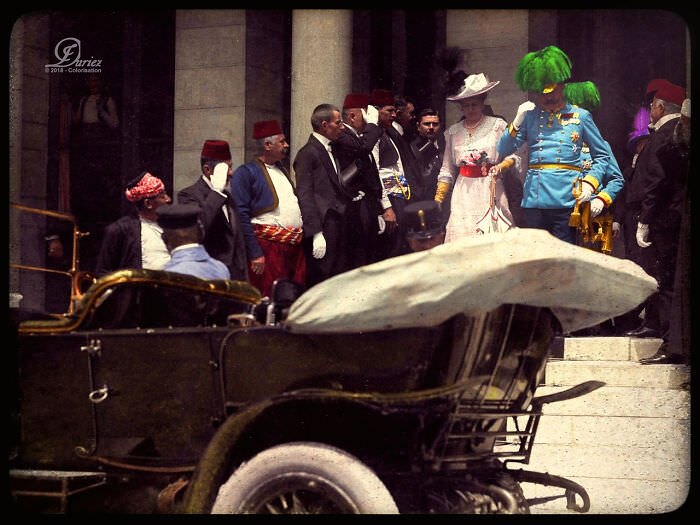
On June 28, 1914, Archduke Franz Ferdinand, heir to the Austro-Hungarian Empire, and his wife, Sophie, visited Sarajevo, Bosnia, as part of an official visit. As they traveled through the city in an open car, a young man named Gavrilo Princip, a member of a Serbian nationalist group, shot and killed them both. This act of violence became the spark that ignited World War I.
This photo captures the last moments of Franz Ferdinand and his wife before the assassination. They can be seen sitting in their car, moments away from the event that would change the course of history.
#60 Desperate Escape
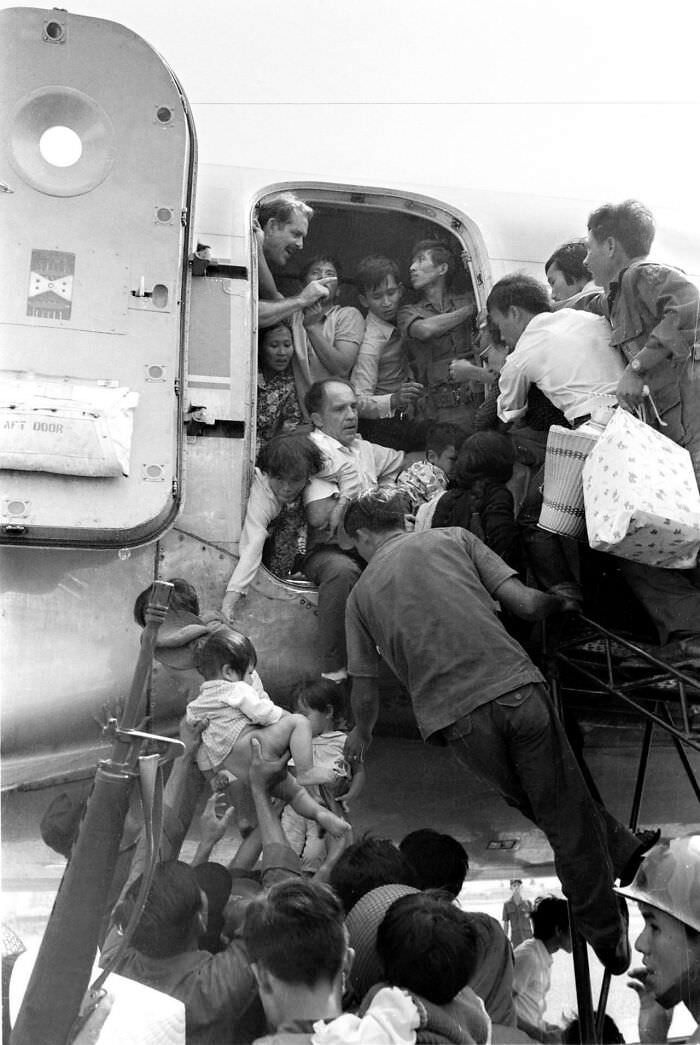
In the final days of the Vietnam War, the US was frantically trying to evacuate as many people as possible from South Vietnam. In this photo taken on April 1, 1975, at the airport in Nha Trang, chaos erupts as people fight to board a plane out of the country. The US withdrawal was seen as a victory for the North Vietnamese, and those left behind were at risk of being persecuted for their association with the US or South Vietnamese government. Amidst the chaos, families were separated and people were injured as they tried to get on the few planes available.
#61 Nevermind: A Generation’s Anthem

This iconic photograph was taken in 1991 by Kirk Weddle during a photo shoot for the album cover of Nirvana's "Nevermind." The album was released on September 24, 1991 and is widely regarded as one of the greatest and most influential albums of all time. The image features a baby swimming underwater, reaching out for a dollar bill on a fishhook, an image that captured the mood of the era and became a symbol for the disillusionment and angst of a generation. The album's raw energy, combined with its themes of alienation and self-discovery, struck a chord with young people around the world, and Nirvana quickly became one of the most popular and influential bands of the 1990s.
#62 Young Yves Saint Laurent Pays Respect to Christian Dior
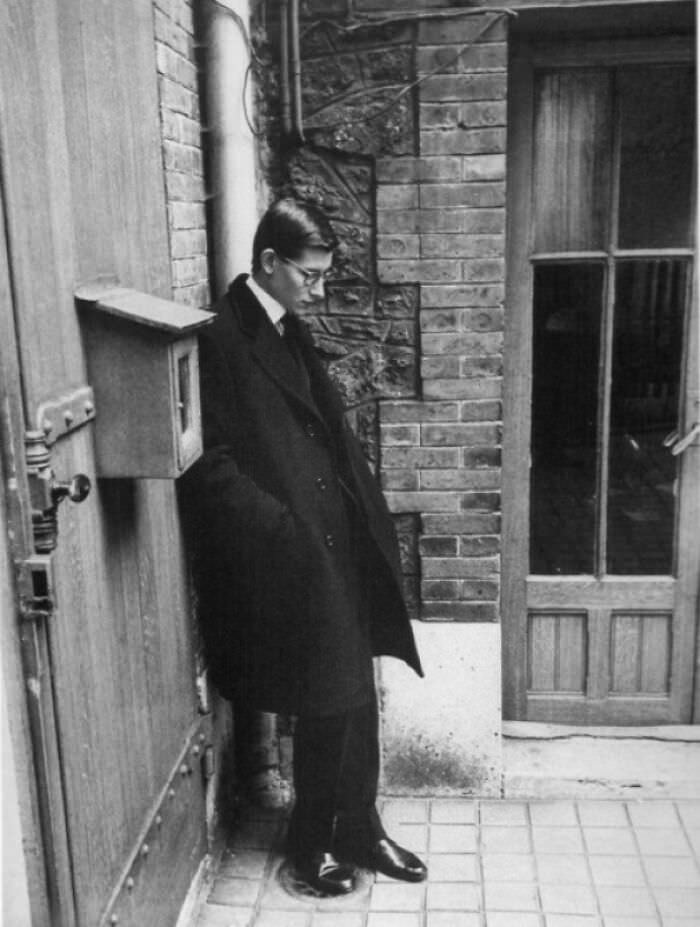
In this historic photo, a 21-year-old Yves Saint Laurent is captured attending the funeral of legendary fashion designer Christian Dior in 1957. Dior had been a mentor and employer of Saint Laurent, who was then only 19 years old when he was appointed as Dior's successor after his sudden death. This photo is a poignant moment in fashion history, as it captures the transition from one iconic designer to the next. Saint Laurent would go on to revolutionize fashion with his own designs, paving the way for modern couture as we know it today.
#63 Flower Power in Oklahoma

This photo captured the essence of the hippie movement in the early 1970s. A young girl, clad in a headband and tie-dye shirt, sold roadside flowers in Oklahoma. Her carefree and peaceful demeanor exuded the "flower power" ideology that was prominent during this time. The hippie movement was a response to the societal norms of the time, and it sought to promote love, peace, and freedom. This photo serves as a reminder of the power of youthful idealism and the counterculture movement that challenged the status quo. The girl's innocent smile and the colorful flowers she sells are a representation of the hope for a better world that the hippie generation carried with them.
#64 Landing on the Wrong Carrier
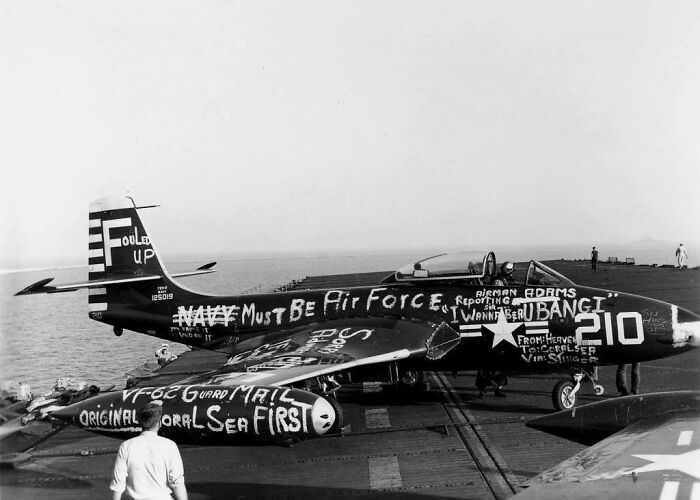
The photo captures the moment when Lieutenant Commander George C. Watkins, a U.S. Navy fighter pilot, realized he had made a critical mistake. He had just landed his F9F-2 Panther fighter jet on the wrong aircraft carrier, the USS Monterey, instead of his own carrier, the USS Essex. As the jet's engines were being turned off, Watkins knew he was in trouble. He had only a few seconds to react before the Panther was launched off the Monterey's deck into the ocean.
Watkins quickly radioed his carrier, but it was too late. The jet was launched into the sea, and Watkins had to be rescued by a helicopter. The photo serves as a stark reminder of the consequences of even the slightest mistake in the high-stakes world of naval aviation.
#65 he Evolution of House Cleaning: Vacuum Cleaners Enter the Scene
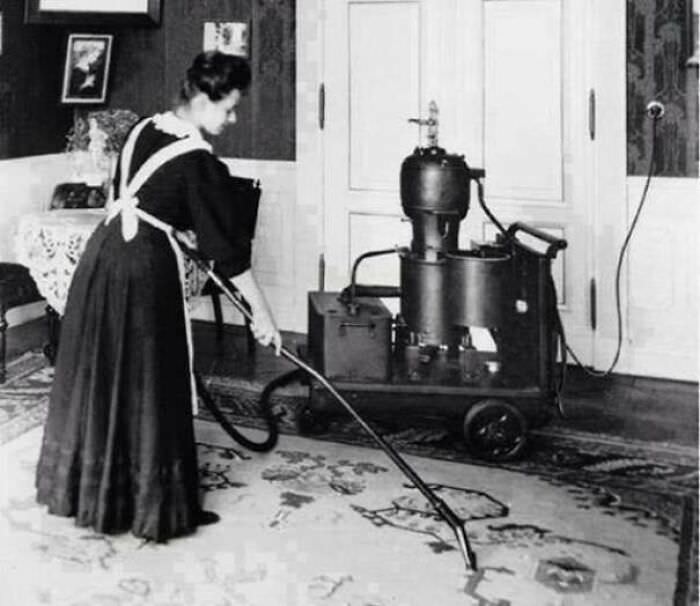
In 1906, the vacuum cleaner was still a relatively new invention, but it was already changing the way people approached house cleaning. This photo captures a woman using a vacuum cleaner to clean her home, demonstrating the growing popularity of this time-saving device.
Before the vacuum cleaner, people relied on brooms and dustpans to clean their floors, a time-consuming and physically demanding task. But with the invention of the vacuum cleaner, cleaning became much easier and faster. While the earliest vacuum cleaners were large and unwieldy, they quickly evolved to become smaller and more convenient.
As this photo shows, the vacuum cleaner was a game-changer for housewives, allowing them to keep their homes cleaner with less effort. Today, vacuum cleaners are still an essential tool for keeping homes clean, and have come a long way from their humble beginnings in the early 20th century.
#66 Chinese and Malayan girls forcibly taken from penang by the Japanese to work as ‘comfort girls’ for the troops. 1939-1945
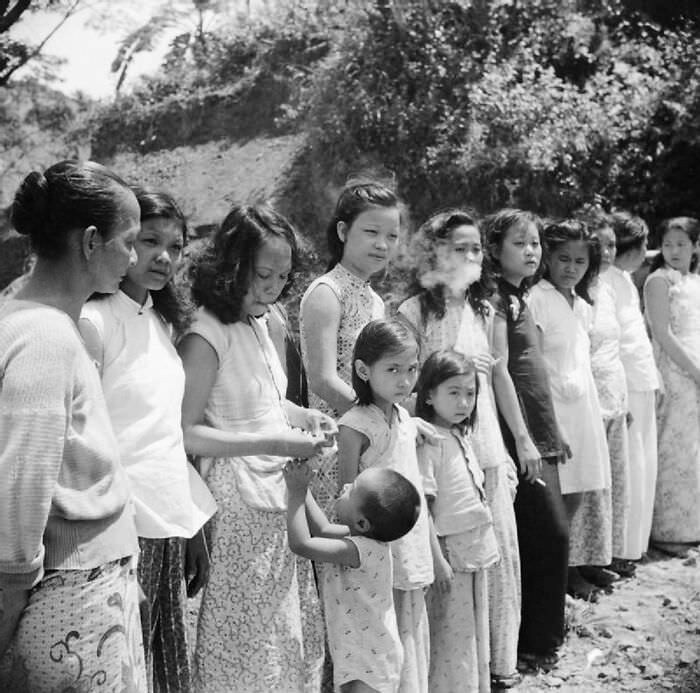
The term "comfort women" is inappropriate and offensive as it tries to euphemize the horrors and violence that these women endured during the war. The Japanese military systematically abducted, imprisoned, and sexually exploited an estimated 200,000 women and girls, mostly from Korea, China, and the Philippines, to serve as "sex slaves" for their soldiers. These women were subjected to rape, torture, and brutal living conditions. It is important to use accurate and sensitive language when discussing historical events and the experiences of victims.
#67 The Tragic Consequence of Man’s Greed
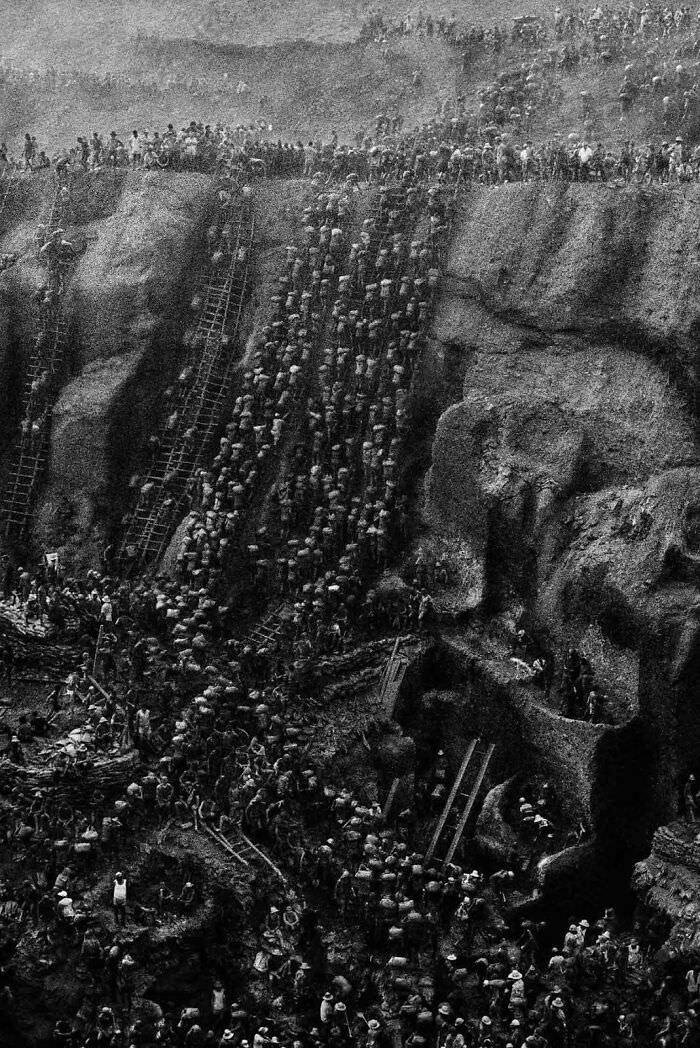
In the late 1800s, the North American bison population was rapidly declining due to over-hunting and the expansion of the American frontier. In 1892, a photographer captured an image of a mountain of buffalo skulls, which serves as a haunting reminder of the tragic consequences of man's greed. The image shows the scale of the devastation that had been wrought upon the once-mighty buffalo population, which numbered in the millions before being hunted to near extinction. The mountain of skulls is a stark reminder of the need to preserve and protect our natural resources before it's too late.
#68 KKK Rides High in Colorado
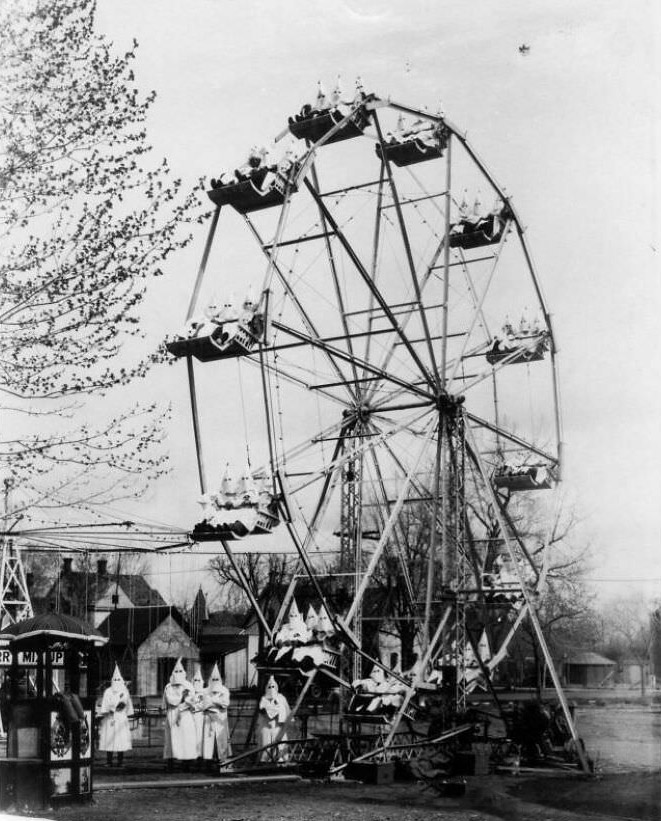
In this 1926 photograph, members of the Ku Klux Klan (KKK) are seen riding a Ferris wheel at an amusement park in Cañon City, Colorado. The image serves as a chilling reminder of the Klan's power and reach during the 1920s, when its membership was at its peak across the United States.
During this time, the Klan had a significant presence in Colorado and used its influence to push for discriminatory laws and policies targeting minorities, especially African Americans, Catholics, and Jews. The Klan also had a significant presence in the political sphere and was able to elect members to positions of power in some areas.
This photograph captures the brazenness and normalized nature of the Klan's presence in American society during the early 20th century, and serves as a stark reminder of the ongoing struggle against hate and bigotry.
#69 When Even a Princess Can’t Win

In this candid moment captured around 1991, Princess Diana appears to be losing an argument to her 7-year-old son, Prince Harry. Despite her royal status and position of power, the image reminds us that even the most prominent figures can have their parenting moments. The photograph, taken by Tim Graham, shows Diana in a state of exasperation as Harry confidently stands his ground. The young prince, with his hands on his hips, appears unfazed by his mother's attempt to persuade him.
#70 Romanov Sisters’ Summer Cruise
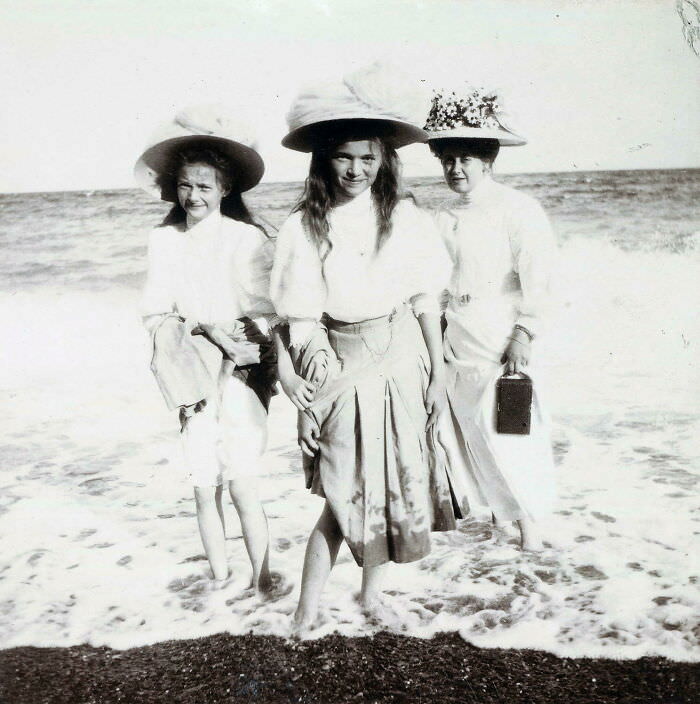
In 1908, the daughters of Tsar Nicholas II of Russia - Grand Duchesses Olga, Tatiana, Maria, and Anastasia - took a summer cruise in Finland with their family. This photograph captures the sisters on the deck of the yacht, enjoying the fresh sea breeze and the beautiful scenery. The Romanovs were known for their opulent lifestyle, but this image captures a more relaxed and carefree moment for the young princesses. Unfortunately, their idyllic life would be cut short just a few years later, as the family would fall victim to the Russian Revolution and ultimately be executed by the Bolsheviks in 1918.
#71 Mobsters Hide their Faces at Al Capone’s Trial
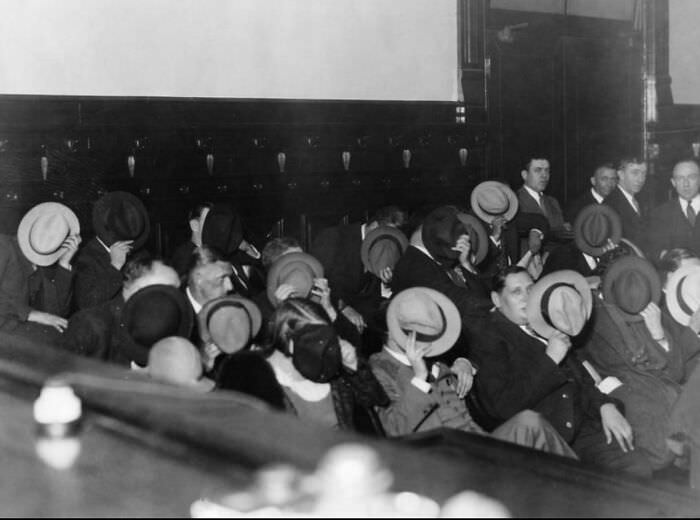
In 1931, notorious gangster Al Capone was brought to trial for income tax evasion, and the world watched as some of the most powerful mobsters of the time were called to testify. In this photograph, taken during the trial, several of the mobsters can be seen covering their faces to avoid being identified by the press. Despite their attempts at secrecy, the trial ultimately led to Capone's conviction and imprisonment.
The trial was a significant moment in the history of organized crime, as it demonstrated the power of the legal system to bring even the most powerful criminals to justice. The photograph captures a moment of tension and fear among the mobsters, as they were forced to confront the consequences of their actions. Today, it remains a powerful reminder of the importance of holding criminals accountable for their actions, regardless of their wealth or influence.
#72 The Woman Accused of Assassination
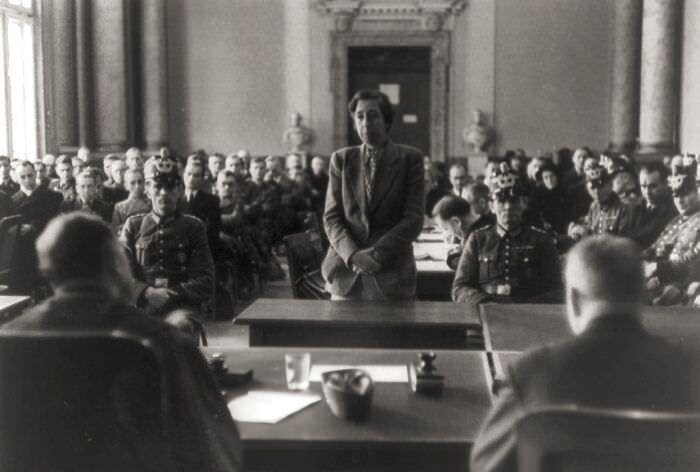
In this rare photograph, Elisabeth "Lilo" Gloeden stands before the judges during her trial for involvement in the plot to assassinate Adolf Hitler in 1944. Lilo was part of the German resistance movement and was believed to have helped in the assassination attempt that failed. She was later arrested by the Gestapo and was sentenced to death. Her trial was a sham and her sentence was carried out in January 1945. This photograph captures the fear and apprehension that Lilo must have felt as she faced her accusers.
#73 Tragedy at the Rail Yard: The Boiler Explosion of C&O T-1 #3020
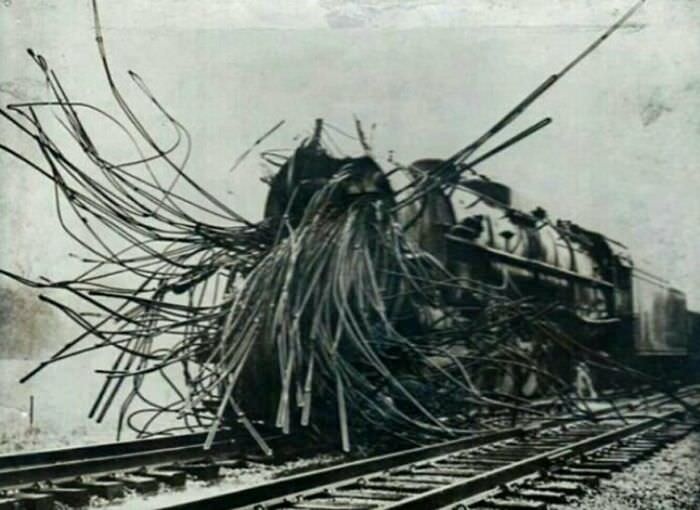
On May 22, 1948, tragedy struck the rail yard when the C&O T-1 #3020 locomotive experienced a catastrophic boiler explosion. The explosion was so powerful that debris was scattered throughout the surrounding area, causing damage to nearby buildings and injuring several bystanders. The force of the blast was enough to lift the massive locomotive off its tracks and toss it onto its side.
Despite the heroic efforts of first responders and railway workers, several crew members lost their lives in the explosion. The cause of the explosion was later attributed to a combination of factors, including the age of the boiler and the high-pressure steam generated during the locomotive's operation.
#74 he Human Side of War: An Enemy Becomes a Patient
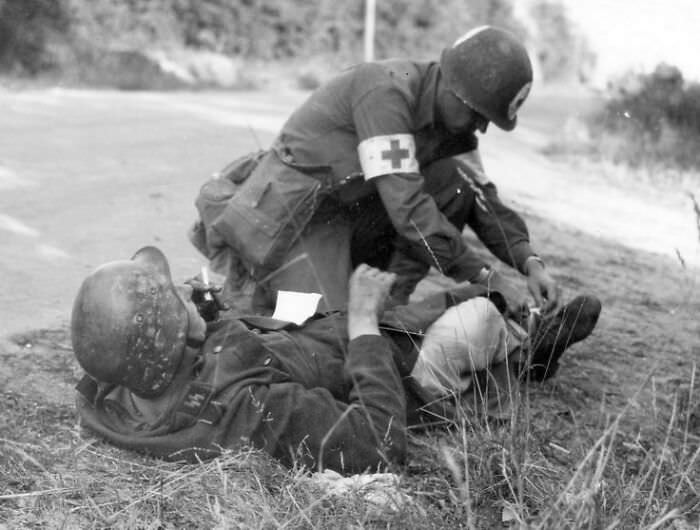
This photograph, taken by Robert Capa, shows a US medic providing first aid to a wounded German SS soldier in France during World War II. The photo captures a moment of humanity amid the violence of war. The medic, shown with his back to the camera, is tending to the injured soldier's leg. The German soldier appears to be in great pain, yet the medic shows no hesitation in helping him. This photo serves as a reminder that even in times of war, compassion and humanity can still exist. It also highlights the bravery and selflessness of medics who risk their own lives to help others, regardless of their nationality or allegiances.
#75 The Early Days of the Vegas Strip
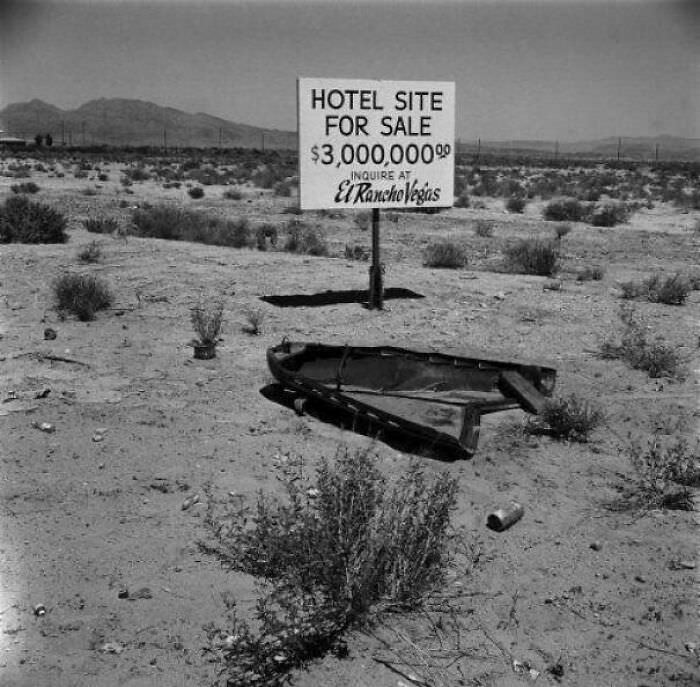
In 1955, the Las Vegas Strip was still in its early stages of development, with only a handful of major hotels and casinos standing. The iconic neon lights and towering structures that we associate with the Strip today were yet to come, as the area was still considered a playground for high rollers and wealthy visitors seeking glamorous entertainment.
This photograph captures the early days of the Vegas Strip, with the Flamingo Hotel and Casino visible in the background. The Flamingo was one of the first major hotels on the Strip, built by notorious gangster Bugsy Siegel in 1946. At the time of this photo, the hotel was still relatively new and had not yet established the reputation and glamour it would eventually become known for.
#76 Devastation from Above: A View of Dresden after the Bombing
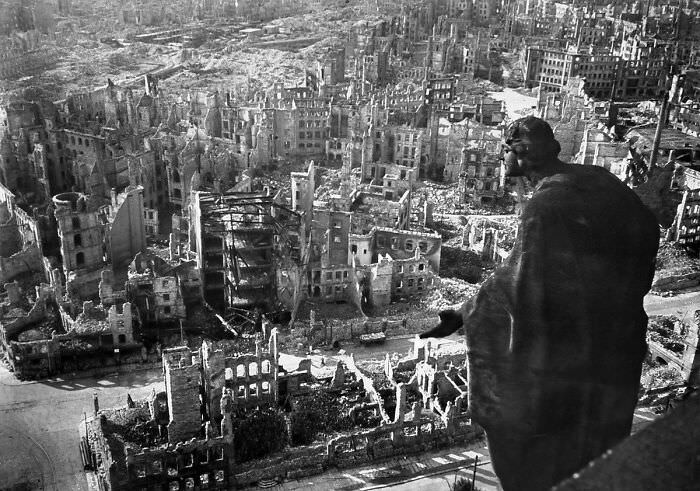
In February 1945, Allied forces carried out a devastating bombing campaign on the German city of Dresden, reducing much of the city to rubble. This photo, taken from the town hall tower, captures the scale of the destruction in the old town. The once-beautiful buildings that made up the historic city center are now nothing more than piles of rubble and debris. The bombing of Dresden remains a controversial event, with some arguing that it was an unnecessary and excessive act of violence against a civilian population, while others defend it as a strategic military action.
#77 Celebrating Victory: Pyramid of German Helmets in Grand Central, New York
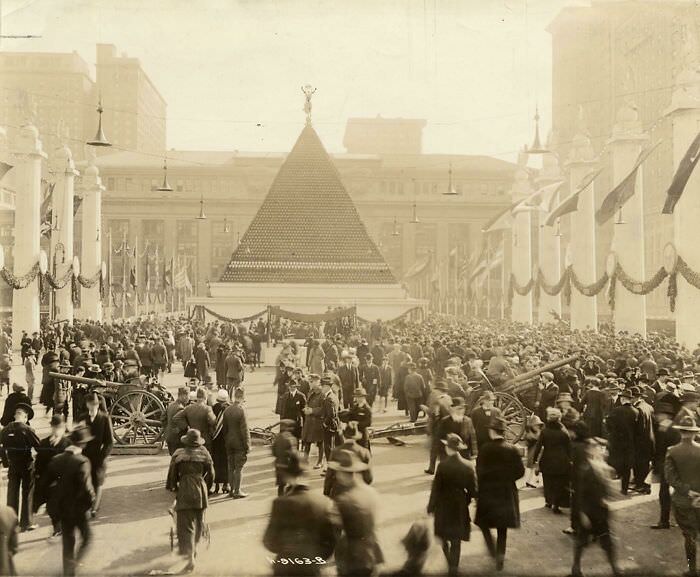
In 1919, Grand Central Terminal in New York City became the site of a unique display to commemorate victory in World War I. A towering pyramid of German Army helmets was erected in the station's main concourse. Each helmet was inscribed with the name of an American soldier who had died in the war, and the pyramid was topped by an American eagle. The display was intended to both honor the fallen soldiers and to show the might of the victorious United States.
The pyramid was the brainchild of Colonel Lewis L. Strauss, who served as the chairman of the Victory Loan Drive, an initiative to raise funds for the war effort. Strauss believed that a striking visual display would help to galvanize support for the drive and raise awareness of the sacrifices made by American soldiers in the war. The pyramid was dismantled after the drive was completed, but it remains a powerful symbol of the sacrifices made by soldiers in the Great War.
#78 ucker Sno-Cat on a Risky Antarctic Journey
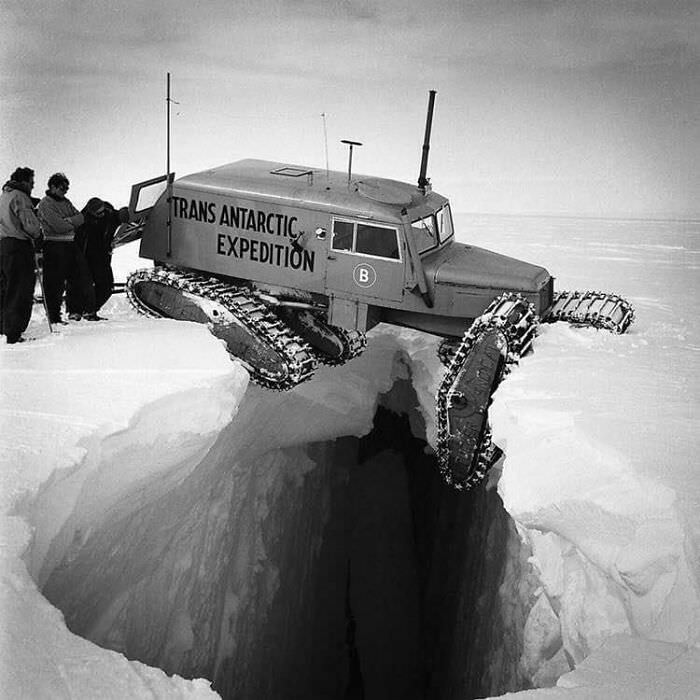
In the photo, a Tucker Sno-Cat is seen hovering over a crevasse during the Transantarctic Expedition of 1954. The expedition was the first to cross Antarctica from the Weddell Sea to the Ross Sea via the South Pole. Led by British explorer Sir Vivian Fuchs and Sir Edmund Hillary, the expedition used Sno-Cats as their primary mode of transportation through the harsh and unforgiving terrain of the Antarctic. The Sno-Cats were specially designed with tracks that allowed them to traverse the icy terrain with ease.
#79 The Amber Room in Color, 1943
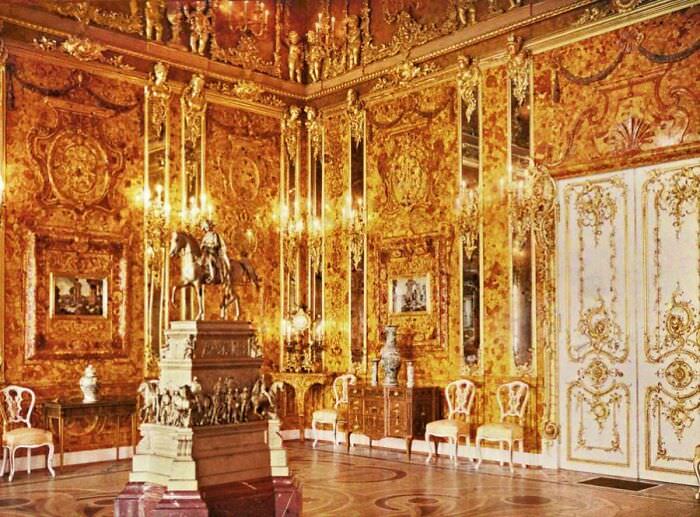
Story: The Amber Room, an ornate chamber lined with panels of amber, gold leaf, and mirrors, was created in the early 18th century in Prussia and was later gifted to Peter the Great of Russia. During World War II, the Nazis looted the room from a palace near St. Petersburg, and it has never been seen since. This photograph, taken in 1943, is the only known color photograph of the Amber Room. It shows the stunning detail of the amber panels, intricate carvings, and gold leaf. The Amber Room remains one of the greatest unsolved mysteries of art theft, with many theories and rumors surrounding its whereabouts.
#80 The Champs-Élysées on VE Day, Paris, France, May 8, 1945
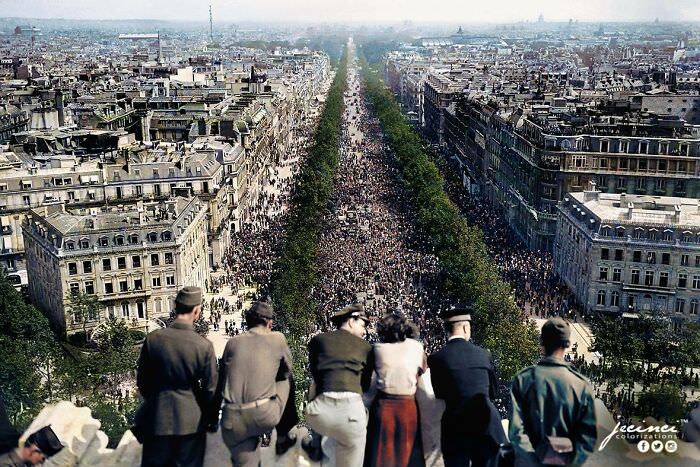
This photograph depicts the view of the Champs-Élysées as seen from the Arc de Triomphe on VE Day, May 8, 1945. It captures the celebratory atmosphere in Paris as people flooded the streets to mark the end of World War II in Europe. The Arc de Triomphe, which is a symbol of French patriotism and military victories, can be seen in the foreground, while the avenue stretching out into the distance is lined with cheering crowds and waving flags. This image serves as a powerful reminder of the joy and relief felt by people around the world at the end of the war.
#81 George N. Barnard’s 1864 photograph of a slave trader’s business on Whitehall Street, Atlanta, Georgia
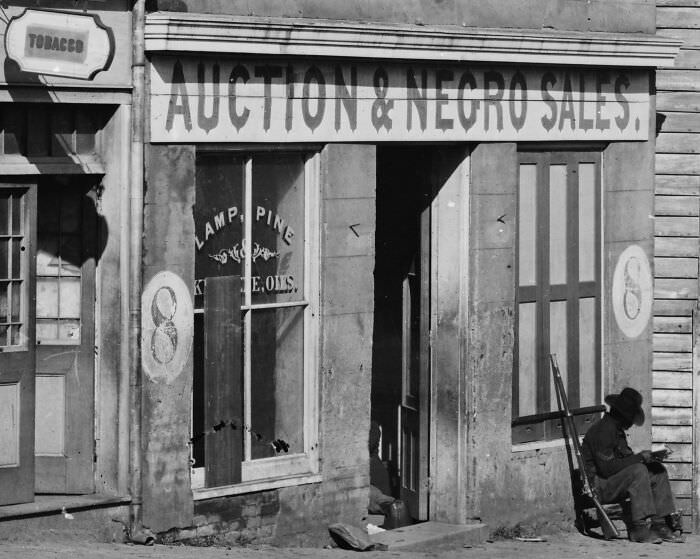
This is a stereograph photograph taken by George N. Barnard in 1864, showing a slave trader's business on Whitehall Street in Atlanta, Georgia. The photograph is a reddish-brown tone and features two identical images next to each other on yellow card stock. The scene depicts a block of commercial buildings, with the central building having a sign that reads "AUCTION & NEGRO SALES" on the bottom floor and "CHINA GLASS / & / QUEENSWARE" on the upper floor. A man in dark clothing can be seen sitting in front of the store with a rifle propped against a window of the center building.
#82 Student Survivors Evacuated to Library Near Columbine High School After Shooting Rampage
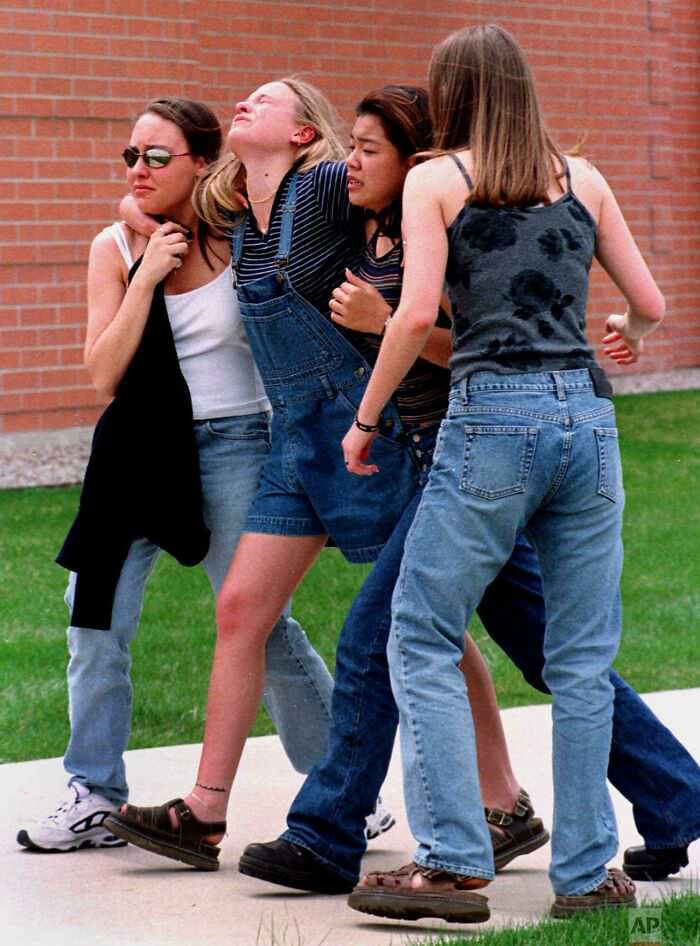
On April 20, 1999, two gunmen went on a shooting rampage at Columbine High School in Colorado, killing 13 people and injuring 21 others before taking their own lives. In the aftermath of the tragedy, students and faculty members were evacuated to nearby locations for safety.
This photograph shows a group of student survivors walking towards a library near Columbine High School where they were taken after the shooting. The students look visibly shaken and distraught, with some holding onto each other for support.
#83 Tutankhamun’s head. Harry burrton photo published dec. 1925.
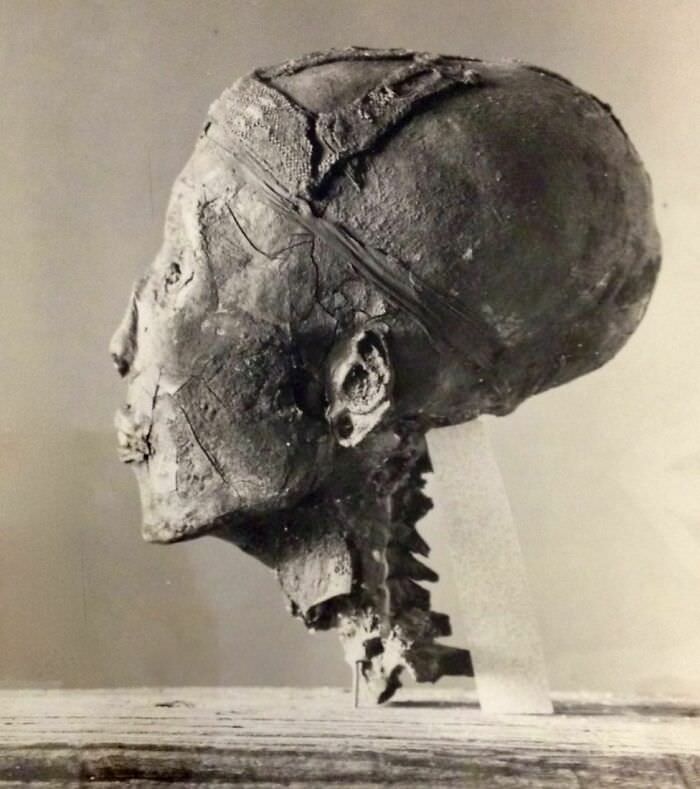
The photograph, taken by Harry Burton and published in December 1925, shows the head of Tutankhamun, an ancient Egyptian pharaoh who ruled during the 18th dynasty. The head is a part of the king's mummified body, which was discovered in 1922 by archaeologist Howard Carter in the Valley of the Kings. The photograph was taken during the excavation of the tomb, which is considered one of the most significant archaeological discoveries of the 20th century. The head is shown in intricate detail, with its distinctive features such as the elongated shape of the skull and the prominent nose clearly visible. The photograph is a testament to the artistry and skill of the ancient Egyptian civilization and their elaborate burial practices.
#84 Veronica Lake demonstrates the dangers of long hair for women war workers, 1943
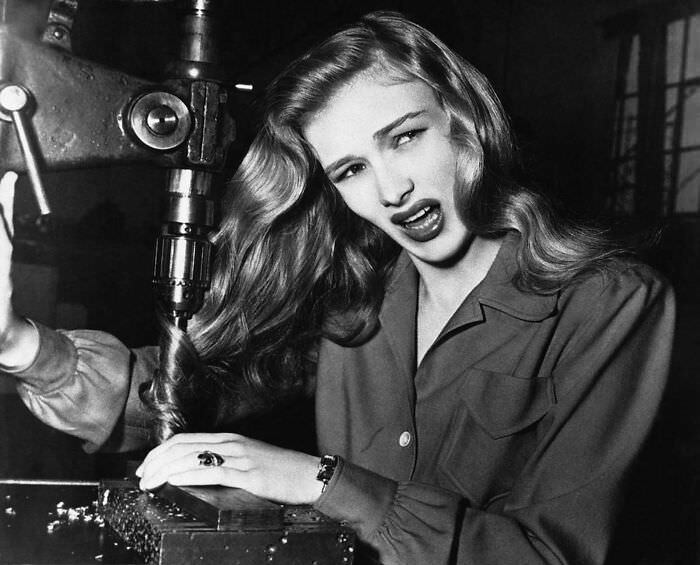
In this photograph, American film actress Veronica Lake is shown in a factory somewhere in America on November 9, 1943, demonstrating the dangers of women war workers wearing their hair long while working at their benches. During World War II, women played a significant role in the workforce, taking on jobs traditionally reserved for men who had gone off to fight in the war. However, there were safety concerns about long hair getting caught in machinery, and so posters and other materials were created to encourage women to wear their hair up or cut it short. Veronica Lake was known for her signature hairstyle, which featured her hair covering one eye, and this photo was used to illustrate the importance of safety in the workplace, even for Hollywood celebrities.
#85 Shigeru Miyamoto, Creator of Mario and Nintendo Games, with Game Boy (1992)
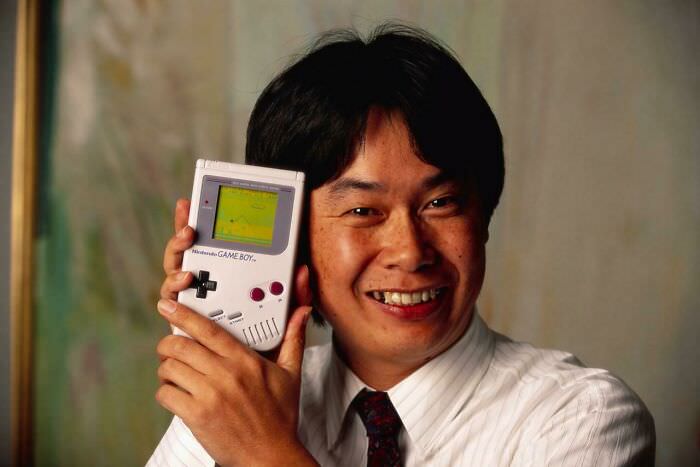
The photo shows Shigeru Miyamoto, the creator of popular video game characters such as Mario, holding a Nintendo Game Boy which contains the Super Mario World video game. The photo was taken in June 1992, during the height of Nintendo's popularity in the video game industry. Miyamoto's contributions to the industry have had a significant impact on the video game world, and his creations have become household names across the globe.
#86 Finnish soldiers in NBC gear, 1961
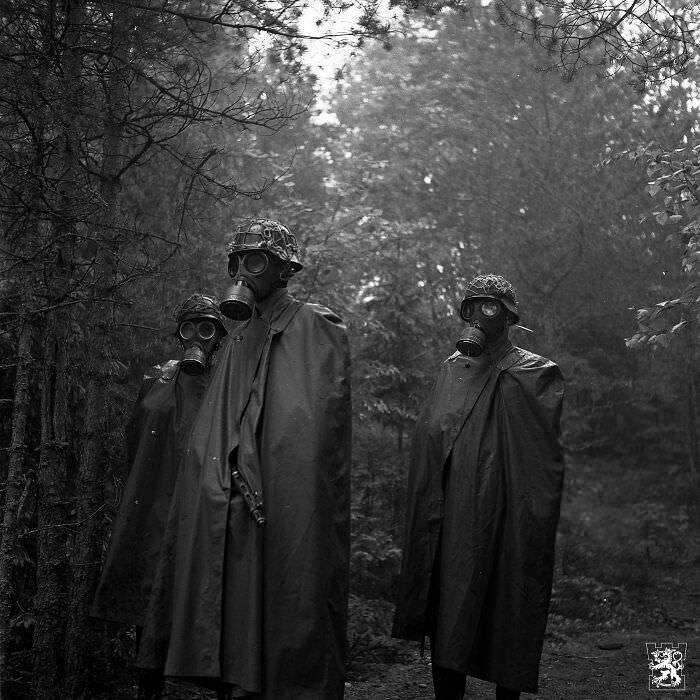
The photograph shows a group of Finnish soldiers wearing Nuclear, Biological and Chemical (NBC) gear. The soldiers are standing in a line wearing protective suits, gas masks and helmets. They are holding rifles and appear to be in a state of readiness for a potential attack. The photograph was taken in 1961, during the Cold War era when the threat of a nuclear war loomed over many countries. The Finnish military, like many other militaries around the world, conducted regular drills and training exercises to prepare for the possibility of a nuclear, biological or chemical attack.
#87 Battle Cry
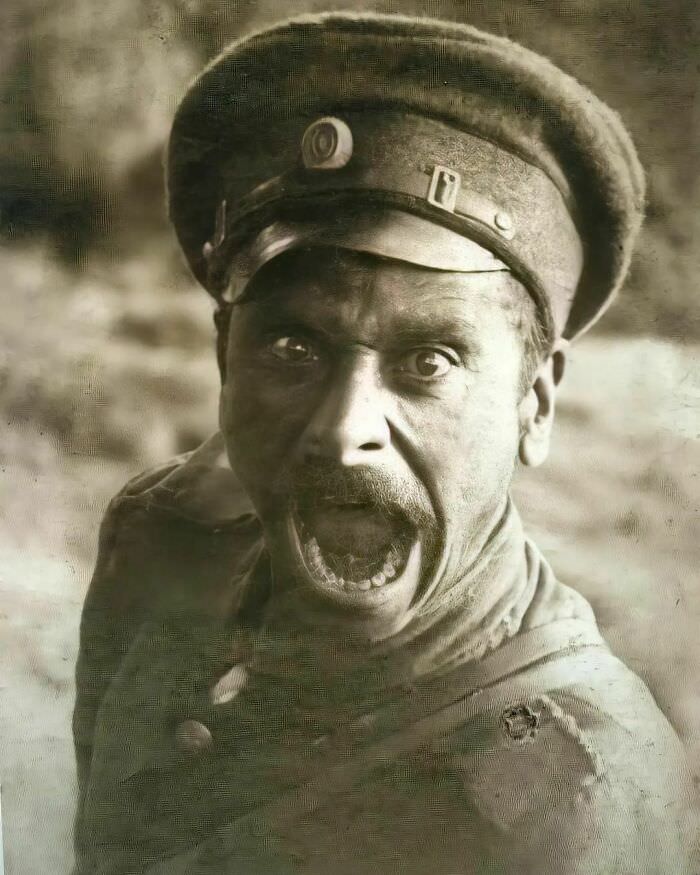
In this photograph taken around 1916, a Bulgarian soldier is captured mid-battle cry. He stands tall and fierce, with his rifle in hand and his eyes fixed on an unseen enemy. The intensity in his expression is palpable, conveying the fearlessness and determination of a soldier on the front lines of war. It's a powerful reminder of the human face of war, and the courage required to fight for one's country.
The soldier's uniform is adorned with various military badges and medals, indicating his years of service and experience in battle. His cap bears the distinctive emblem of the Bulgarian army, which fought alongside the Central Powers during World War I. Though the war brought great loss and devastation to Bulgaria and its people, this soldier's fierce spirit and bravery are a testament to the resilience of the human spirit even in the darkest of times.
#88 The Human Fly Climbs the World Trade Center
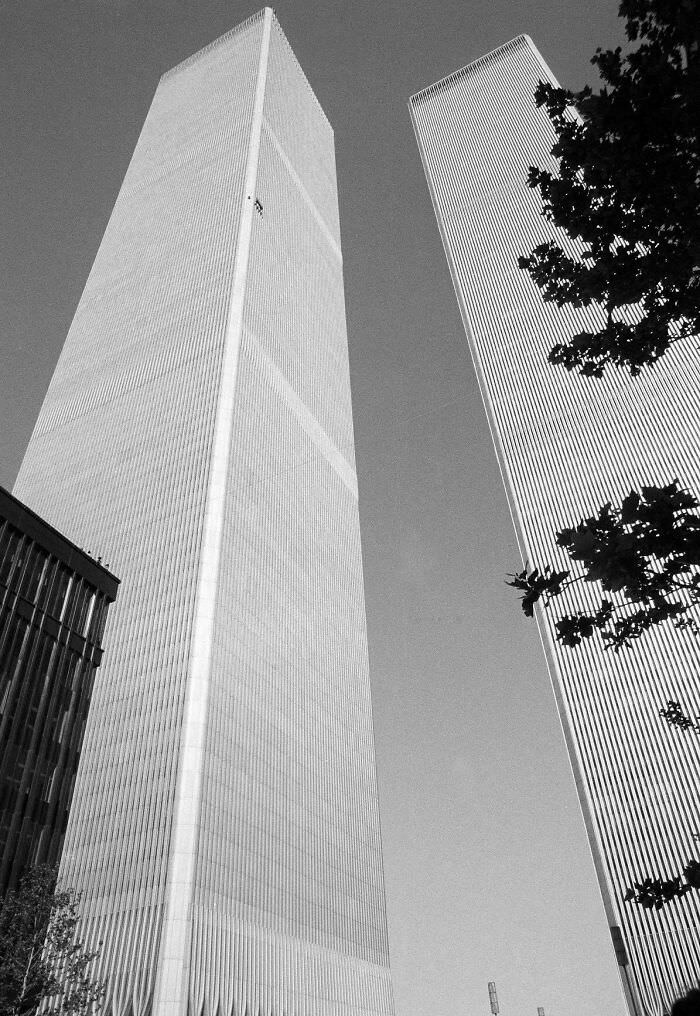
On May 26, 1977, George Willig, also known as the "Human Fly," became a sensation when he climbed the South Tower of the World Trade Center in New York City. Armed with only homemade climbing equipment and determination, Willig scaled the tower in just under four hours.
This ground view photograph captures Willig's incredible feat as he makes his way up the side of the tower, dwarfed by the massive structure. Despite the danger and the authorities' attempts to stop him, Willig successfully reached the top of the tower and was met with cheers and applause from onlookers. Willig's daring climb became a symbol of human perseverance and determination, and his name has gone down in history as a testament to what we can achieve when we set our minds to something.
#89 Hitler’s Reflection
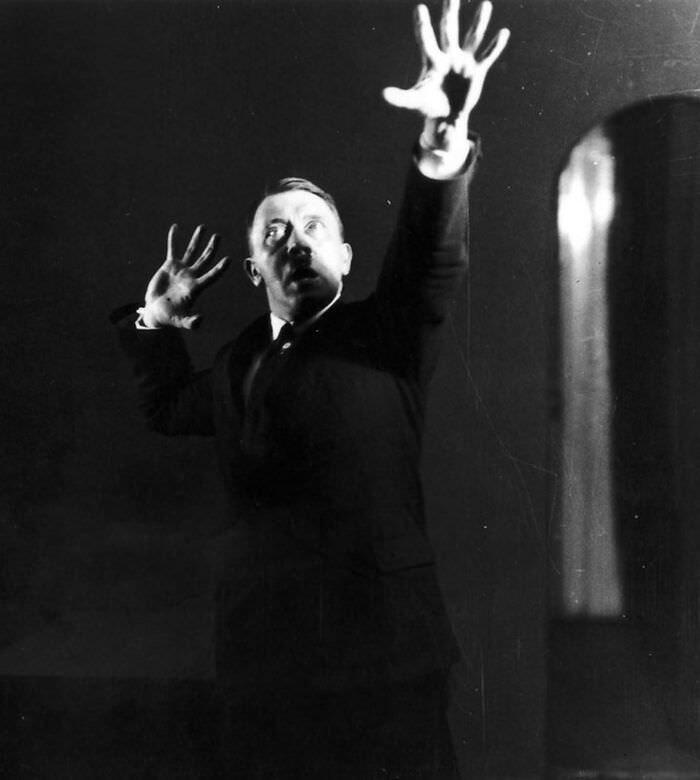
In 1925, Heinrich Hoffman, the personal photographer of Adolf Hitler, captured an intimate moment of the future dictator rehearsing a speech in front of a mirror. The photograph reveals the meticulously planned nature of Hitler's speeches, as he studies his posture, gestures, and facial expressions. It also offers a glimpse into Hitler's narcissistic personality and his obsession with controlling his public image.
Hitler's use of propaganda was a key element in his rise to power, and his speeches were carefully crafted to appeal to the emotions and fears of the German people. This photograph serves as a powerful reminder of the danger of allowing leaders to manipulate public opinion through carefully constructed messaging and image management.
#90 The Abandoned Grande Hotel of Beira, Mozambique
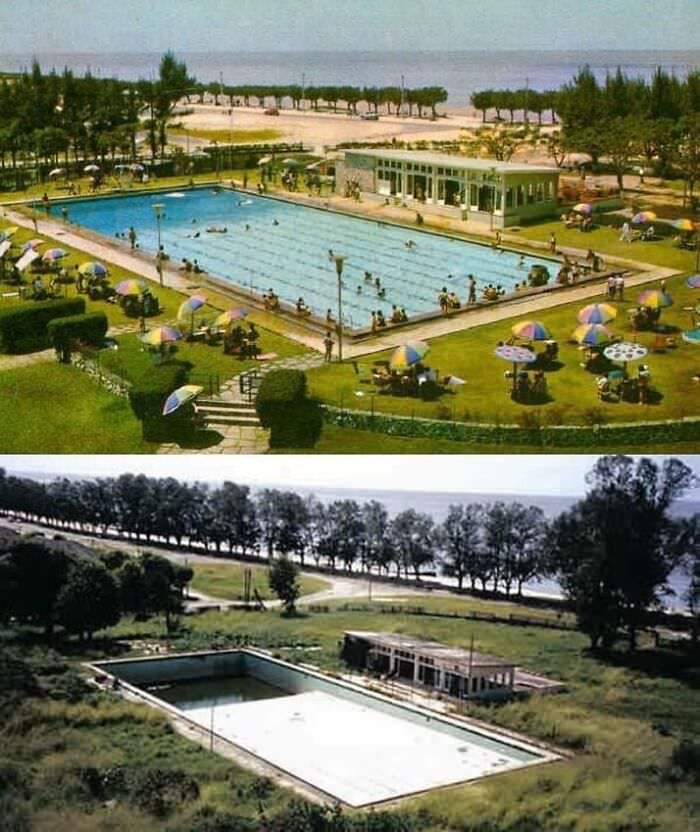
In its heyday, the Grande Hotel of Beira was the epitome of luxury and elegance, hosting some of the most influential figures in Mozambique. But after the country's civil war in the 1980s, the hotel fell into disrepair and was abandoned.
Over the years, the Grande Hotel became a symbol of the neglect and decay that plagued the city of Beira. Its once-grand halls and rooms now lie empty and crumbling, overtaken by nature and time. Despite numerous attempts to revitalize the hotel, it remains a haunting reminder of a bygone era.
Today, the Grande Hotel stands as a stark contrast to the bustling city that surrounds it. Yet, there is a certain beauty in its decay, a reminder of the complexities and contradictions of history.
#91 A Slice of Italy in New York City
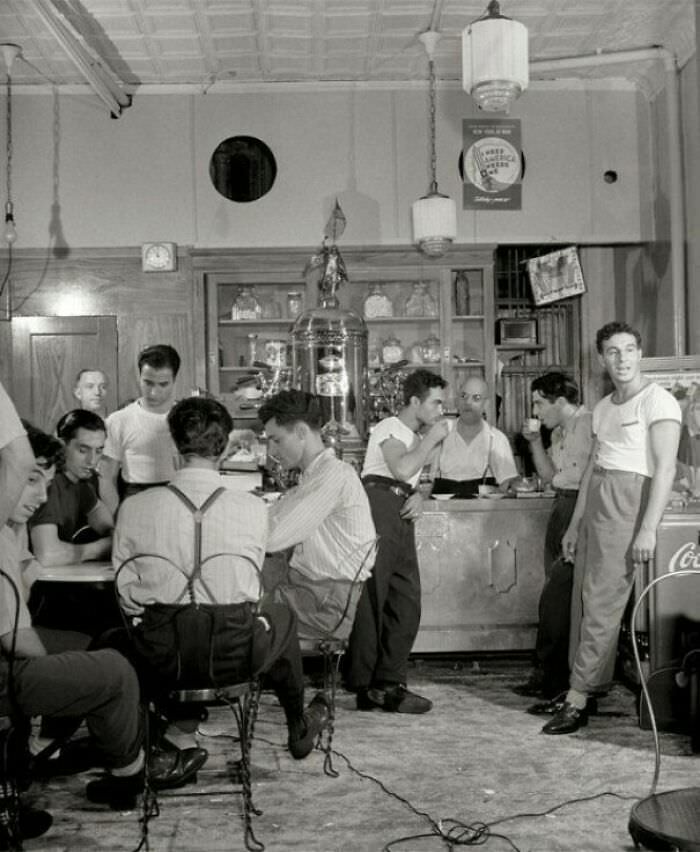
In this iconic photograph, taken by American photographer Marjory Collins in 1942, we see the bustling scene of an Italian-American cafe on MacDougal Street in New York City. The cafe is filled with patrons enjoying their meals, while outside the storefront hangs a sign advertising "Wines and Liquors". The walls are adorned with Italian-themed paintings and the tables are covered with red and white checkered tablecloths.
This image captures a moment in time when Italian immigrants and their culture were becoming more integrated into American society. The cafe serves as a symbol of the vibrant Italian-American community in New York City, a place where people could come together and celebrate their heritage while also participating in the melting pot of American culture.
#92 Racial Harassment in Delmar Village, Pennsylvania
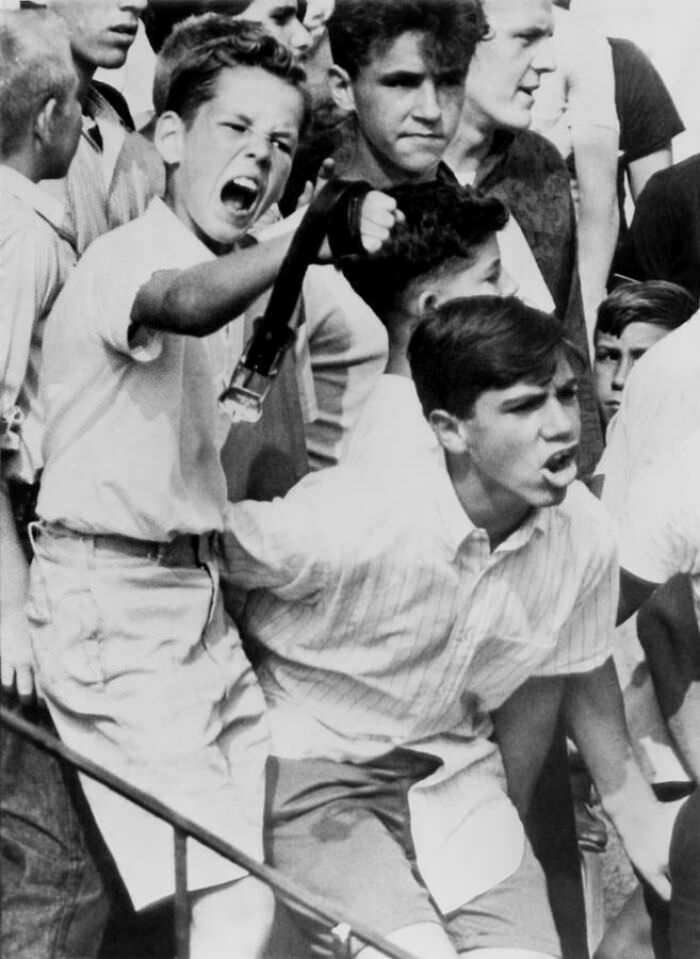
In August 1963, the Horace Baker family became the first African American family to move into the all-white Delmar Village neighborhood of Folcroft, Pennsylvania. As soon as they arrived, they were met with hostility and harassment from the white residents of the area, including young boys who are seen in this photograph harassing the family. The harassment included rock throwing, name-calling, and taunting. The situation was so bad that the family had to have police protection around the clock.
#93 Brenda Spencer’s Guilty Plea
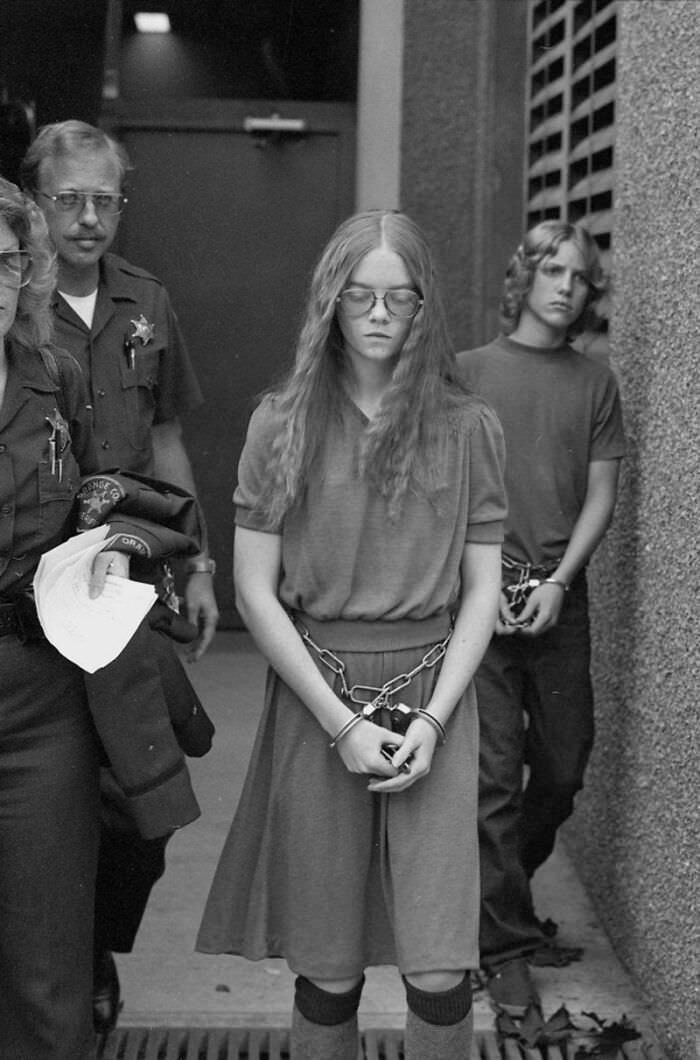
In 1979, 16-year-old Brenda Spencer carried out a horrific shooting in San Diego, California, killing two people and injuring nine others. She became known for her chilling statement to the police, "I don't like Mondays. This livens up the day," when asked about her motive.
After her arrest, Brenda Spencer pleaded guilty to two counts of murder and nine counts of assault with a deadly weapon. The photograph captures Brenda Spencer leaving court in Santa Ana, California, after pleading guilty. The shocking attack and her lack of remorse made headlines and raised questions about gun control and mental health in America. Brenda Spencer remains incarcerated to this day.
#94 Presidential Penalty: Gerald Ford and Pele Kick it in the Rose Garden
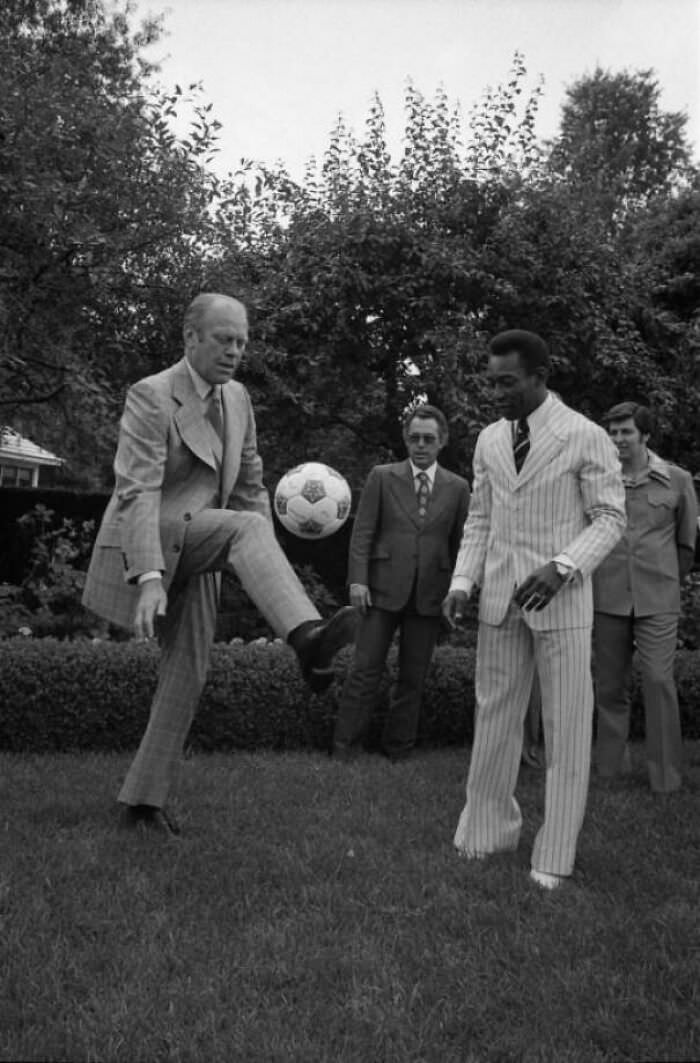
In 1975, the President of the United States, Gerald Ford, welcomed Brazilian soccer star Pele to the White House. The two then took to the Rose Garden, where they kicked around a soccer ball in front of the press. The unlikely duo's playful game of soccer became an iconic moment, symbolizing the growing popularity of soccer in the United States.
The event was part of a larger push by President Ford to promote physical fitness and encourage Americans to live more active lifestyles. It was also a chance for the President to show his support for soccer, a sport that was gaining more attention in the US, especially among young people.
The image of the President of the United States playing soccer with one of the sport's greatest players remains a memorable moment in American history, showcasing the power of sports to bring people together and bridge cultural divides.
#95 Homecoming Celebration
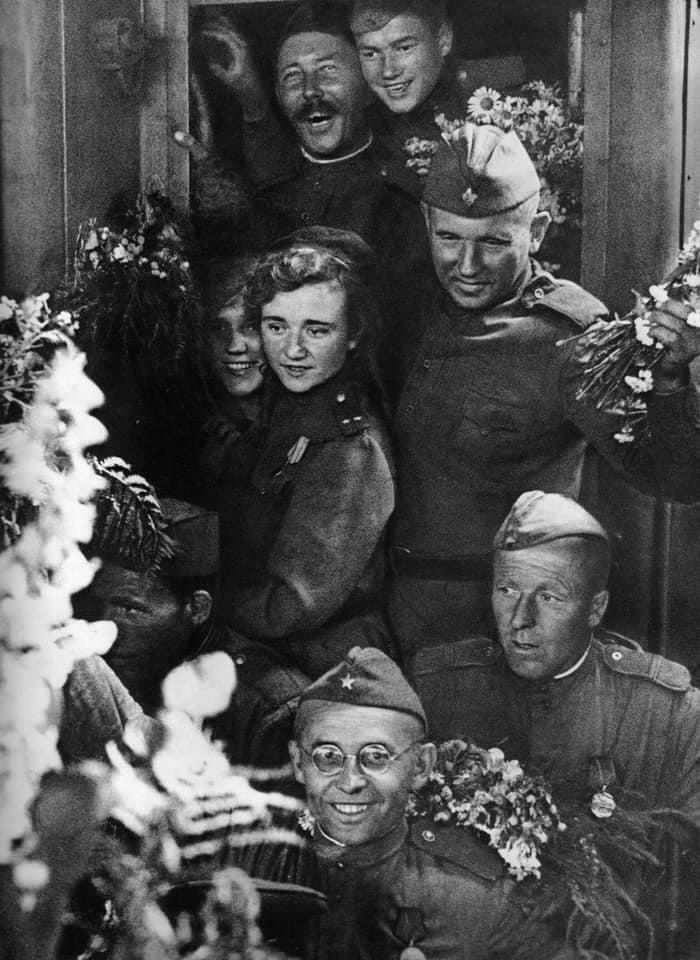
In this photo taken in 1945, Soviet soldiers can be seen celebrating their safe return home after fighting in World War II. The soldiers, dressed in their uniforms, are seen laughing, cheering and embracing each other, filled with joy at having survived the horrors of war.
The photo captures a moment of relief and gratitude felt by many soldiers who were fortunate enough to make it back home. However, it also serves as a reminder of the devastating toll that war takes on individuals and societies, and the lasting impact it can have on those who experience it.
#96 Barbara Walters in her Freshman Year at Sarah Lawrence College
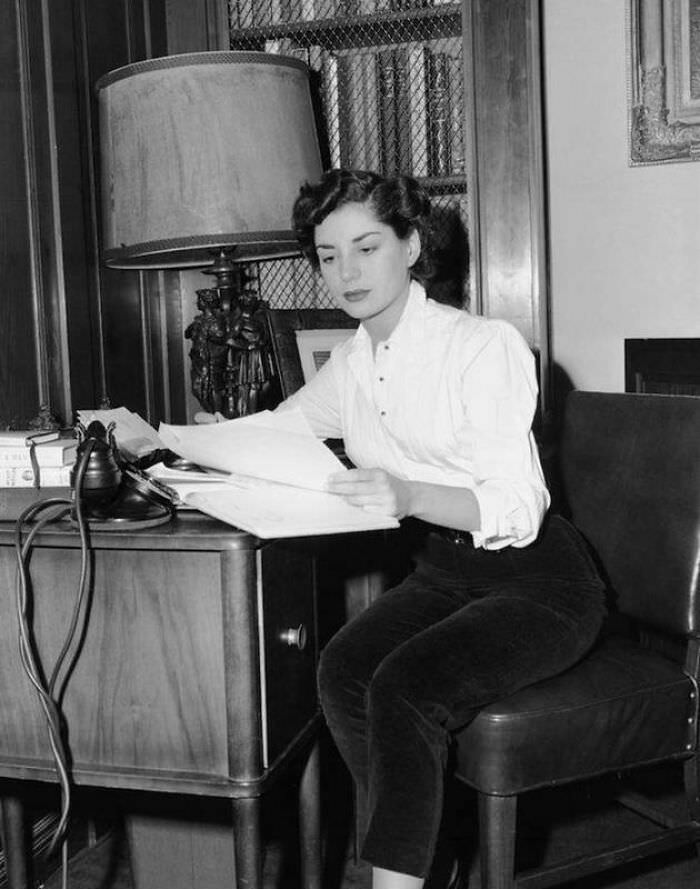
This photo captures a young Barbara Walters during her freshman year at Sarah Lawrence College in 1949. She is seen wearing a stylish coat and a matching hat, looking confidently into the camera with a smile on her face. Walters went on to become one of the most respected journalists in American television history, breaking ground as a female anchor and correspondent. Throughout her career, she has interviewed some of the most influential figures of her time, including heads of state, celebrities, and newsmakers.
#97 Exercise on board the RMS Titanic
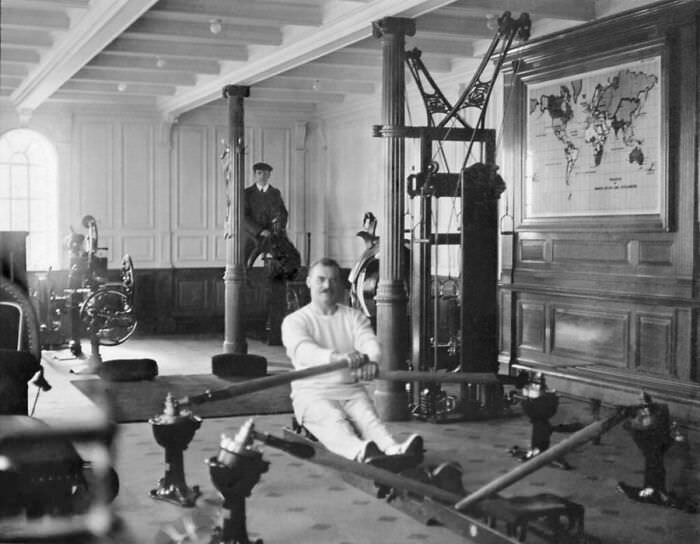
This photograph captures a man exercising on a rowing machine in the gym aboard the RMS Titanic, a luxury passenger liner that famously sank on its maiden voyage in 1912. The gym was located on the Titanic's lower deck and featured a variety of exercise equipment including rowing machines, weights, and stationary bicycles. Despite the limited space, the gym was a popular spot for first-class passengers to stay active during the voyage. The man in the photograph appears to be fully immersed in his workout, perhaps unaware of the tragedy that would soon befall the ship. The image provides a glimpse into the leisure activities available to Titanic passengers during their fateful journey.
#98 Emperor Bokassa the First’s Lavish Coronation
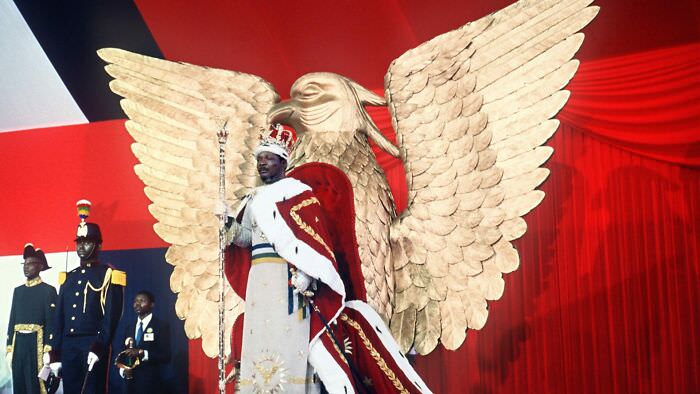
In 1977, Jean-Bedel Bokassa, the military dictator of the Central African Republic, staged a lavish coronation ceremony to crown himself Emperor Bokassa the First. The event was a display of Bokassa's wealth and power, as he spared no expense in the ceremony, which reportedly cost a third of the country's entire annual budget.
The event was attended by many foreign dignitaries and featured ornate costumes, military parades, and a 5,000-person banquet. Bokassa even wore a crown made of solid gold and diamonds.
Despite the grandeur of the event, Bokassa's reign as emperor was short-lived, as he was overthrown in a French-led coup in 1979. The coronation remains a controversial and notorious event in the history of the Central African Republic.
#99 Controversial Sports Prize
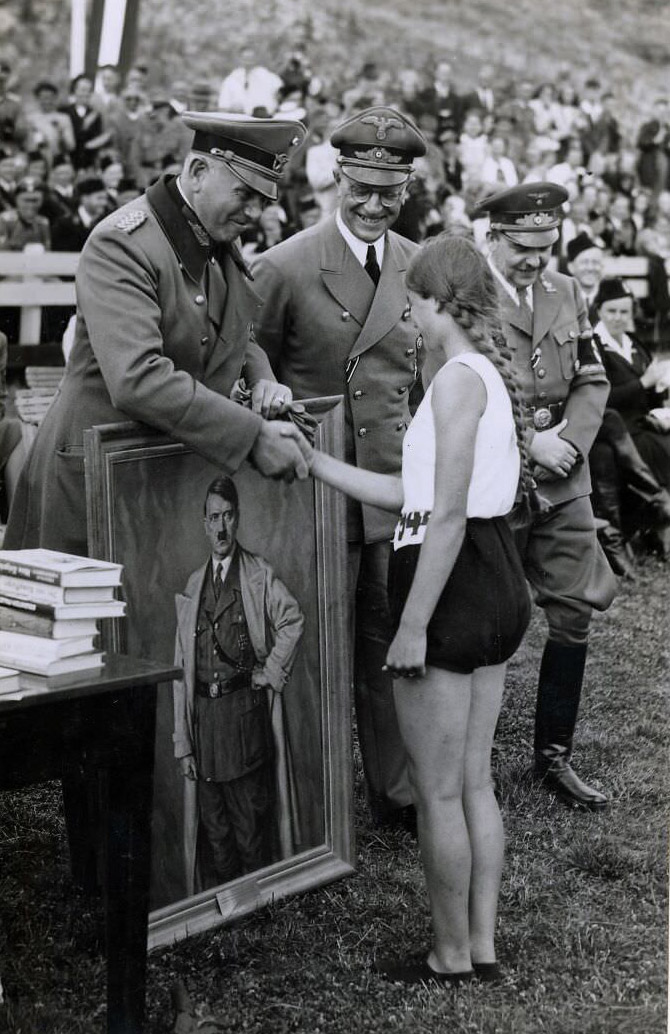
In this photograph, a Dutch athlete can be seen receiving a portrait of Adolf Hitler as a sports prize from General Otto Schumann, commander of the Ordnungspolizei. The photograph was taken in The Hague, the Netherlands in 1941 during the German occupation of the country.
During the Nazi occupation, sports events were often used as a means of propaganda to promote the idea of Aryan superiority. The awarding of a portrait of Hitler to a Dutch athlete caused controversy and was seen as an attempt to indoctrinate the Dutch population into Nazi ideology.
#100 Captain Harry S. Truman in WWI
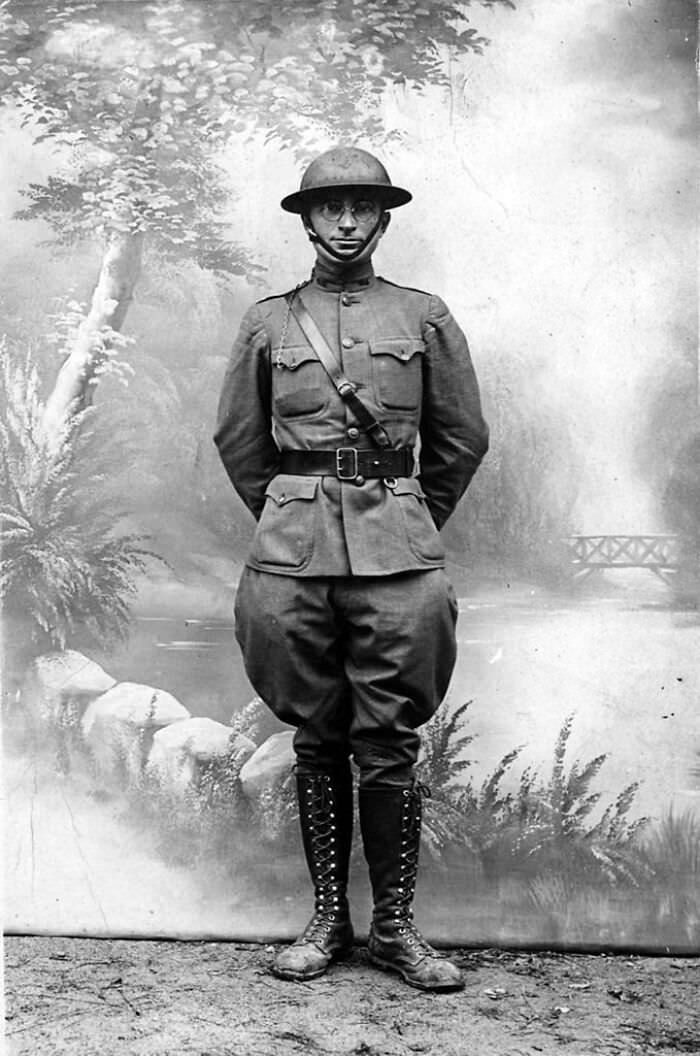
In this photograph, we see a young Harry S. Truman during his service as a captain in World War I. Truman, who would later become the 33rd President of the United States, served in France as an artillery officer during the war. Despite being initially trained as a field artillery captain, he was later transferred to a battery that used the French 75mm gun, a weapon known for its accuracy and rapid firing rate. Truman was responsible for leading his men through some of the deadliest battles of the war, including the Meuse-Argonne offensive, which ultimately led to the defeat of Germany. Truman's experiences during the war would shape his leadership style and political philosophy in the years to come.
#101 Soviet Rock Fans Celebrate the End of an Era
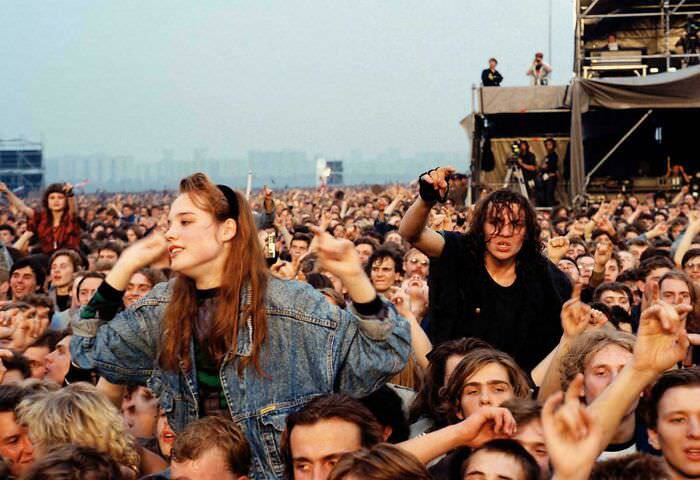
In this iconic photograph, taken in Moscow on September 28, 1991, we see Soviet rock fans attending a concert to celebrate the end of an era. The Soviet Union was on the verge of collapse, and the concert was seen as a celebration of newfound freedoms and the end of Soviet censorship. The concert, featuring several of the country's biggest rock stars, was held in an airfield in front of an estimated half-million people.
The concert was organized as a gift to Russian youth for their role in resisting the August coup, which had attempted to overthrow the Soviet government. The event was a turning point in Russian history, signaling the end of Soviet power and the beginning of a new era of openness and democracy.
#102 Spring Break in California, 1947
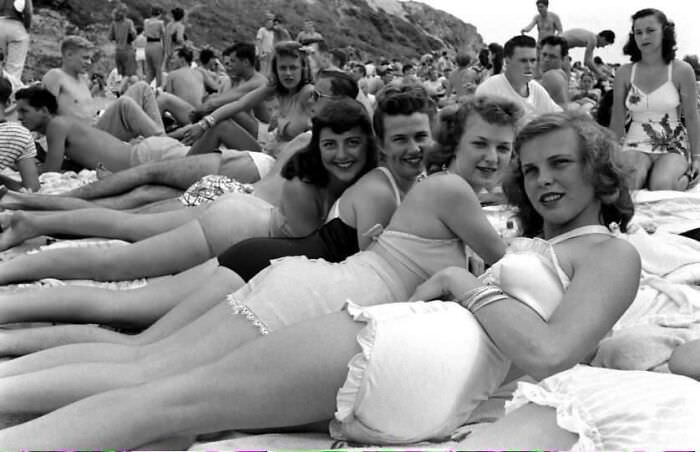
This photo captures the spirit of youthful freedom and joy during the post-war era in America. The young men and women in the photo are enjoying their spring break in Santa Monica, California in 1947. They are carefree and full of energy as they splash in the ocean and soak up the sun on the beach. The photo represents a time of optimism and prosperity in America after the hardships of World War II. The fashion and style of the young people in the photo reflect the trends of the time and give us a glimpse into the youth culture of the era.
#103 Clinton-Lewinsky Affair
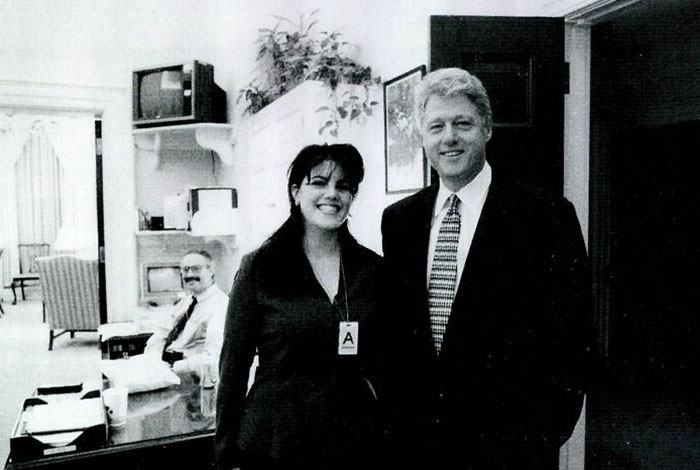
In 1998, a scandal erupted involving President Bill Clinton and White House intern Monica Lewinsky. A photograph of the two together began to circulate, fueling rumors of an affair. The allegations were eventually confirmed, and Clinton became only the second U.S. president to be impeached.
The photo in question shows Clinton and Lewinsky standing together in a crowded room, with Clinton's arm around her waist and Lewinsky beaming with a wide smile. It became a symbol of the controversy that would follow, with both individuals facing public scrutiny and criticism.
#104 J.K. Rowling at the Café
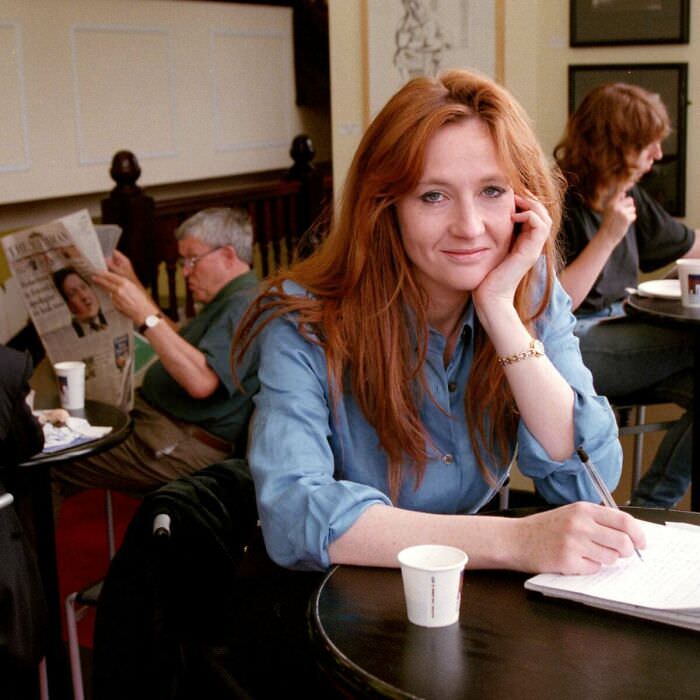
In this iconic photograph taken in 1998, we see J.K. Rowling hard at work, writing the fourth book in the Harry Potter series, "Harry Potter and the Goblet of Fire". Rowling is seen sitting at a cozy corner table in a café in Edinburgh, Scotland. The café, called The Elephant House, has become a popular tourist destination for fans of the Harry Potter series, as it is known as the place where Rowling spent countless hours writing her beloved books.
The photograph captures a poignant moment in time, as Rowling's life was about to change forever with the success of her books. Her dedication to her craft and determination to succeed is evident in the photograph, as she sits with her notebook and pen, lost in thought and focused on the task at hand.
#105 Theodore Roosevelt’s Temporary Grave in Normandy
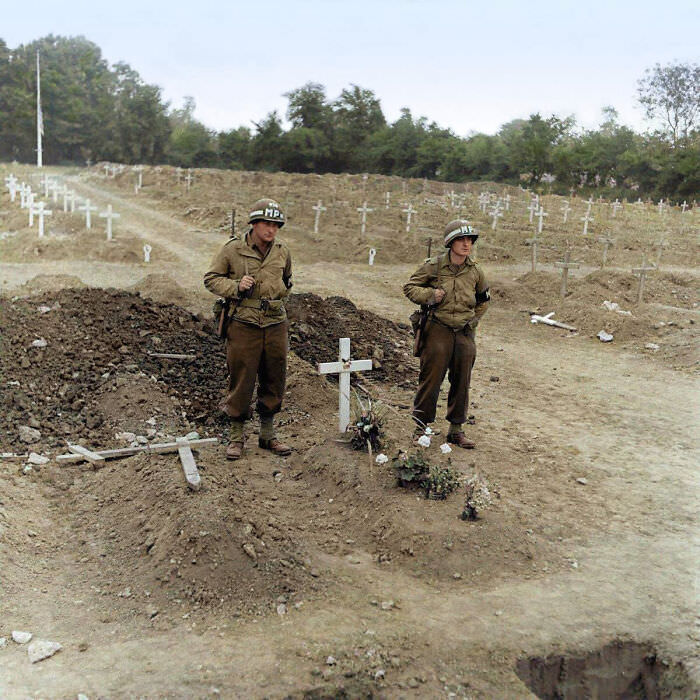
On July 12, 1944, former President Theodore Roosevelt died of a heart attack at his home in Oyster Bay, New York. His death occurred just weeks after the Allied invasion of Normandy, France during World War II. As a sign of respect, Roosevelt's body was temporarily buried in Normandy, close to where American troops had landed. This photo captures the temporary gravesite, adorned with flowers and an American flag. Roosevelt, known for his adventurous spirit and conservation efforts, was widely mourned by the American public. In January 1946, his remains were moved to their final resting place at the family cemetery in Youngs Memorial Cemetery, New York.
#106 Forced haircut during South Korea’s crackdown on long hair
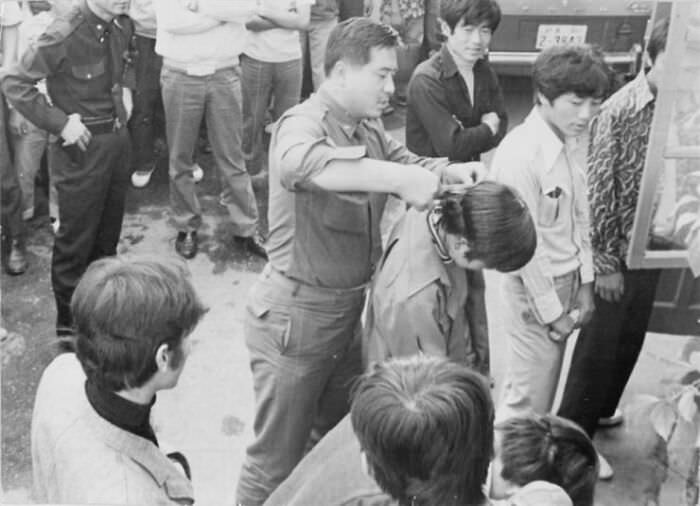
In the 1970s, the South Korean government implemented a strict crackdown on men with long hair and women wearing short skirts, deeming it a symbol of Western decadence. This photo shows a South Korean soldier forcibly cutting the hair of a young man in front of others, as a form of punishment. The crackdown was a part of President Park Chung-hee's campaign to promote traditional Korean values and culture. Many young people resisted the campaign, seeing it as an infringement on their freedom of expression. The crackdown continued until the late 1970s, and remains a controversial part of South Korean history.
#107 Defiant Until the End
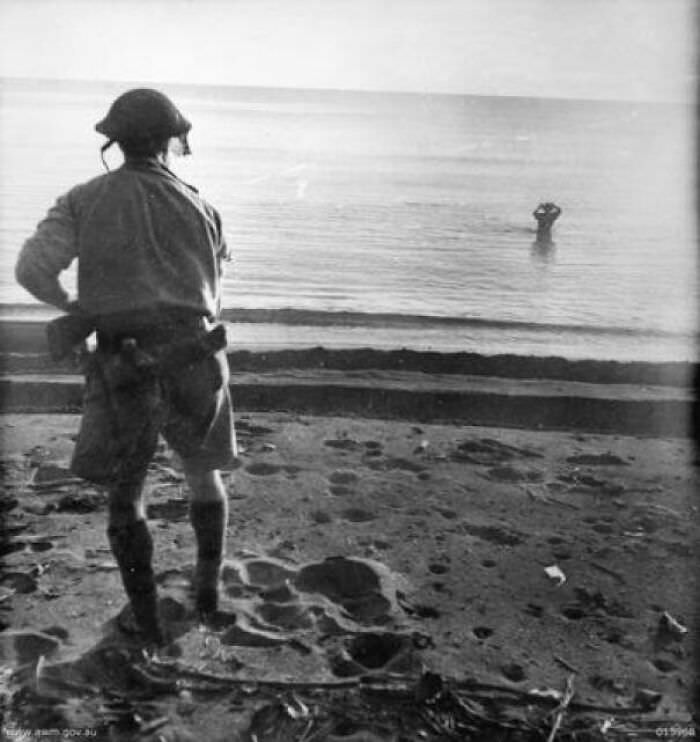
In this haunting photo taken during World War II, a Japanese soldier can be seen wading into the sea with a grenade held against his head. The soldier is said to have been at Cape Endaiadere in New Guinea and was surrounded by Australian troops who called on him to surrender. However, the soldier was determined to die rather than be captured, and he chose to take his own life by pulling the pin on the grenade. The photographer captured this moment, showing the soldier's sheer determination and bravery in the face of certain death.
#108 Arctic Explorer and His Polar Bear Coat
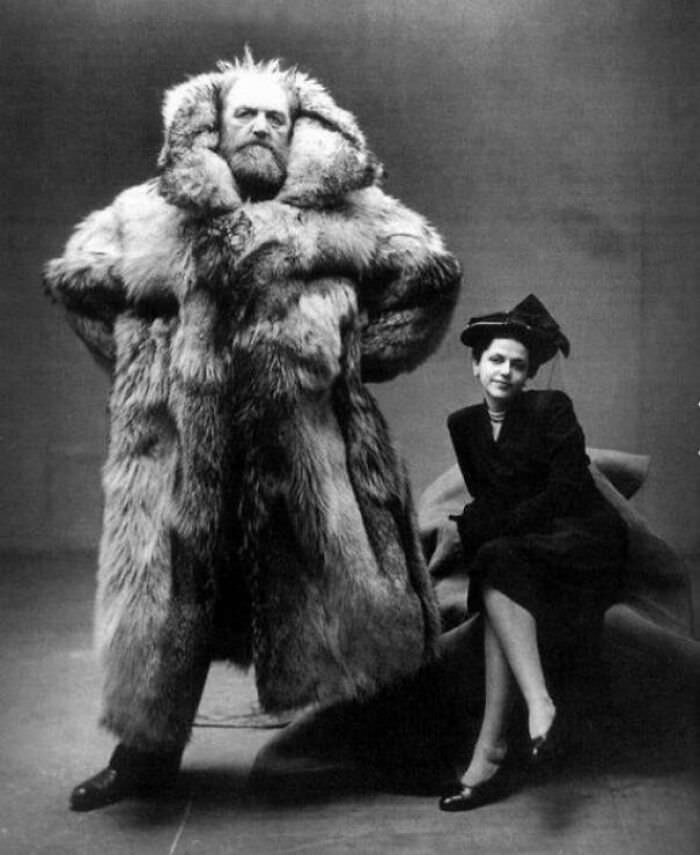
Peter Freuchen, a Danish explorer and author, was a true adventurer who made several expeditions to the Arctic. In 1947, a photograph was taken of Freuchen standing next to his third wife, Dagmar Freuchen-Gale, while wearing a polar bear coat made from a bear he had killed himself. The coat was made from the skin of a polar bear that he had hunted while on one of his expeditions. The photograph captures the grit and determination of a man who lived a life of adventure and danger. Freuchen's polar bear coat became an iconic symbol of his life as an Arctic explorer and a reminder of the harshness of the environment in which he thrived.
#109 Anti-Axis Committee Office, 1941
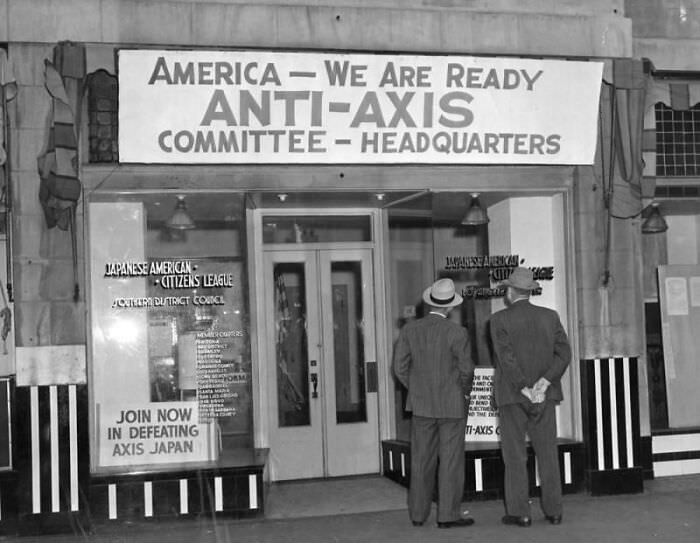
Following the attack on Pearl Harbor, Japanese-Americans in the United States faced severe discrimination and racism due to their ancestry. In response, the Japanese-American Citizens League opened the Anti-Axis Committee Office on December 14, 1941, just a week after the attack. The office was created as part of a campaign to demonstrate the loyalty of American-born Japanese citizens to the United States and to combat anti-Japanese sentiment. The committee organized volunteer efforts and fundraising drives to support the American war effort, and advocated for the rights of Japanese-Americans during a time of intense prejudice and discrimination. The Anti-Axis Committee Office was a symbol of resistance and perseverance during a difficult time in American history.
#110 Nelson Mandela at a South African Communist Party Rally
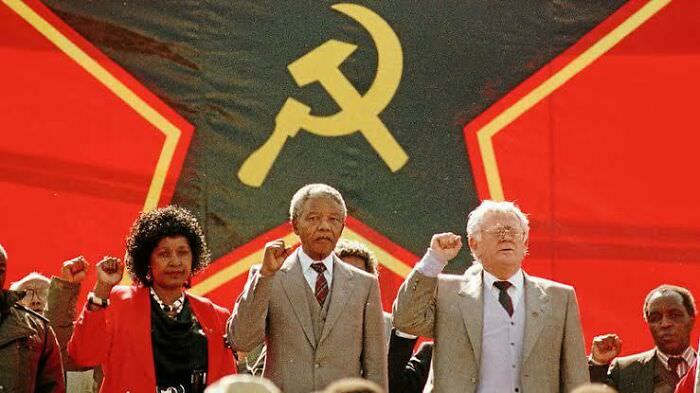
This photograph captures an iconic moment in South African history. It was taken in Soweto in 1990, just months after Nelson Mandela was released from prison after 27 years. In the photograph, Mandela can be seen addressing a crowd at a South African Communist Party rally. This was a significant moment, as the Communist Party had been banned in South Africa for many years, and Mandela had been labeled a terrorist by the apartheid government.
Mandela's appearance at the rally was a powerful symbol of his commitment to social justice and his willingness to work with all political groups to bring about a new, democratic South Africa. Mandela was a member of the African National Congress (ANC), but he recognized the importance of alliances with other groups in the fight against apartheid. The photograph captures the hope and excitement of that moment, as South Africans of all backgrounds came together to celebrate the end of apartheid and the beginning of a new era in their country's history.
#111 One of the last glimpses of President Andrew Jackson
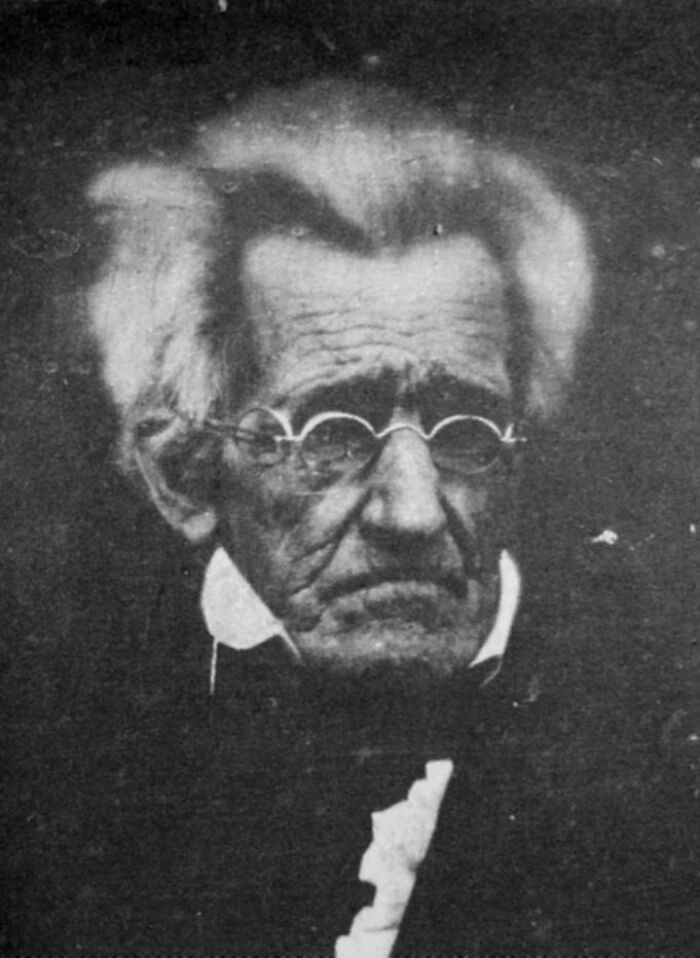
This photograph, taken in 1845, captures one of the last glimpses of former President Andrew Jackson, who died later that year at the age of 78. Jackson was a larger-than-life figure in American history, having served as the seventh President of the United States from 1829 to 1837. He was known for his populist views, his opposition to a powerful central bank, and his controversial Indian removal policies, which resulted in the forced relocation of Native American tribes from their ancestral lands in the southeastern United States.
The photograph itself is a rare artifact, as photography was still a relatively new technology in the mid-1800s. The image shows Jackson seated in a chair, wearing a dark suit and holding a cane. His expression is stern, perhaps reflecting the many challenges he faced during his long career in public service.
#112 An Unlikely Encounter: Hitler and Wittgenstein
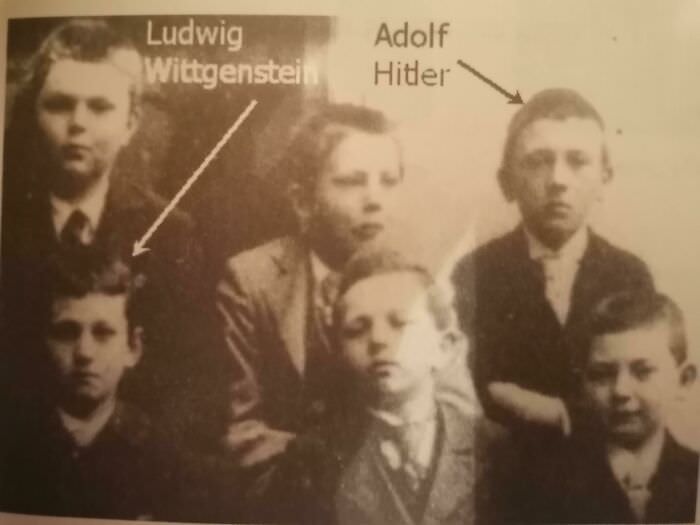
In 1903, a teenage Adolf Hitler and philosopher Ludwig Wittgenstein attended Realschule in Linz, Austria. Although they were both enrolled in the same school, their paths likely never crossed. However, a photograph from that year shows a young Hitler and Wittgenstein standing next to each other, with Wittgenstein towering over the future dictator.
The photograph is a curious glimpse into history, showing two figures who would go on to have vastly different impacts on the world. Wittgenstein, one of the most influential philosophers of the 20th century, would later renounce his Austrian citizenship and fight for the British during World War I. Hitler, on the other hand, would become one of the most infamous figures in history, responsible for the deaths of millions during World War II.
#113 Steven Spielberg and Jeff Goldblum Open Jurassic Park: The Ride
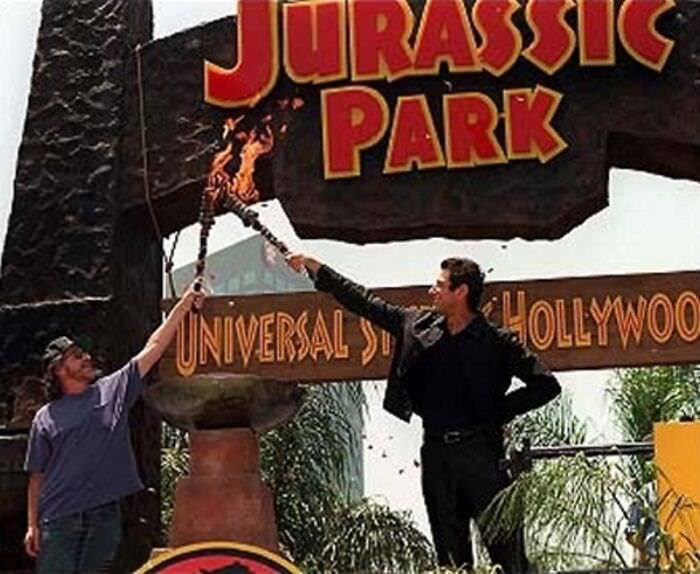
On June 21, 1996, Steven Spielberg and Jeff Goldblum attended the grand opening of the Jurassic Park: The Ride at Universal Studios Hollywood. The ride was based on Spielberg's hit 1993 film Jurassic Park and featured a thrilling water ride through a world of dinosaurs. Spielberg and Goldblum were on hand to light the ceremonial torches and officially open the ride. Fans of the film and theme park enthusiasts alike were eager to experience the excitement of the ride, which quickly became one of the most popular attractions at Universal Studios. Even today, years after the ride's initial opening, it remains a beloved and iconic part of the park.
#114 President Lyndon B. Johnson Takes a Drive on his Amphicar
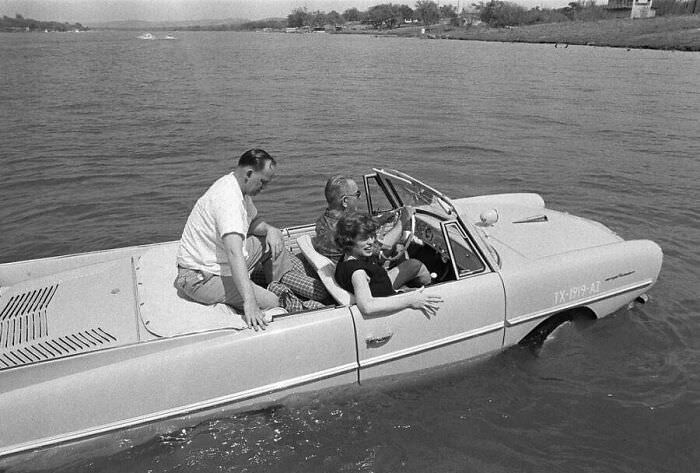
In 1965, President Lyndon B. Johnson made headlines for his unconventional mode of transportation on the lake of his Texas ranch. He took his amphibious car, known as the Amphicar, for a spin on the water, much to the surprise of the press and his Secret Service detail. The Amphicar was designed to be driven on land as well as water, and Johnson saw it as a way to entertain guests and also be able to quickly escape from the ranch in the event of an emergency. Johnson's love for the Amphicar was well-known, and he often enjoyed giving rides to his guests on the lake.
#115 Lenin and Bogdanov Play Chess on Capri
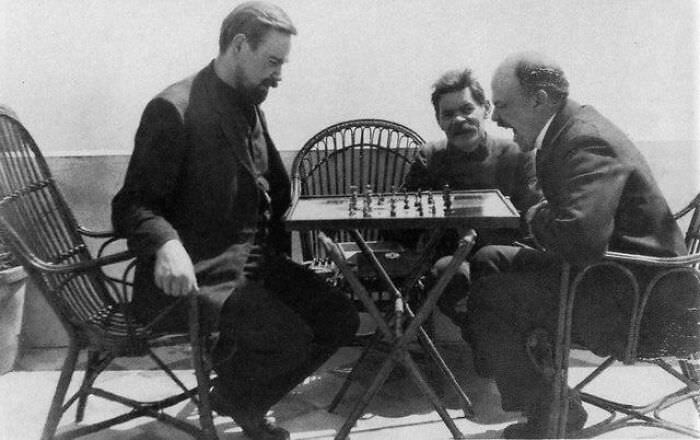
In 1908, Vladimir Lenin visited Maxim Gorky on the Italian island of Capri. During his stay, Lenin was known to engage in intense political discussions and intellectual debates with his comrades, including Alexander Bogdanov. However, in a rare moment of leisure, Lenin and Bogdanov played a game of chess, with Lenin shouting "checkmate" in triumph. The image captures a rare glimpse of the revolutionary leader in a relaxed setting, away from the intense political struggles that dominated his life.
#116 Soviet helicopter flies past the Buddha of Bamiyan
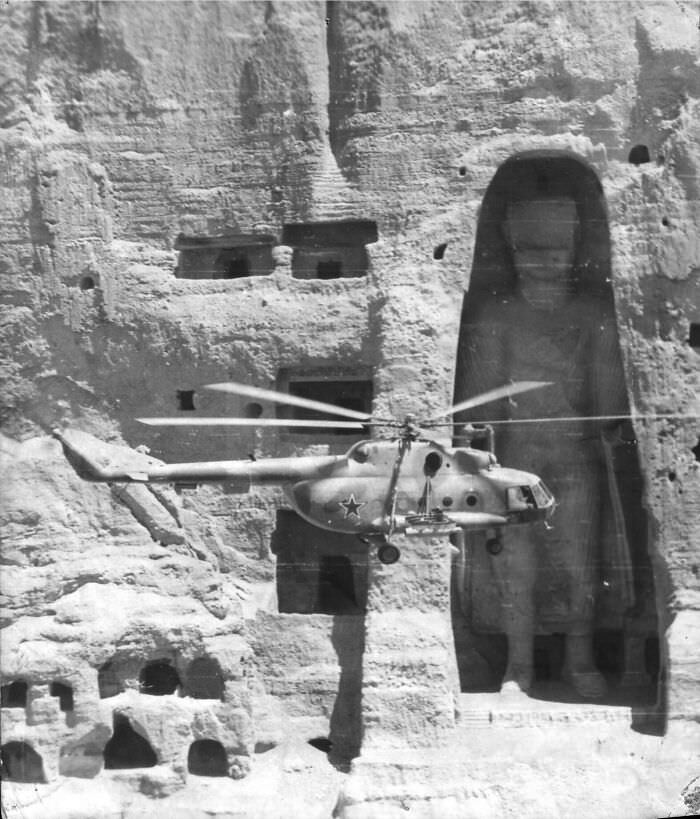
In 1980, a Soviet MI-8 helicopter flew past one of the two iconic Buddha statues in Bamiyan, Afghanistan. The statues, carved into the cliff face in the 6th century, were a testament to the country's rich cultural history. However, their existence was threatened during the Soviet-Afghan War when the Soviets used the site as a military base.
The helicopter in the photo was likely part of the Soviet military presence in the area. It flew past the Buddha, dwarfed by its size, as a reminder of the conflict between the Soviet Union and Afghanistan. In 2001, the Taliban destroyed the Buddhas, sparking international outrage and underscoring the ongoing violence and instability in the region.
#117 Public Shaming in France after WWII
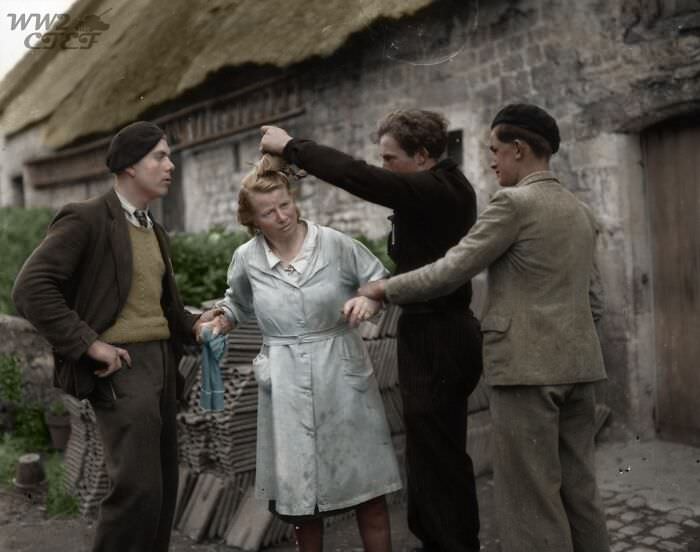
In this powerful image captured in 1945, two French men are restraining a woman accused of collaborating with the Germans during the occupation. Another man is cutting off her hair in a public shaming ritual that was common at the time. This practice, known as "tondues" or "the shorn ones," was a way for women who were suspected of having relationships with German soldiers or helping the enemy to be punished and publicly humiliated. The act of cutting off their hair was a symbol of their disgrace and was meant to serve as a warning to others. The practice was controversial, and many women were falsely accused or were victims of vigilante justice.
#118 Jackie and Ari: A New Love Story
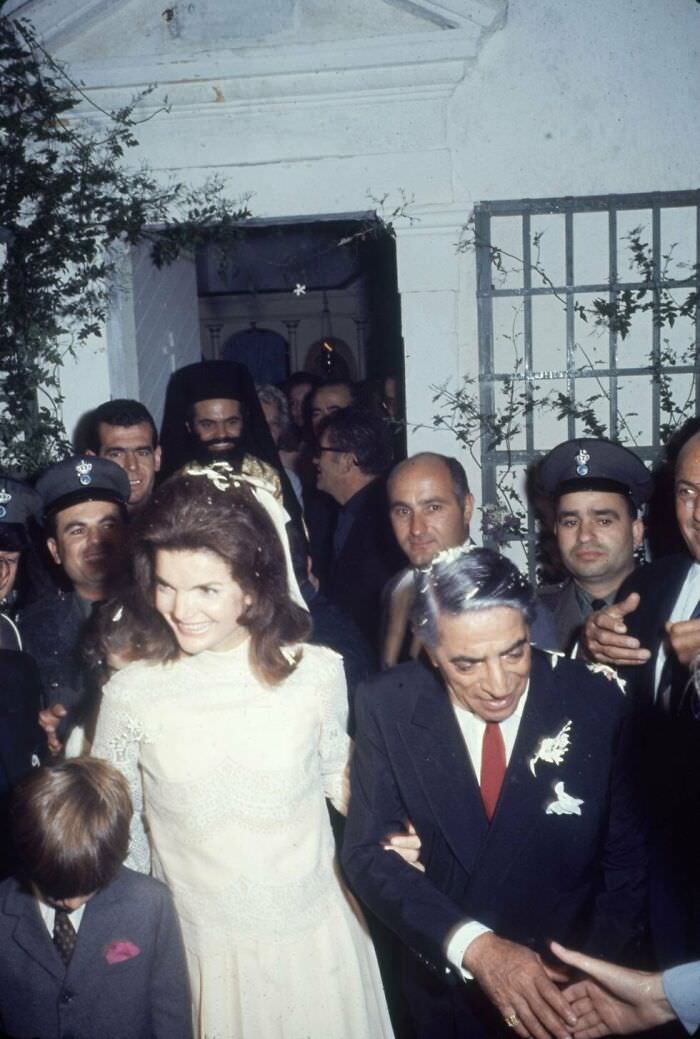
On October 20, 1968, former First Lady Jacqueline Kennedy married Greek shipping magnate Aristotle Onassis on the island of Skorpios in Greece. The wedding was a private affair, attended by only family and close friends. Jackie, still mourning the loss of her husband, President John F. Kennedy, found comfort in Onassis, who was known for his wealth, charm, and extravagant lifestyle. The marriage caused controversy and criticism, with some accusing Jackie of abandoning the Kennedy legacy and others accusing Onassis of using her for his own social status. Nevertheless, the couple remained together until Onassis's death in 1975, and their relationship has remained a subject of fascination for decades.
#119 Nixon in China
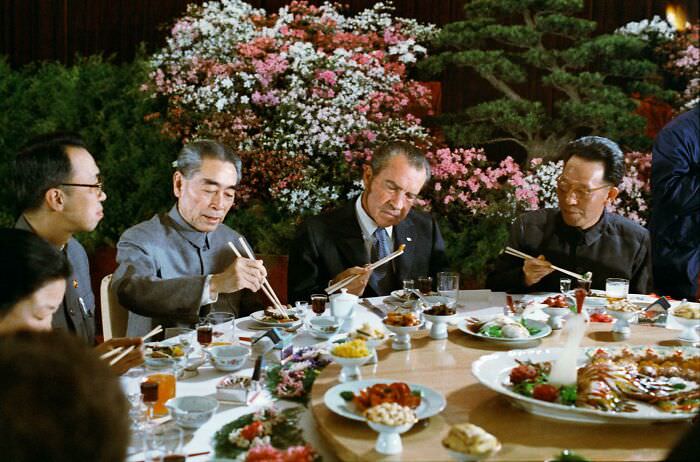
In February 1972, President Richard Nixon made a historic trip to Beijing, becoming the first U.S. president to visit China since the country's Communist revolution in 1949. The visit signaled a major shift in U.S. foreign policy and marked the beginning of a new era in U.S.-China relations. While in China, Nixon met with Chinese leaders, including Mao Zedong and Premier Zhou Enlai, and toured the country. This photo shows Nixon dining with Chinese leaders, including Zhou Enlai, at the Great Hall of the People in Beijing. The visit was seen as a breakthrough in relations between the two countries and paved the way for future diplomatic and economic cooperation.
#120 Turkish Military Exercises against Chemical Attack
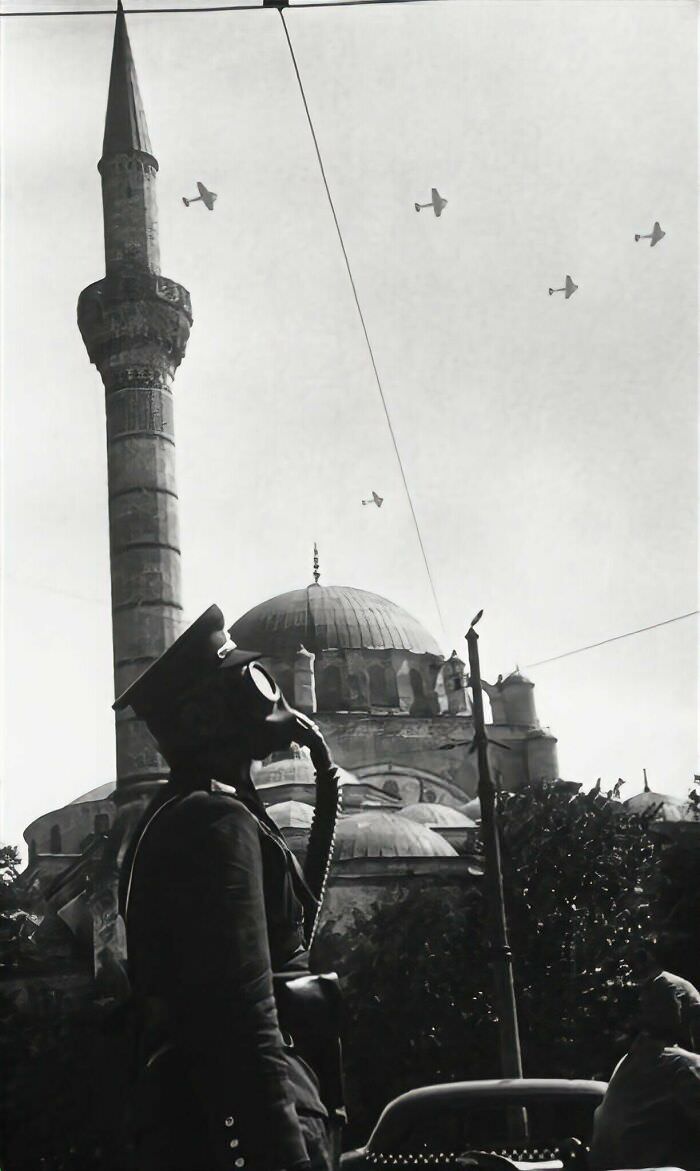
This was taken in 1939, captures Turkish soldiers participating in a military exercise in Istanbul to prepare for the threat of chemical attack. The soldiers are seen wearing gas masks and protective gear as they move through the city streets. In the foreground, a group of soldiers are marching forward while others are seen standing at attention, rifles at the ready. This image reflects the heightened tensions and fears of chemical warfare during the buildup to World War II, as countries around the world prepared for potential attacks.
#121 The Mask Mandate
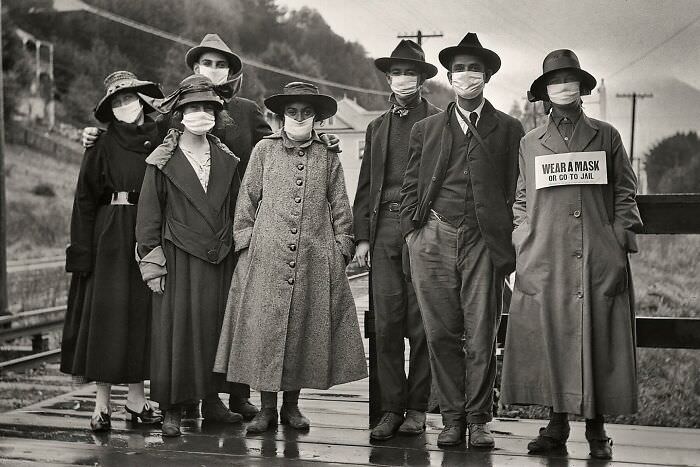
In 1918, the Spanish Flu swept across the world, infecting millions and killing hundreds of thousands of people. To help stop the spread of the disease, public health officials recommended the use of masks to be worn in public places. In California, masks became mandatory in some cities, including San Francisco, and those who refused to wear them were threatened with fines and even imprisonment. This photo, taken during the pandemic, shows a group of rail commuters in California wearing white protective masks, with one even having the message "wear a mask or go to jail" painted on it.


